Newtown is the largest town in Montgomeryshire and lies on the River Severn in the community of Newtown and Llanllwchaiarn. The origins of the town date back to the end of the 13th century, although its heyday was in the 18th and 19th centuries, when the town prospered around the growth of the textile and flannel industry, which was stimulated by the completion of the Montgomeryshire Canal. The Cambrian Mills, which opened in 1856, were the first steam-driven mills in Newtown and stood beside the canal terminus on the east bank of the Severn. The men and women of the community who fell during both World Wars are commemorated on the Newtown and Llanllwchaiarn Cenotaph, which is situated on the junction of the A483 (New Road) and Shortbridge Street. The cenotaph takes the form of a plain cenotaph on a three stepped base set in small memorial garden, with a Sword of Sacrifice positioned on its front face. The inscriptions of the fallen are engraved on all its faces and commemorate some 174 men and women who fell during the Great War and 42 men and women who fell during the Second World War. This page commemorates the fallen of the Great War.
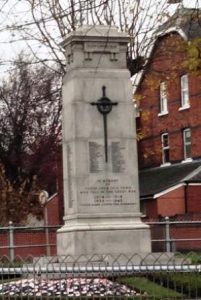
The Great War, 1914-1918
Edward Alfred Astley, Private, 15714, South Lancashire Regiment. Edward was the son of Thomas and Annie Astley, of Bryn Street, Newtown. He left home as a young man and found work as a shop assistant at Walmsley, Lancashire. Edward enlisted at Warrington into the South Lancashire Regiment on 4 November 1914 and was posted to the Depot before being posted to the 6th Battalion, South Lancashire Regiment. The battalion was at Tidworth attached to 38 Brigade, 13th (Western) Division, but in January 1915 moved to Winchester, before moving to Blackdown in February to complete its training. On 7 June 1915 orders were received to prepare to move to the Mediterranean and on 13 June the Division sailed for Alexandria, moving to Mudros before being landed at Cape Helles, Gallipoli from 6 July 1915, relieving the 29th Division. The Division then left Cape Helles, returning to Mudros before landing at Anzac Cove from 3 August and joined the Anzac offensive, which was a planned diversion to draw Turkish attention away from the main landings at Suvla Bay. The 6th South Lancs took part in an assault on the heights of Sari Bair on 9 August, capturing the ridge, but suffering heavy losses. Edward was killed in action at Sari Bair that day, 9 August 1915. The 26-year-old has no known grave and is commemorated on the Helles Memorial, Gallipoli. One of his brothers, Thomas Frederick Astley, also fell, whilst another brother, John Seymour Astley, was awarded the Distinguished Conduct Medal and the Military Medal during the war.
Thomas Frederick Astley, Lance Sergeant, 8346, South Wales Borderers. Thomas was the son of Thomas and Annie Astley, of Bryn Street, Newtown. Thomas worked as a labourer at Newtown prior to enlisting into the 24th Regiment of Foot (South Wales Borderers) on 26 March 1903 and served for several years prior to leaving the army by 1911 and returned home to Newtown. As an Army Reservist, Thomas was recalled to the colours following the outbreak of war and on 13 August 1914 embarked for France with the 1st Battalion, South Wales Borderers. The battalion was attached to 3 Brigade, 1st Division and landed at Le Havre before moving to the Belgian frontier, near Mons, to join the BEF. The Division suffered heavy casualties during the opening months of the war, taking part in the Battle of Mons and the subsequent retreat to the Marne, and then helped stop the Germans at the Battles of the Marne and Aisne, before the BEF moved to Ypres. The Division had then played a vital role in stopping the Germans capturing the important city, during the First Battle of Ypres, where the 1st SWB, 2nd Welsh and Worcester’s held the Germans at Gheluvelt, despite severe losses. The 1st Division wintered in Flanders, in positions north-east of Bethune, near Richebourg, taking part in the Christmas Truce. The 1st Division took part in its first major action of 1915 here on 9 May 1915, during the Battle of Aubers Ridge, when it attacked alongside the Meerut Division. The attack of 3 Brigade was held up by a flooded ditch, which the men forded, before being hit by heavy machine-gun fire, and many casualties were suffered before the survivors withdrew. Thomas was killed in action during the assault that day. The 29-year-old has no known grave and is commemorated on the Le Touret Memorial, Richebourg-L’avoue, France. One of his brothers, Edward Alfred Astley, also fell, whilst another brother, John Seymour Astley, was awarded the Distinguished Conduct Medal and the Military Medal during the war.
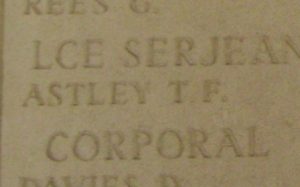
John Henry Banfield, Private, 37849, Welsh Regiment. John was born in Rochdale, Lancashire in 1875, the illegitimate son of Florence Banfield. He came to Newtown as a young man after being adopted by Mrs. Gilbert, of Canal Road, then by 1891 was lodging at Oak Street, Ystradfodwg, where he worked as a coalminer. He married Abigail Frances Davies, of Newtown, at Pontypridd on 20 December 1906 and by 1911 the couple had moved to Evan Court, Newtown, where John had found work as a labourer. John had returned to South Wales just prior to the war and was working as a coalminer at Pentre when he enlisted there into the 14th Battalion, Royal Welsh Fusiliers on 16 December 1914. Just over a week later he was discharged as he was found to be overage, but as the war progressed and manpower became in short supply, the standards for soldiers changed and John re-enlisted at Pentre into the 17th Battalion, Welsh Regiment. The battalion was raised in January 1915 as a Bantam Battalion, made up of men of below average height, and initially went to Porthcawl attached to the 43rd (Welsh) Division. During July 1915 the battalion moved to Prees Heath to join 119 Brigade, 40th (Bantam) Division and landed in France with the Division in June 1916. The Division moved to positions around Lillers before taking over the North Maroc Sector, near Loos, for trench initiation and once acclimatised was left to hold the sector itself over the coming months. The infantry battalions of the Division then began the usual routines of rotating for duty in the trenches: normally four days in the front line; four in support and four in reserve. Late in 1916 the Division moved south to the Somme, and fought at the Battle of the Ancre, before remaining in the sector over the winter. John became ill over the harsh winter and died of pneumonia at Suzanne, in the Somme valley, on 10 February 1917, aged 41. He was buried in Suzanne Military Cemetery No.3, France.
Richard Ernest Beadles, Private, 290144, Royal Welsh Fusiliers. Richard was the son of Thomas and Sarah Ann Beadles, of 3, Cross Street, Newtown. He worked as a printer prior to the war. Richard enlisted at Newtown into the 7th Battalion, Royal Welsh Fusiliers on 6 February 1913 and attended the next two annual TA summer camps at Rhyl in 1913 and Aberystwyth in 1914. The battalion was a Territorial unit, which mobilised for war at Newtown in August 1914, as part of North Wales Brigade, Welsh Division and moved to Conway until the end of the month, before moving to Northampton. In December the Division moved to Cambridge and then in May 1915 to Bedford, where the Division was numbered and the formation became 158 Brigade, 53rd (Welsh) Division. On 19 July 1915 the entire Division sailed from Devonport for Imbros and on 9 August 1915 landed at Suvla Bay. The infantry moved off the beaches across the Salt Lake, under shellfire, into the scrub covered Chocolate Hill, but due to a lack of maps and no knowledge of the terrain, many of the units became disorientated, and the situation became chaotic. Richard was wounded soon after the landings and was invalided home over the coming weeks, eventually for treatment at Netley Military Hospital. He was found to be suffering from heart disease whilst receiving treatment for his wounds and was discharged from the army as medically unfit on 7 January 1918, returning home to Newtown. Richard sadly died of heart disease at Newtown on 1 October 1918, aged 23. He was buried in St. Llwchaiarn’s Churchyard, Llanllwchaiarn. One of his cousins, Thomas Edward Beadles, was killed in France in September 1918.
Thomas Edward Beadles, Lance Corporal, 355759, Royal Welsh Fusiliers. Thomas was the son of Robert and Ann Beadles, of Frolic Court, Newtown. He worked as a collier prior to enlisting into the Welsh Horse Yeomanry at Newtown on 7 January 1915. Thomas married Ethel May Jones whilst on leave on 11 September 1915, and the couple set up home at 58, Ladywell Street, Newtown. The Welsh Horse had formed as a Welsh cavalry unit in Glamorgan in August 1914, before transferring to the Montgomeryshire T.F. Association, with headquarters at Newtown. The battalion then moved to the Diss area of Norfolk attached to the 1/1st North Midland Mounted Brigade, 1st Mounted Division. In September 1915 the Division was dismounted and sailed from Liverpool aboard the SS Olympic on 25 September 1915, landing at Anzac Cove, Gallipoli on 10 October, where the Welsh Horse became attached to the 54th (Lowland) Division and was used as a pioneer unit, digging tunnels and dugouts. The Welsh Horse was evacuated from Egypt in December 1915 and was placed on the Suez Canal Defences as part of the 3rd Dismounted Brigade. On 4 March 1917 the Welsh Horse merged with the Montgomeryshire Yeomanry to form the 25th (Montgomery & Welsh Horse Yeomanry) Battalion, Royal Welsh Fusiliers, as part of the newly formed 231 Brigade, 74th (Yeomanry) Division. The Division saw its first major action during the Second Battle of Gaza on 17 April. The battle was a failure, and the EEF was re-organised under a new commander, Sir Edmund Allenby, before launching the Third Battle of Gaza on the night of 31 October 1917. This assault was launched along a winder front, running from Gaza to Beersheba, and this time the EEF prevailed, opening the door to Jerusalem. The Division then took part in the drive north into Syria, but because of the heavy losses suffered in France, following the launching of the three German Spring offensives from 21 March 1918, was sent to France, landing in Marseilles on 7 May 1918. The Division underwent a system of training, to prepare it for the vastly different conditions on the Western Front, before taking over a section of the front in the St. Floris Sector. At the end of August, the Division moved south to the Somme sector, to join the great offensive towards the Hindenburg Line. Thomas was killed during an assault by the 25th RWF on a system of trenches northeast of Hargicourt on 8 September 1918. The 25-year-old is buried in Ste. Emilie Valley Cemetery, Villers-Faucon, France. One of his cousins, Richard Ernest Beadles, died in October 1918 of illness incurred during the war.
Richard George Beddoes, Private, 41623, Yorkshire Regiment. Richard was the son of George and Mary Beddoes of The Woodlands, Little Stretton, Shropshire. He married Wilhelmina Caroline Griffiths in 1910 and the couple set up home at 3, The Crescent, Newtown. Richard worked as an assurance superintendent for the Wesleyan and General Assurance Company at Newtown prior to the war. He enlisted at Welshpool into the Royal Field Artillery, but after completing his training was transferred to the 6th Battalion, Yorkshire Regiment. The battalion was attached to 32 Brigade, 11th (Northern) Division and had fought through the Gallipoli campaign before moving to France, landing at Marseilles on 1 July 1916. The Division then moved to positions near Écoivres before taking up position in the Arras sector. In September the Division moved to the Somme sector and took part in the Battle of Flers-Courcelette, which saw the first ever use of tanks on the battlefield. The Division remained on the Somme over the winter of 1916-17, spending the winter on the Ancre. The Division followed up the German withdrawal to the Hindenburg Line in March 1917, reaching Hermies, then in May 1917 was relieved before moving north to the Scherpenberg area before taking over a section of the front line near Wytschaete. The Division took part in the Battle of Messines on 7 June 1917, before moving to the Wormhoudt area to rest and train in preparation for the Third Battle of Ypres. Following the capture of the Pilckem Ridge by the 38th (Welsh) Division on 31 July, the 11th Division crossed the Steenbeek and took up positions on the west bank, in preparation to launch an assault upon Langemarck. The 6th Yorkshire’s launched their assault at 04.00 on 14 August 1917, gaining its objectives on the left flank, but became hit by heavy machine-gun fire on the right, which stopped the advance. Richard was killed in action during the terrible fighting that day. The 37-year-old has no known grave and is commemorated on the Ypres (Menin Gate) Memorial, Belgium.
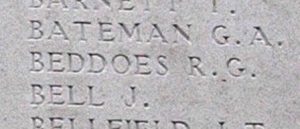
Bert Bennett, Private, 26363, Cheshire Regiment. Bert was the son of George Bennett and Letitia Bennett (nee Jones), of Little Garth, Newtown. He worked as a waggoner at Tanybwlch Farm, Llangollen prior to the war. Bert enlisted into the Cheshire Regiment at Chester on 17 May 1915 and was posted to the 10th Battalion, Cheshire Regiment. He joined the battalion at Aldershot, where it was attached to 75 Brigade, 25th Division. The Division landed in France on 26 September 1915 and moved to the Ploegsteert sector for trench initiation, and a month later the 10th Cheshire’s transferred to 7 Brigade, in the same 25th Division. In March 1916 the 25th Division moved south to the Monts en Ternois area in reserve, before taking over positions at Mont St. Eloi, in the Vimy Sector, where the Division defended Vimy Ridge against a German attack in May 1916. The Division then moved to the Warloy area in June and took over the line near Aveluy before attacking on 3 July near Thiepval. On 7 July, after a torrid spell in the line, the 10th Cheshire’s were relieved and moved back to Aveluy Wood, the onto Ovillers-La Boiselle on 10 July, taking over a section of the front line at Ovillers. The battalion attacked a system of German trenches south of Ovillers on 14 July 1916 but suffered heavy casualties from machine-gun fire. Bert was killed in action during the fighting that day. The 28-year-old has no known grave and is commemorated on the Thiepval Memorial, France.
Charles Denley Bennett, Sergeant, 5374, East Lancashire Regiment. Charles was the son of John Bennett and Elizabeth Bennett, of Public Hall, Newtown. He had left home as a young man to enlist into the army and by 1911 was serving with the 1st Battalion, East Lancashire Regiment at Inkerman Barracks, Knaphill, Woking. Charles married Catherine Blanch Gravenor, of Newtown, in 1912. When war broke out Charles re-joined his old regiment, but was initially posted to the 3rd Battalion, East Lancashire Regiment. He was drafted to France in 1916, joining the 1st Battalion, East Lancashire Regiment, which was attached to 11 Brigade, 4th Division. The Division fought throughout the Somme offensive over the summer of 1916, seeing its first action there during the opening assault on 1 July 1916. The Division then moved north to Ypres to rebuild, taking over positions on the Canal Bank. In September the Division moved to the coast, near Dunkirk, to practise embarkation aboard armed trawlers and whilst there received news that the 4th Division was to move back to the Somme, taking part in the Battle of Le Transloy in October 1916. The Division wintered on the Somme, and by April 1917 had moved to Arras, where it fought at the First and Third Battles of the Scarpe. Charles was taken prisoner by the Germans at some time and was taken to a prisoner of war camp in Latvia, which had been invaded by the Germans in 1915. He died in captivity at Mitau on 18 October 1917, aged 39. Charles is buried in Meza (Nikolai) Cemetery, Latvia.
David Charles Bevan, Private, 54698, Royal Welsh Fusiliers. David was the son of Edward and Jane Bevan of Frolic Street, Newtown. He married Mary Davies in 1909 and the couple set up home at 1, Wesley Place, Newtown. David worked as a bricklayer prior to the war. He originally enlisted at Newtown into the 7th Battalion, Royal Welsh Fusiliers, and was drafted to France early in 1916, joining the 10th Battalion, Royal Welsh Fusiliers, which was attached to 76 Brigade, 3rd Division, and was holding the line at St. Eloi, near Ypres. The Division saw heavy fighting during the Actions of the Bluff in February 1916 and then at the Actions of the St Eloi Craters from 27 March to 16 April. David probably joined the 10th RWF after one of these actions, due to heavy losses suffered by the battalion. The battalion continued to suffer during these months at St. Eloi, coming under a gas attack for the first time on 29/30 April. By the middle of June, the Division had moved out of the Ypres Salient to billets around Eperlecques, where intense training was carried out prior to moving to the Somme sector by 2 July. The main Somme offensive had opened on the previous day, and the 3rd Division was ready to enter the fray, bivouacking at Bronfay Farm by 9 July and on 13 July moved into the captured German lines at Montauban Alley. The 10th RWF took part in heavy fighting over the coming days, and on 19 July received orders for an assault on Delville Wood. Just after midnight the following day the battalion moved forwards and became caught in in terrible fighting within the wood, the fighting of such severity that two men of the battalion were awarded the Victoria Cross. On 25 July the shattered battalion was relieved and moved into reserve and did not move back into the line until 17 August, when the battalion attacked Lonely Trench. On 23 August the Division moved out of the line to rest and moved to Noeux-les-Mines, near Loos. After a month there, the Division moved back into a rest area for further training before moving back south to the Somme and by 12 November took over trenches at Serre. On the following day, 13 November 1916, the Division launched an assault against the German positions at Serre. The 10th RWF reached Serre village, but the flanking battalions failed to keep up, and heavy losses were suffered, with almost 300 officers and men killed, wounded, or missing. David was killed in action during the assault on Serre that day. The 35-year-old has no known grave and is commemorated on the Thiepval Memorial, France.
David Pryce Bound, Gunner, 836476, Royal Field Artillery. David was the son of Thomas Bound and Ruth Bound (nee Brown), of Dingle Cottage, Newtown. He was working as a coalminer at Cwmparc by 1911, then moved to Hockley, Birmingham to work as a tram driver. David married Minnie Blanche Pryce, of Newtown, at Ashted Church, Warwickshire on 3 April 1915. He enlisted into the Royal Field Artillery at Birmingham on 23 October 1915, and was initially posted to B Battery, 307th Brigade, RFA. David embarked for France at Southampton on 24 May 1916 with the 2/3rd South Midland Field Artillery Brigade, RFA. He served in France for over a year before being badly wounded, suffering wounds to his legs and feet and was admitted to the 22nd General Hospital at Camiers on 23 June 1917. David was then transferred back to England for further treatment at Newhaven hospital and was not discharged until 8 August. David embarked for France again on 28 December 1917 and joined the 114th Battery, 25th Brigade, RFA. He was badly wounded again during the great offensive, which had been launched on 21 August 1918, and was evacuated to the 50th Casualty Clearing Station at Premont, where he died of his wounds on 7 November 1918. The 26-year-old is buried in Premont British Cemetery, Gouy, France.
George Llewelyn Bray, Corporal, 31311, Manchester Regiment. George was the son Pryce Bray and Susan Bray (nee Price), of Bank Cottage, Broad Street, Newtown. He trained as a draper and shop assistant at Newtown prior to the war before gaining a position in Manchester. George enlisted at Manchester into the 18th Battalion, Manchester Regiment on 9 June 1915. The battalion had been raised in the city by the Lord Mayor, before moving to Belton Park, Grantham to join 90 Brigade, 30th Division and completed its training at Larkhill before landing at Boulogne on 6 November 1915. George was drafted out to the battalion among a number of reinforcements on 13 January 1916, joining the battalion at Suzanne, on the Somme. The Division remained on the Somme throughout the remainder of the year, seeing its first major action during the Somme Offensive, at the Battle of Albert, where it captured Montauban. The Division then fought during the latter stages of the offensive, during the Battle of Le Transloy, before wintering on the Somme. In March 1917 the Division followed the German Retreat to the Hindenburg Line, and in April took part in the First Battle of the Scarpe. The Division was at Neuville Vitasse as the battle opened and at dawn on 23 April 1917 half of the 18th Manchester’s supported an assault from its trenches, southeast of Heninel, by the 16th Manchester’s upon the German lines. As the attacking troops advanced, the remaining half of the 18th Manchester’s moved forwards, taking over the old British front lines before attacking the blue line in conjunction with the 19th Manchester’s. George was killed in action during the fighting that day, 23 April 1917. The 20-year-old has no known grave and is commemorated on the Arras Memorial, France.
Andrew Breese, Gunner, 711652, Royal Field Artillery. Andrew was the son of Richard and Elizabeth Breese, of Llanwnog. He married Elizabeth Corfield in 1910 and the couple initially lived with her parents, whilst Andrew worked as a boot repairer in Newtown. Andrew enlisted into the Royal Field Artillery and was posted to ‘B’ Battery, 87th Brigade, Royal Field Artillery, which was attached to the 19th (Western) Division. The Division had embarked for France in July 1915 and had taken part in almost every major offensive, thereafter, seeing its first action during the Battle of Loos. In 1916 the Division saw heavy fighting during the Somme offensive, then in 1917 took part in the Battle of Messines Ridge and in the Third Battle of Ypres. The Division was caught up in the heavy fighting which followed the launching of the German Spring offensive on the Somme on 21 March 1918, then moved to the Messines area to rebuild, where it was caught up in the second phase of the German offensive on 9 April. The battered Division was then transferred south to the Aisne, but on 27 May was caught up in the third, and final, German offensive of 1918, and suffered terribly yet again. The Division was vastly rebuilt before returning to action later in the summer of 1918, taking part in the great offensive which ultimately forced the German surrender. Andrew survived the war but took ill just after the Armistice, and died of disease, probably influenza, at Etretat on 25 November 1918. The 37-year-old is buried in Etretat Churchyard Extension, France.
Edward Breese, Private, 11610, South Wales Borderers. Edward was born at Newtown in about 1880. He left home as a young man to enlist into the South Wales Borderers but had left the army by 1911 and was lodging at 45, Brewery Street, Pontygwaith, where he worked as a coalminer. Edward was an Army Reservist and re-joined the 1st Battalion, South Wales Borderers soon after the outbreak of war. The battalion had landed in France on 13 August 1914 attached to 3 Brigade, 1st Division and had taken part in the Battle of Mons and the subsequent retreat to the Marne, before the BEF moved to Ypres and had suffered heavy losses during the defence of Ypres at the Battle of Gheluvelt. Edward landed in France on 9 November 1914, joining the 1st SWB at Ypres. The 1st Division then wintered in Flanders and saw its first major action of 1915 during the Battle of Aubers. The Division then took part in the Battle of Loos, and the action at the Hohenzollern redoubt. In July 1916 the Division moved south to the Somme and saw heavy fighting at Bazentin Ridge and High Wood, before taking part in the later Battle of Morval. The Division followed the German retreat to the Hindenburg Line in early 1917, before being briefed for an operation on the Flanders Coast and moved there during the summer of 1917. While holding the line on the coast, the planned offensive was called off and the Division was transferred to Ypres to join the great offensive for Passchendaele Ridge. After spending another Winter in Flanders, the Division was near Éstaires when the German’s launched their Lys offensive on 9 April and saw heavy fighting as the line was driven back over the coming weeks. The Division then enjoyed a relatively peaceful summer before taking part in the great Allied offensive, which was launched on the Somme sector on 21 August 1918. The 1st Division was in the Loos sector when this great offensive was launched to the south, then moved to the Vis-en-Artois sector on 2 September to join the offensive towards the Drocourt-Queant line. Just a week later, the Division was moved south to Villers-Bretonneux and on 15 September 1918 the 1st SWB took part in an assault towards the village of Maissemy. Edward was killed in action during the fighting that day. The 38-year-old has no known grave and is commemorated on the Vis-en-Artois Memorial, Haucourt, France.
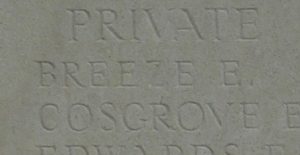
John Ewart Breeze, Sergeant, 290005, Royal Welsh Fusiliers. John was the son of George Ewart and Jane Breeze, of Cross Guns Cottage, Park Street, Newtown. He had served for a short while with the 5th Volunteer Battalion, South Wales Borderers, before attesting into the 7th Battalion, Royal Welsh Fusiliers on 7 April 1908 following the formation of the Territorial Army that year. John worked as a Draper prior to the war. The battalion was mobilised for war at Newtown in August 1914, as part of North Wales Brigade, Welsh Division and moved to Conway until the end of the month, before moving to Northampton. In December the Division moved to Cambridge and then in May 1915 to Bedford, where the Division was numbered and the formation became 158 Brigade, 53rd (Welsh) Division. On 19 July 1915 the entire Division sailed from Devonport for Imbros and on 9 August 1915 landed at Suvla Bay. The infantry moved off the beaches across the Salt Lake, under shellfire, into the scrub covered Chocolate Hill, but due to a lack of maps and no knowledge of the terrain, many of the units became disorientated, and the situation became chaotic. The Division was eventually evacuated from Gallipoli in December 1915, moving to Egypt to join the EEF, and helped guard the Suez Canal before taking part in operations to drive the Turks out of the Sinai. The EEF then turned its attention onto driving the Turks out of Palestine, and on 26 March 1917 launched its first offensive against the coastal city of Gaza, which guarded the road to Jerusalem. Initial gains during the day were lost when the assaulting divisions lost touch with each other, and communication broke down when a thick fog cloaked the battlefield. A second attempt to force Gaza was launched on 17 April, which also failed, and the EEF suffered a change in leadership, with Sir Edmund Allenby assuming command, before being re-organised, and a third offensive was launched against a wider front from Beersheba to Gaza on 31 October 1917. This time the Turkish defences were breached, and the road to Jerusalem now lay open and the EEF began to advance north. On 6 November 1917, 158 Brigade launched an attack on the Khuweilfeh Heights. John was killed in action during the assault that day. The 28-year-old is buried in Beersheba War Cemetery, Israel.
Arthur Charles Brock, Lance Corporal, 199, Royal Welsh Fusiliers. Arthur was the son of James Thomas Brock and Amy Sarah Brock (nee Martin) of 20, Kerry Road, Newtown. He worked as a wood turner prior to the war. Arthur had enlisted at Newtown into the 7th Battalion, Royal Welsh Fusiliers in 1908. The battalion was a Territorial unit, which mobilised for war at Newtown in August 1914, as part of North Wales Brigade, Welsh Division and moved to Conway until the end of the month, before moving to Northampton. In December the Division moved to Cambridge and then in May 1915 to Bedford, where the Division was numbered and the formation became 158 Brigade, 53rd (Welsh) Division. On 19 July 1915 the entire Division sailed from Devonport for Imbros and on 9 August 1915 landed at Suvla Bay. The infantry moved off the beaches across the Salt Lake, under shellfire, into the scrub covered Chocolate Hill, but due to a lack of maps and no knowledge of the terrain, many of the units became disorientated, and the situation became chaotic. Arthur was killed in action during the following day, 10 August 1915. The 23-year-old is buried in Green Hill Cemetery, Gallipoli.
Charles Ernest Brown, Private, 156266, Machine Gun Corps. Charles was the son of Edward and Margaret Brown, of Mostyn House, Market Street, Newtown. He enlisted into the 3/7th Battalion, Royal Welsh Fusiliers in March 1916 and was posted to Park Hall Camp, Oswestry for training. Charles then embarked for Egypt in July 1917, before joining the 1/7th Battalion, Royal Welsh Fusiliers, which was in Palestine attached to 158 Brigade, 53rd (Welsh) Division. Charles possibly took part in the Third Battle of Gaza, before contracting dysentery and being invalided back to Britain. Upon his recovery he was posted to the 4th (Reserve) Battalion, Royal Welsh Fusiliers at Kinmel Park, before being posted to the Machine Gun Corps and sent to Clipstone Camp in Nottinghamshire for training. Charles took ill whilst training at Clipstone and died of pneumonia at Clipstone Military Hospital on 7 July 1918. The remains of the 32-year-old were brought home and he was buried in Newtown and Llanllwchaiarn Cemetery three days later.
William Edgar Brown, Lance Corporal, 290126, Royal Welsh Fusiliers. William was the son of Sarah Jane Brown, of Pentre, Llanfyllin. He had worked as a farm labourer at Ty Ucha, Bwlch-y-Cibau, and then became a postman prior to the war. William enlisted into the 7th Battalion, Royal Welsh Fusiliers at Llanfyllin on 1 November 1912, and had attended the annual summer TA camps at Rhyl and Aberystwyth prior to the outbreak of war. The battalion was a Territorial unit, which mobilised for war at Newtown in August 1914, as part of North Wales Brigade, Welsh Division and moved to Conway until the end of the month, before moving to Northampton. In December the Division moved to Cambridge and then in May 1915 to Bedford, where the Division was numbered and the formation became 158 Brigade, 53rd (Welsh) Division. On 19 July 1915 the entire Division sailed from Devonport for Imbros and on 9 August 1915 landed at Suvla Bay. The infantry moved off the beaches into the bush, but due to a lack of maps and no knowledge of the terrain, many of the units became disorientated, and the situation became chaotic. The Division was eventually evacuated from Gallipoli in December 1915, moving to Egypt to join the EEF, and helped guard the Suez Canal before taking part in operations to drive the Turks out of the Sinai. The EEF then turned its attention onto driving the Turks out of Palestine, and on 26 March 1917 launched its first offensive against the coastal city of Gaza, which guarded the road to Jerusalem. Initial gains during the day were lost when the assaulting divisions lost touch with each other, and communication broke down when a thick fog cloaked the battlefield. William was killed in action during the heavy fighting that day. The 25-year-old is buried in Gaza War Cemetery, Israel.
Edmund Maurice Buckley, Second Lieutenant, Royal Welsh Fusiliers. Edmund was born on 1 December 1886, the only son of Sir Edmund Buckley, Second Baronet Mawddy, and Lady Harriet Olivia Louise Buckley (nee Lloyd), of Aberhirnant Hall, Bala; Plas Dinas, Dinas Mawddy; Milford Hall, Newtown; Grotton Hall, Saddleworth; and of Maesllan, Barmouth. He was educated at Cheltenham College before entering Manchester University in 1904 to study engineering. Upon graduating, he begun working for Humber Works Limited at Beeston, and Coventry and was placed in charge of the Motorcycle Repair Department. He played rugby for Coventry and was the captain of the second XV. Edmund enlisted into the Public Schools Battalion, London Regiment as a Private at the outbreak of war, and on 21 September 1914 was commissioned into the 7th Battalion, Royal Welsh Fusiliers. The battalion was a Territorial unit, which mobilised for war at Newtown in August 1914, as part of North Wales Brigade, Welsh Division and moved to Conway until the end of the month, before moving to Northampton. In December the Division moved to Cambridge and then in May 1915 to Bedford, where the Division was numbered and the formation became 158 Brigade, 53rd (Welsh) Division. On 19 July 1915 the entire Division sailed from Devonport for Imbros and on 9 August 1915 landed at Suvla Bay. The infantry moved off the beaches into the bush, but due to a lack of maps and no knowledge of the terrain, many of the units became disorientated, and the situation became chaotic. On the morning of 10 August, the Division took part in an advance on Scimitar Hill under heavy fire and suffered terrible casualties, before being forced to withdraw. Edmund was wounded during the fighting, and died of his wounds on 12 August 1915, aged 29. He is buried in Lancashire Landing Cemetery, Gallipoli. Upon the death of his father in 1919, the title of Baronet Mawddy also died. Edmund is also commemorated on at least two other war memorials, at Newtown and at Barmouth.
Thomas George Deane Burdett, MC, Captain, Royal Welsh Fusiliers. Thomas was born at Rhyl on 15 February 1881, the son of George Deane Burdett and Claudia H. Deane Burdett. Claudia was from Aberystwyth, and Thomas was educated at Aberystwyth Grammar School, and at the University. He became a solicitor prior to the war and was commissioned on 2 September 1914 into the 1/7th Battalion, Royal Welsh Fusiliers. The battalion was attached to 158 Brigade, 53rd (Welsh) Division, and landed at Gallipoli on 9 August 1915. Here the Division was immediately thrown into action, and spent the next few days in isolated pockets, fighting against a Turkish counterattack during the Battle of Sari Bair, then the ensuing Attack on Scimitar Hill. The Division remained here throughout the coming months and suffered severe losses in manpower strength during the great November 1915 blizzard on Gallipoli, when its total strength was reduced to less than that of a full-strength Brigade. On 11 December 1915 the Division was evacuated to Mudros, and by 23 December 1915 were moved to Egypt. They remained on the Suez Canal Defences for the next twelve months, and in early 1917 moved into Palestine, where they remained for the duration of the war, fighting at the Battles of Gaza, and successfully capturing Jerusalem. Thomas was killed in action during the Third Battle of Gaza, on 6 November 1917. He was 36 years old, and is buried at Beersheba War Cemetery, Israel. He was awarded a posthumous MC which was presented to his mother by Lt Gen Pitcairn Campbell GOC Chief of Western Command in Chester.
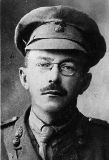
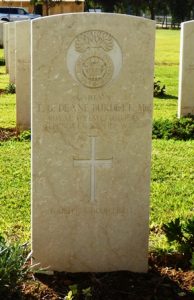
Owen Clark, Sergeant, S/1010, The Queen’s (Royal West Surrey Regiment). Owen was born at Wakefield, Yorkshire in 1878, the son of Mason Clark and Sarah Clark (nee Phillips). His mother was from Newtown and the family had moved to the Newtown Library by 1887, after his father had taken over the position of Librarian there. Owen became a printer and moved to Dorking, Surrey as a young man, where he married Elizabeth Amelia George on 18 January 1908. The couple lived at 36, Rathes Road, Dorking, where their four children were born. Owen enlisted at Guildford into the 8th Battalion, The Queen’s (Royal West Surrey) soon after the outbreak of war. The battalion had formed at Guildford in September 1914, before joining 72 Brigade, 24th Division at Shoreham. In December 1914 the battalion moved to Worthing, then back to Shoreham for a short while before moving to Blackdown Camp, Aldershot with the Division to complete its training, before embarking for France and landing at Boulogne on 31 August 1915. Despite its inexperience, the Division was sent into action at the second day of the Battle of Loos on 26 September 1915 and suffered terrible casualties. Owen was killed in action at Loos that day. The 36-year-old has no known grave and is commemorated on the Loos Memorial, France. One of his sons, Oliver William Clark, was taken prisoner by the Japanese in Singapore on 15 February 1942 and died in 1951 because of ill-health which resulted from over four years in captivity.
William Albert Cliff, Sergeant, 16463, The Loyal North Lancashire Regiment. William was born in Mount Pleasant, Newtown in 1894, the son of Thomas Cliff and Hannah Cliff (nee Roberts). His father died in 1898 and the family had moved to 67, Essingdon Street, Daubhill, Bolton by 1911, where William found work as a piecer in a cotton mill. William enlisted at Bolton into the 9th Battalion, The Loyal North Lancashire Regiment on 4 September 1914. The battalion had formed at Preston in September 1914, moving to Salisbury Plain to join 74 Brigade, 25th Division, then completed its training at Aldershot before embarking for France and landed at Boulogne on 26 September 1915. The Division moved to the Le Bizet sector for trench initiation and remained there until March 1916 when it was moved to the Vimy Sector, taking over a section of the line near Camblain-l’Abbé. In June the Division was relieved and began marching south to the Somme sector, reaching Bouzincourt by 2 July, the day after the Battle of the Somme opened. On 5 July the 9th Loyal’s took over a section of trenches at La Boiselle, the scene of a massive mine crater which still exists today and prepared to join the fight. At dawn on 7 July 1916 the battalion launched an assault against the German lines, capturing both its allotted objectives which were consolidated. William was killed in action during the fighting that day. The 22-year-old is buried in Ovillers Military Cemetery, France.
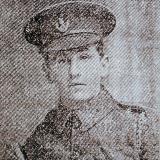
Henry James Crank, Lance Corporal, 10342, Welsh Regiment. Henry was born in Alsford, Hampshire in 1889, the son of Henry and Jessie Crank. He enlisted into the Welsh Regiment as a young soldier and by 1911 was stationed at Pembroke Dock with the 2nd Battalion, Welsh Regiment. Henry left the army soon afterwards and moved to Newtown, where he married Florence Williams on 11 April 1916. As a former soldier he was an Army Reservist and was mobilised at some time prior to his marriage. Henry was drafted to France in May 1916 and was posted to the 19th Battalion, Welsh Regiment, which was the Pioneer Battalion to the 38th (Welsh) Division. The Division had moved to France on 2 December 1915 and moved to the Nursery Sector near Fleurbaix for trench initiation alongside the Guards Division. The Division then held a sector of the line near Cuinchy before marching south to the Somme sector in June 1916 to take part in the assault on Mametz Wood. The first attack on the wood was launched on a two-battalion front on 7 July, but failed, and the Divisional Commander, Sir Ivor Philipps, was replaced before the Division attacked again on a two Brigade front on 10 July 1916. The 19th Welsh had been busy digging a communications trench and consolidating the small gains made during the opening attack, but the heavy fighting on 10 July meant that the battalion had to also carry ammunition up to the troops fighting within the wood. Henry was killed in action at Mametz Wood on 11 July 1916. The 26-year-old has no known grave and is commemorated on the Thiepval Memorial, France.
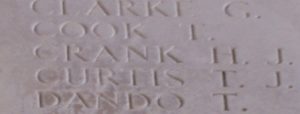
Cecil Ewart Davies, Private, 290097, Royal Welsh Fusiliers. Cecil was the son of Herbert Alfred Davies and Muriel Isabella Davies (nee Moore), of 14, Bridge Street, Newtown. He worked as a shop assistant for S. Aston & Sons at High Street, Newtown prior to the war. Cecil enlisted at Newtown into the 7th Battalion, Royal Welsh Fusiliers on 28 March 1912 and over the coming years attended the annual TA summer camps at Carnarvon, Rhyl, and Aberystwyth. The battalion mobilised for war at Newtown in August 1914, as part of North Wales Brigade, Welsh Division and moved to Conway until the end of the month, before moving to Northampton. In December the Division moved to Cambridge and then in May 1915 to Bedford, where the Division was numbered and the formation became 158 Brigade, 53rd (Welsh) Division. Cecil had by now been transferred to the 3/7th Battalion, Royal Welsh Fusiliers, which was at Park Hall Camp, Oswestry, so did not embark for Gallipoli with the Division. On 25 March 1916 he embarked at Devonport for Egypt, among a large draft of reinforcements, and joined the 1/7th Battalion, Royal Welsh Fusiliers on the Suez Canal Defences in June, after a short spell in hospital in Alexandria. The 53rd (Welsh) Division had been evacuated from Gallipoli in December 1915, moving to Egypt to join the EEF, and helped guard the Suez Canal before taking part in operations to drive the Turks out of the Sinai. The EEF then turned its attention onto driving the Turks out of Palestine, and on 26 March 1917 launched its first offensive against the coastal city of Gaza, which guarded the road to Jerusalem. Initial gains during the day were lost when the assaulting divisions lost touch with each other, and communication broke down when a thick fog cloaked the battlefield. Cecil was killed in action during the attack on Gaza that day. The 23-year-old is buried in Gaza War Cemetery.
David William Davies, Private, 2619, Montgomeryshire Yeomanry. David was born near Mold in 1893, the son of John Davies and Mary Ann Davies. The family had moved to Mochdre when David was young. He married Violet Maud Weaving at Newtown in 1913 and the couple moved to South Wales, where their son Eric William Davies was born on 2 July 1914. The couple then returned to Newtown where David found work as a Coachman. He enlisted at Newtown into the Montgomeryshire Yeomanry soon after the outbreak of war. On 5 August 1914 the Montgomeryshire Yeomanry was mobilised at Welshpool, as part of the South Wales Mounted Brigade, before moving via Hereford to Thetford, to join the 1st Mounted Division. On 4 March 1916 the 1st Mounted Division sailed for Egypt to join the EEF and began patrolling the area of the Suez Canal, taking part in several actions against the Senussi tribesmen. David was wounded in Egypt during the summer of 1916 and was evacuated to hospital at Port Said, where he died of his wounds on 31 August 1916. The 23-year-old is buried in Port Said War Memorial Cemetery, Egypt.
Frederick William Davies, Private, 235330, Royal Welsh Fusiliers. Frederick was born in Newtown in 1896, the son of Thomas Richard Davies and Jane Davies. The family left Newtown when Frederick was young and they moved to 8, Pinder Street, Hulme, Manchester, where Frederick gained work as a painter. He enlisted at Manchester into the 14th Battalion, Cheshire Regiment on 9 December 1915 and was initially placed on the Army Reserve. On 3 March 1916 Frederick was mobilised and travelled to Ashton-under-Lyne for his medical before joining the 14th Cheshire’s at Prees Heath, where the battalion was attached to the 11th Reserve Brigade. Frederick embarked at Southampton for France on 10 June 1917 and disembarked in Rouen, joining the 4th Infantry Base Depot. He was transferred to the 4th Reserve Battalion, Royal Welsh Fusiliers, before being posted to the 16th Battalion, Royal Welsh Fusiliers on 28 June. Frederick joined the battalion at Ypres, where it was attached to 113 Brigade, 38th (Welsh) Division, which was holding the Boesinghe sector on the Yser Canal. Frederick was wounded during his first major action, when the 38th Division assaulted and captured the Pilckem Ridge on 31 July 1917, suffering gunshot wounds to his groin. He was evacuated via the 130th Field Ambulance to the 12th Casualty Clearing Station, before being sent to hospital at Rouen and on 16 August 1917 was sent back to England aboard the Hospital Ship SS Grantully Castle. He recovered over the coming months and on 12 January 1918 embarked at Southampton for France again, before being posted to the 14th Battalion, Royal Welsh Fusiliers, which was in the same 113 Brigade, 38th (Welsh) Division. The Division had been transferred from Ypres to the Sailly-sur-la-Lys sector in September 1917 and remained in the area over the winter before being moved to positions north of Albert, at Bouzincourt Ridge, at the end of March 1918, relieving the battered 2nd and 47th Divisions. The Germans had reached as far as Bouzincourt Ridge during their great offensive over the preceding weeks and the 38th Division hatched a plan to regain the ridge, thus affording the Division the view over the Ancre Valley to Thiepval Ridge. At dawn on 22 April 1918, 113 Brigade launched an assault against the German positions on the ridge but suffered terrible casualties as the assaulting troops were hit by heavy machine-gun fire. Frederick was killed in action during the assault on Bouzincourt Ridge that morning. The 21-year-old has no known grave and is commemorated on the Pozieres Memorial, France.
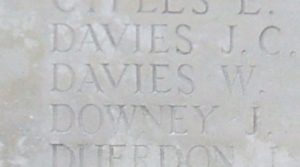
George Davies, Private, 63, Royal Welsh Fusiliers. George was born at Llandinam in 1879, the son of David and Anne Davies. He married Margaret Woodhouse at Newtown on 23 June 1912 and the couple set up home at 19, Cross Street, Kerry Road, Newtown. George worked as a painter prior to the war and was a long serving member of the 7th Battalion, Royal Welsh Fusiliers, having enlisted into the battalion at Newtown in 1908. The battalion was a Territorial unit, which mobilised for war at Newtown in August 1914, as part of North Wales Brigade, Welsh Division and moved to Conway until the end of the month, before moving to Northampton. In December the Division moved to Cambridge and then in May 1915 to Bedford, where the Division was numbered and the formation became 158 Brigade, 53rd (Welsh) Division. George had in the meantime been posted to the 3/7th Battalion, Royal Welsh Fusiliers, which was at Park Hall Camp, Oswestry. During the summer of 1916 George became ill, suffering from broncho-pneumonia, and was sent to Prees Heath Military Hospital, near Whitchurch. He died there of heart failure on 5 July 1916. The remains of the 37-year-old were brought home and he was buried in St. David’s Churchyard, Newtown soon afterwards. His brother, john Davies, died of wounds in France in 1918.
George Davies, Private, 73250, Royal Welsh Fusiliers. George was born in Wigan in 1898, the son of Thomas and Margaret Davies. His father was from Newtown, and just after the turn of the century the family moved back home from Wigan, eventually settling at 3, Bryn Street, Newtown. George enlisted at Welshpool into the army and was drafted to France early in 1918, being posted to the 2nd Battalion, Royal Welsh Fusiliers. The battalion had been in France since the outbreak of war and by the time that George joined its ranks it had been transferred to 115 Brigade, 38th (Welsh) Division, which was at the time in the Sailly-sur-la-Lys sector. To the south, the Germans had launched a desperate offensive from along the section of front line running south from Croisilles to la Fère and as a result, the 38th (Welsh) Division was sent south at the end of March 1918, relieving the battered 2nd and 47th Divisions. It held this sector, again carrying out minor operations and trench raids, over the coming months, before taking part in the great offensive of 21 August 1918, and began its advance towards the Hindenburg Line. Over the coming days the Division captured Pozieres and Thiepval Ridge, driving past Mametz Wood towards Longueval, and cleared Delville Wood. The village Lesboeufs was captured by 28 August, then the Division consolidated before launching an assault on Morval and Sailly-Saillisel on 1 September 1918. George was killed in action during the assault that day. The 20-year-old has no known grave and is commemorated on the Vis-en-Artois Memorial, Haucourt, France.
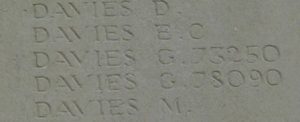
George Albert Davies, Private, 100753, Royal Welsh Fusiliers. George, known as Bert, was the son of John and Jane Davies, of Garden Place, Llanfair Road, Newtown. He enlisted into the Royal Welsh Fusiliers at Newtown but was too young to serve overseas during the war. Bert died of disease at Rochdale on 17 August 1923, aged 22. Nothing further is known of him, as he is not commemorated as a war casualty by the CWGC, and no service papers exist. His brother, John Henry Davies, had been killed at the Battle of Jutland in 1916.
George Ernest Davies, Sapper, 94841, Royal Engineers. George was the son of Evan and Elizabeth Davies, of Plasfoxen, Llandysilio. Prior to the war he was living with his wife, Edith Annie Davies, at Ismere, Witton Street, Stourbridge. George enlisted at Worcester into the Royal Engineers, and embarked for Gallipoli on 15 August 1915, landing at Gallipoli to join the SX Cable Section, Anzac Signal Depot. George would have worked in dangerous conditions, laying cables, which enabled communications from the Anzac HQs to the units in the front-line positions. George was wounded at the beginning of November 1915, and was evacuated to the beach at Embarkation Pier, where he died of his wounds on 10 November 1915, aged 28. He is buried in Embarkation Pier Cemetery, Gallipoli.
Hugh Thompson Davies, Corporal, 10482, Royal Welsh Fusiliers. Hugh was born at Montgomery in 1890, the son of Charles Davies and Annie Davies (nee Fletcher), of Princes’ Street. He was baptised at Montgomery on 5 April 1891. His mother was the daughter of Hugh Fletcher of Montgomery, whilst his father was a Draper. By 1901 the family had moved to 4, Cross Street, Newtown, but sadly later that year Charles died. Hugh worked as a Mason prior to enlisting into the Royal Welsh Fusiliers at Dolgellau on 26 August 1910. He was posted to the Depot at Wrexham, before being posted to the 1st Battalion, Royal Welsh Fusiliers on 13 December 1910. He served with the battalion for 11 months, before being transferred to the 2nd Battalion, Royal Welsh Fusiliers, which was in India, on garrison duties. On 3 March 1914 Hugh re-joined the 1st Battalion, Royal Welsh Fusiliers, which was on garrison duties in Malta. The battalion sailed for England on 3 September 1914, and joined 22 Brigade, 7th Division at Lyndhurst, before the entire Division embarked for the front, landing at Zeebrugge on 7 October 1914. By the time the Division landed, the city was in the process of falling to the Germans, so the 7th Division made the long march to Ypres, becoming the first British Division to hold the city. The remainder of the BEF joined the battalion soon afterwards, and a defensive line was created to the east of the city. The Division fought during the First Battle of Ypres, and helped stop the German advance through Belgium, and in March 1915 fought at the Battle of Neuve Chapelle. The Division remained in the area after the battle, then on 8 May 1915 took part in the Battle of Aubers Ridge. A week later, on 16 May 1915 the Allies made another attack, the Battle of Festubert, in the same sector. The 1st RWF had moved from billets at Essars on the previous day, marching via Bethune to its starting positions at Rue Cailloux, and at dawn on 16 May 1915 launched its assault on the German lines opposite. The battalion swept through the German front and 2nd lines, before becoming held up, suffering very heavy casualties. Hugh was killed in action at sometime during the assault that day. The 24-year-old has no known grave and is commemorated on the Le Touret Memorial, Richebourg-L’avoue, France.
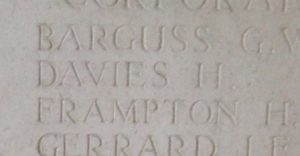
John Davies, Corporal, 8624, Worcestershire Regiment. John was born at Llandinam in 1875, the son of David and Anne Davies. The family later moved to 2, Oak Cottages, Kerry Road, Newtown. John was a long serving soldier, having enlisted at Chester on 11 February 1901, and had served during the Boer War with the Imperial Yeomanry. He had returned to Newtown by 1911 and was living with his parents, having found work as a gardener. As an army reservist, John was mobilised at the outbreak of war, and joined the 2nd Battalion, Worcestershire Regiment. The battalion was at Aldershot attached to 5 Brigade, 2nd Division and embarked for France on 14 August 1914, landing at Boulogne. One of the first Divisions to move to France, the 2nd Division moved to Belgium, where it fought at the Battle of Mons before taking part in the great retreat to the Marne where the German offensive was stopped. The Germans withdrew north to the Chemin-des-Dames, and the BEF advanced, fighting at the Battle of the Aisne. The 2nd Division was then moved to Flanders, where it fought at the First Battle of Ypres, where the German sweep through Flanders was stopped, before remaining in Flanders throughout the first winter of the war. In 1915 the Division took part in the Battle of Festubert, and in September fought at the Battle of Loos, and the subsequent Action of Hohenzollern Redoubt. On 20 December 1915 the 2nd Worcester’s transferred to the newly arrived 100 Brigade, 33rd Division. The Division saw its first major action during the Battles of the Somme, from July 1916 onwards. During the Spring of 1917 the Division moved to the Arras sector and took part in the Battle of the Scarpe and during the terrible fighting at Bullecourt, before heading to Ypres, and saw heavy fighting at the Menin Road and at Polygon Wood. The Division was still in Flanders when the German Spring Offensive hit on 9 April 1918 and saw heavy fighting as it was driven back from its positions at Neuve Eglise. John was wounded and captured by the Germans during the terrible days which followed. He died of his wounds at the German hospital at Lille on 25 April 1918. The 42-year-old is buried in Lille Southern Cemetery, France. His brother, George Davies, died at Prees Heath Military Hospital in 1916.
John Henry Davies, Able Seaman, J/11881, Royal Navy. John was born on 1 January 1894, the son of John and Jane Davies, of Garden Place, Llanfair Road, Newtown. He worked as a fishmonger’s assistant prior to the war. John enlisted into the Royal Navy on 1 January 1912, signing up for twelve years’ service. He was posted to HMS Ganges II for training before his first posting aboard HMS Commonwealth. Further postings followed aboard HMS King Alfred and HMS Irresistible, before s short posting to HMS Vivid I. On 2 September 1913 John was posted aboard the Minotaur-class armoured cruiser, HMS Defence. Defence had been built at Pembroke Dockyard, and launched on 24 April 1907, and was in the China Station when war erupted. Defence returned to Britain and saw action during the pursuit of the German warships Goeben and Breslau. She then blockaded the German ships inside the Dardanelles until being ordered to the South Atlantic to take part in the hunt for Admiral Graf von Spee’s East Asia Squadron. She then took part in some minor work before re-joining the 1st Cruiser Squadron of the Grand Fleet as its flagship, under the command of Rear-Admiral Sir Robert Arbuthnot. Following reports that the German High Seas Fleet had put to sea in May 1916, the Grand Fleet steamed into the North Sea to locate the Germans. The First Cruiser Squadron formed the starboard flank of the cruiser screen, ahead of the main body of the Grand Fleet, with Defence to the right of the centre of the line. At 17:47 on 31 May 1916 Defence and HMS Warrior, the leading two ships of the squadron, spotted some German ships and opened fire. Shortly afterwards, they spotted the disabled German light cruiser SMS Wiesbaden and closed to engage, however both ships were spotted by the German battlecruiser SMS Derfflinger and four other battleships, which opened fire upon Defence and Warrior. Defence was hit in the magazine which exploded and sent her to the bottom of the North Sea, with all her crew of some 900 men. John was 22 years old when he was killed in the sinking of Defence and is commemorated on the Plymouth Naval Memorial, Devon. His brother, George Albert Davies, known as Bertie, died in 1923 of disease contracted whilst serving in the war.
William Bennett Davies, Private, 351307, London Regiment. William was the son of James and Annie Davies, of Aldon, Milford Road, Newtown. He worked for the Civil Service prior to the war and lodged at 22, Niton Street, Fulham. William enlisted into the 7th Battalion, London Regiment at Sun Street soon after the outbreak of war. William embarked for France on 14 March 1916, joining the 1/7th Battalion, London Regiment, which was at Villers au Bois, attached to 140 Brigade, 47th (2nd London) Division. The Division was holding the Cabaret Rouge sector near Souchez, and its infantry battalions were carrying out the usual systems of rotating in the trenches. On 21 May 1916 the Division was attacked by the Germans, who had preceded their assault with a heavy minenwerfer and artillery bombardment, but despite heavy casualties kept the Germans at bay. The Division was relieved at the end of July and moved south to the Somme sector, spending a short period out of the line training before taking over trenches at High Wood on 14 September and on the following morning the Division launched an assault to the right of High Wood, supported by a tank. The attack heralded the opening of the Battle of Flers-Courcelette, the first tank action in history, and began a week of heavy fighting. The 1/7th London’s were relieved on 20 September and moved to Henencourt Wood to rest and rebuild. On 5 October the battalion moved back into the front line, to begin another tour in the trenches and on 7 October 1916 launched another assault upon the German lines. William was killed in action during the fighting that day. The 29-year-old has no known grave and is commemorated on the Thiepval Memorial, France.
William Edward Davies, Private, 291119, Royal Welsh Fusiliers. William was the son of Thomas and Elizabeth Davies, of The Lot, Newtown. He worked as a collier prior to enlisting at Newtown into the 7th Battalion, Royal Welsh Fusiliers on 12 July 1915. William was posted to Park Hall Camp, Oswestry to join the 3/7th Battalion, Royal Welsh Fusiliers. After completing his training, he embarked for Egypt on 29 February 1916, and upon his arrival was posted to the 1/7th Battalion, Royal Welsh Fusiliers, which was attached to 158 Brigade, 53rd (Welsh) Division. The Division had been evacuated from Gallipoli in December 1915, moving to Egypt to join the EEF, and helped guard the Suez Canal before taking part in operations to drive the Turks out of the Sinai. The EEF then turned its attention onto driving the Turks out of Palestine, and on 26 March 1917 launched its first offensive against the coastal city of Gaza, which guarded the road to Jerusalem. Initial gains during the day were lost when the assaulting divisions lost touch with each other, and communication broke down when a thick fog cloaked the battlefield. A second attempt to force Gaza was launched on 17 April, which also failed, and the EEF suffered a change in leadership, with Sir Edmund Allenby assuming command, before being re-organised, and a third offensive was launched against a wider front from Beersheba to Gaza on 31 October 1917. This time the Turkish defences were breached, and the road to Jerusalem now lay open and the EEF began to advance north. On 6 November 1917, 158 Brigade launched an attack on the Khuweilfeh Heights. William was mortally wounded during the attack that morning and died later that day. The 29-year-old is buried in Beersheba War Cemetery, Israel.
James Ernest Dodd, Private, 782623, London Regiment. James was the son of James and Ellen Dodd of Morgan’s Court, Bryn Street, Newtown. He worked as a wool sorter at the Cymric Mills prior to the war. James enlisted at Newtown into the 7th Battalion, Royal Welsh Fusiliers, but was then posted to the 29th (City of London) Battalion (Royal Fusiliers) at Epsom. After completing his training, he was drafted to France on 13 August 1918 and was posted to the 1st Battalion, London Regiment, which was attached to 167 Brigade, 56th (London) Division. James joined the battalion at Gouy-en-Artois, where it was preparing to join the great Allied offensive, which was launched on 21 August 1918. The 1st London’s received orders on 22 August to prepare for an offensive on the following morning and that the battalion would be attached to 168 Brigade, so the battalion moved to Blaireville, to the south of Arras, and assembled in a sunken road before the Brigade’s attack was launched towards the Hindenburg Line. The Brigade advanced for three days before being relieved and moved into reserve, then on 28 August moved into position at Croisilles to re-join the offensive. Over the coming weeks the 56th Division drove forward, and by 14 September had moved within striking distance of Cambrai. James was killed in action on 23 September 1918, during the great push. The 21-year-old was buried in Ruyaulcourt Military Cemetery, France.
Hilda Jessie Downing, Nurse. Hilda was the daughter of Thomas Henry Downing and Jessie Sarah Downing (nee Fordham), of Cambria House, Newtown. Her father was a Chemist, and Hilda followed him into the medical profession, becoming a Nurse prior to the war. Following the outbreak of war, Hilda volunteered to serve in the Military Hospital at Broadstairs, Kent. She served throughout the war, but in October 1918 became ill and died of influenza on 10 October 1918, aged 28. Hilda was buried at St. David’s Churchyard, Newtown on 3 November. She is not presently commemorated by the CWGC.
Walter Ernest Doyle, Private, 36113, Durham Light Infantry. Walter was born at Norton, County Durham in 1881, the son of James and Mary Doyle. He came to Newtown to work as a gamekeeper several years prior to the war and married Margaret Helen Evans on 30 January 1912. The couple moved to Lancaster for a brief time, where their first daughter was born, but then moved back to Newtown and set up home at 2, Frankwell Terrace. Walter enlisted into the Durham Light Infantry at Barnoldswick on 11 December 1915 and was initially placed on the Army Reserve. He was mobilised at Halifax on 14 June 1916 and was posted to the 3rd Battalion, Durham Light Infantry, which was at South Shields. Walter embarked for France on 11 October 1916 and was posted to the 2nd Battalion, Durham Light Infantry, which was attached to 18 Brigade, 6th Division. Walter joined the battalion at Rainbow Trench, near Gueudecourt, on the Somme. Just weeks later the 6th Division was relieved and moved out of the battle zone, and by the end of November had taken over a section of front-line trenches near Cambrin, in the Loos sector. The Division wintered here, its infantry battalions carrying out the routine system of trench rotation, usually four days in the front line, four in support and four in reserve. Apart from the odd trench raid, this was to be a relatively quiet period for the Division. On 7 June 1917 the Allies launched a great offensive to the north, along Messines Ridge, so as a diversionary tactic, the 6th Division ordered the 2nd Durham light Infantry to carry out a large-scale trench raid that morning. The Germans opened a terrific artillery and machine-gun barrage upon the raiders and the battalion suffered heavily. Walter was killed in action during the raid that morning. The 36-year-old is buried in Philosophe British Cemetery, Mazingarbe, France.
John Montague Dunning, Corporal, G/16392, Royal Sussex Regiment. John was born at Nantwich in 1888, the son of John Dunning and Mary Elizabeth Dunning (nee Cartlidge). The family moved to Norbury House, Gobowen many years prior to the war and John became a reporter with the Montgomery Express in Newtown. By 1911 John was residing at Lewes, Sussex, where he had gone to work for another newspaper, the Sussex Express and County Herald. He had already served with the Territorials prior to enlisting at Lewes into the 2/8th Battalion, Royal Sussex Regiment in the summer of 1915. He embarked for France on 12 November 1915, joining the 1/5th Battalion, Royal Sussex Regiment, which was attached to the 48th (South Midland) Division as the Pioneer Battalion. The Division saw its first major action during the Battle of the Somme, which was launched on 1 July 1916, where it attacked at Gommecourt. John was wounded on the Somme and returned home for treatment and upon his return to France in November 1916 was posted to the 13th Battalion, Royal Sussex Regiment, which was known as the 3rd South Down Battalion, and was attached to 116 Brigade, 39th Division. The division had seen much fighting during the Somme offensive in 1916, and on 17 November had entrained from Gézaincourt for Flanders, and enjoyed a brief rest before moving into the Ypres Salient, taking over positions on the Canal Bank near Chateau des Trois Tours. In January 1917 the Division took over the Railway Wood sector, and its infantry battalions began the regular routines of trench rotation. Just to the south, the Battle of Messines Ridge opened on 7 June 1917 and the 39th Division made a diversionary attack along its own front. The attack, as well as the successful capture of Messines Ridge, brought about a prolonged spell of retaliatory artillery bombardment from the Germans over the coming days. On 14 June 1917 John was on a working party when he was killed by shrapnel from a German shell burst. The 30-year-old was buried in Vlamertinghe New Military Cemetery, Belgium.
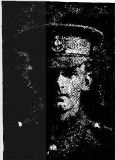
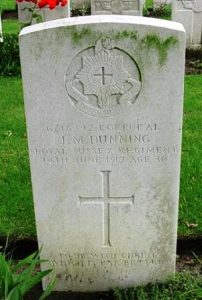
Evan Edwards, Fitter, 137800, Royal Field Artillery. Evan was born at Llandyssil on 28 February 1883, the son of John and Mary Ann Edwards. The family later came to live at Old Church Street, Newtown. Evan left home to find work as a coal miner in South Wales as a young man and in 1906 married Mary Hannah Richards. The couple lived at 1, Gordon Street, Ton Pentre, where Evan found work as a carter. Evan enlisted at Preston into the Royal Field Artillery and was posted to C Battery, 69th Brigade, Royal Field Artillery. The Battery was attached to the 13th (Western) Division and had seen action at Gallipoli with the Division before being evacuated to Egypt in January 1916 and moved to the Suez Canal Defences at Port Said. In March 1916 the Division joined the Tigris Corps in Mesopotamia, to take part in the unsuccessful efforts to relieve the besieged town of Kut al Amara. The Division remained in Mesopotamia for the duration of the war, taking part in hard fighting against the Turks in terrible conditions. In October and early November 1918, parts of 40 Brigade and the Divisional artillery took part in operations as part of “Lewin’s Column”, pushing north towards Turkey, with advance units reaching as far as Altun Kopri when Turkey signed an Armistice on 31 October 1918. Evan survived the war but had become ill, contracting smallpox. He died of smallpox in hospital in Tehran on 13 November 1918. The 35-year-old was buried in Tehran War Cemetery, Iran.
Richard Stuart Edwards, Private, 18939, Canadian Infantry. Richard was born on 11 June 1880, the son of John Edwards and Margaret Edwards, of Springfield, Newtown. He married Caroline Priscilla Edwards at Newtown in 1907 and the couple lived at 15, Canal Road. Richard worked as a carpenter for Jones & Leach at Oswestry and had served for four years with the South Wales Borderers prior to emigrating to Canada just before the war. He enlisted at Valcartier into the 9th Battalion, Canadian Infantry on 23 September 1914. The battalion embarked at Quebec aboard the SS Zealand on 4 October 1914 and upon arriving in Britain became a reserve battalion at Shorncliffe, used to train troops for other Canadian infantry units. On 25 April 1917 Richard embarked for France and was posted to the 10th Battalion, Canadian Infantry. The battalion was attached to the 2nd Canadian Brigade, 1st Canadian Division and was at Mont St. Eloi when Richard joined its ranks, resting after its part in the epic assault on Vimy Ridge just two weeks earlier. The battalion then moved to billets in Ritz to rebuild, spending most of May there before moving to positions near Neuville St. Vaast in the middle of June. To the north, the Passchendaele offensive was opened on 31 July 1917, so as a diversionary measure, the Canadians and British launched a diversionary assault upon Hill 70, near Loos, on 15 August 1917. The 10th Battalion, CEF launched its assault from positions in front of Hersin and advanced behind a rolling barrage of trench mortar and Livens Projector fire. Despite intense German fire, the battalion attained its objectives of the red line before digging in and was hot by a German counterattack. Richard was killed in action during the terrible fighting here that day. The 37-year-old is buried in Loos British Cemetery, France. His brother-in-law, Thomas Henry Habberley, was killed in France in 1915
Hilary Gresford Evan-Jones, Lieutenant, Welsh Regiment. Hilary was born on 22 January 1889, the son of the Reverend Richard Evan-Jones, M.A., Vicar of Llanllwchaiarn, and of Hannah Rose Evan-Jones (nee Evans). He was educated at Charterhouse and at Hertford College, Oxford. He graduated in 1910 and on 5 October that year was commissioned into the 1st Battalion, Welsh Regiment. Hilary was to have been married to Nancy Bolton, the only daughter of Major W. N. Bolton, Commissioner of Kyrenia but his leave was cancelled when the battalion was recalled to England following the outbreak of war. Upon arriving in England, the 1st Welsh joined 84 Brigade, 28th Division. The battalion landed at Le Havre on 18 January 1915, and moved to Ypres, in front of Hill 60. Hilary was mentioned in despatches for crawling out into No Man’s Land and bombing the Germans soon after the battalion took up their front-line positions. On 16 February 1915 the 1st Welsh were in a position near the Bluff, called Z-Trench, when they suffered heavy casualties due to shellfire. Hilary was one of three officers of the 1st Welsh killed that day. He was 26 years old and was buried alongside the two other officers at Chateau Rosendal (now called Bedford House Cemetery), but for some reason his grave was lost, and he is now commemorated on the Ypres (Menin Gate) Memorial, Belgium. (See my book: The Welsh at War: From Mons to Loos & the Gallipoli Tragedy, for further details).
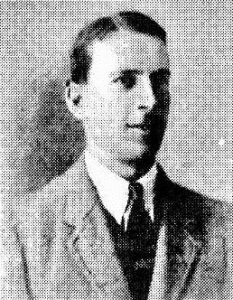
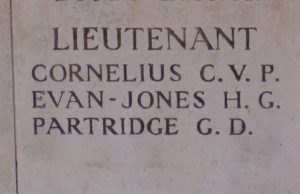
Evans, A E. This man cannot presently be identified, but could be the man below:
Arthur Bertram Evans, Private, 58408, Royal Welsh Fusiliers. Arthur, known as Bertram, was born in Manchester in 1899, the son of Arthur Evans and Lizzie Evans (nee Mountain). By 1911 the family was living at Oak Shop, Llandyssil. Arthur worked as a Goods Clerk for the Cambrian Railways and had served at Montgomery, Newtown, Caersws and Whittington prior to the war. He enlisted at Welshpool into the Montgomeryshire Yeomanry soon after the outbreak of war. On 5 August 1914 the Montgomeryshire Yeomanry was mobilised at Welshpool, as part of the South Wales Mounted Brigade, before moving via Hereford to Thetford, to join the 1st Mounted Division. On 4 March 1916 the 1st Mounted Division sailed for Egypt to join the EEF. Arthur would have been attached to one of the reserve battalions of the regiment before being drafted to Egypt in the winter of 1916-17 to join the regiment. On 4 March 1917 the battalion merged with the Welsh Horse Yeomanry to form the 25th (Montgomery & Welsh Horse Yeomanry) Battalion, Royal Welsh Fusiliers, as part of the newly formed 231 Brigade, 74th (Yeomanry) Division. The Division assembled in Egypt as part of the EEF, before crossing the Suez Canal into the Sinai, and saw its first major action during the Second Battle of Gaza. The battle was a failure, and the EEF was re-organised under a new commander, Sir Edmund Allenby, before launching the Third Battle of Gaza on the night of 31 October 1917. This assault was launched along a winder front, running from Gaza to Beersheba, and this time the EEF prevailed, opening the door to Jerusalem. Due to the terrible casualties suffered by the British on the Western Front in March and April 1918 the Division was recalled to the Western Front and arrived at Marseilles during May 1918. The Division trained near Le Cauroy before taking over positions in the St. Floris Sector, moving into the front line between the La Bassée Canal and the River Lys, with the left resting on the small village of Corbie. The Division faced the recently lost town of Merville, some 3,000 yards away. To the south, the Allies launched their offensive on 21 August 1918, and began the great advance towards the Hindenburg Line. The 74th Division was transferred south to join the offensive and assembled around Beaucourt Chateau before moving into the line near the villages of Lempire and Ronssoy. While the 25th RWF was assembling on 17 August, the Germans launched a barrage of gas shells onto their positions, killing three men and gassing almost 60 more. Undeterred, the battalion moved into positions during the night, and at 05.40 on 18 September 1918 took part in an offensive by the 74th Division, against the outer Hindenburg Line defences. Arthur was killed during heavy fighting near Benjamin Post that day. The 19-year-old is buried in Ronssoy Communal Cemetery, France.
Arthur Richard Evans, Sergeant, 1483, Australian Infantry. Arthur was the son of Thomas Arthur Evans and Harriet Evans, of 26, Bryn Street, Newtown. By 1911 he was lodging at 15, King Street, Hanley, Stoke on Trent, where he worked as a baker and confectioner. Arthur emigrated to Australia in 1913 and found work as a baker and confectioner at Mount Street, Toowong, Brisbane. Arthur enlisted into the 3rd Reinforcements for the 15th Battalion, Australian Infantry at Brisbane on 15 December 1914. The unit embarked from Brisbane, Queensland, aboard HMAT Seang Choon on 13 February 1915 and disembarked in Egypt, joining the 15th Battalion, AIF at Cairo. The battalion was attached to the 4th Brigade, 1st Australian Division and at dawn on 24 April 1915 landed under heavy fire at Anzac Cove, Gallipoli, as part of Winston Churchill’s plan to open a new front to relieve the stalemate on the Western Front and to drive Turkey out of the war. The 15th Battalion was heavily involved in establishing and defending the front line of the ANZAC beachhead and in August attacked Hill 971, as part of the diversionary attach at Anzac to draw Turkish forces away from new landings at Helles. By the end of the year, it had been decided to evacuate the troops off the Gallipoli peninsula and the 1st Australian Division was evacuated in December, returning to Egypt. Arthur suffered several bouts of sickness during his time at Gallipoli and did not re-join the battalion until March 1916, by which time the 4th Brigade had been transferred to the 4th Australian Division. In June 1916 the Australians embarked for France, taking over a section of the front line near Fromelles for a short time. In July 1916 the Australians moved south to the Somme, to join the great Somme offensive and on 5 August the 4th Australian Division relieved the battered 2nd Australian Division at the recently captured Pozieres. Arthur was reportedly awarded a gallantry certificate during the coming days at Pozieres. The Australians then began a series of costly assaults against the strongly defended German position at Mouquet Farm, before being relieved by the Canadian Corps in September and moved to Ypres to rebuild before returning to the Somme and wintering in the front line near Flers. In April 1917 the Australians took part in the Battle of Arras, tasked with an assault against the strongly defended village of Bullecourt, on the Hindenburg Line. The 4th Brigade launched an assault upon the Hindenburg Line at Riencourt on 11 April 1917, but suffered severe casualties, partly because the planned tank support did not materialise. Arthur was killed in action during the fighting that day, one of over 3,000 Australian casualties. The 28-year-old has no known grave and is commemorated on the Villers-Bretonneux Memorial, France.
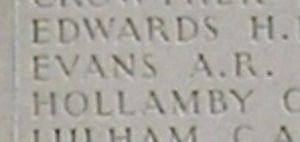
Charles Seymour Evans, Private, 290668, Royal Welsh Fusiliers. Charles was the son of Abraham and Margaret Ann Evans of 16, Frolic Street, Newtown. He worked as a draper prior to enlisting into the 7th Battalion, Welsh Fusiliers at Newtown on 26 September 1914. The battalion was a Territorial unit, which mobilised for war at Newtown in August 1914, as part of North Wales Brigade, Welsh Division and moved to Conway until the end of the month, before moving to Northampton. In December the Division moved to Cambridge and then in May 1915 to Bedford, where the Division was numbered and the formation became 158 Brigade, 53rd (Welsh) Division. On 19 July 1915 the entire Division sailed from Devonport for Imbros and on 9 August 1915 landed at Suvla Bay. The infantry moved off the beaches across the Salt Lake, under shellfire, into the scrub covered Chocolate Hill, but due to a lack of maps and no knowledge of the terrain, many of the units became disorientated, and the situation became chaotic. Charles survived the landings but suffered a contusion to his right foot a month later and was invalided to England via the Hospital Ship Halta. He was drafted out to Egypt in June 1917, but was posted to Bombay, before joining the Base Depot at Kirkee and was then posted to the 8th Battalion, Royal Welsh Fusiliers, which was attached to 40 Brigade, 13th (Western) Division. He joined the battalion in Mesopotamia but took ill soon afterwards and was invalided back to Kirkee. Charles died of tuberculosis at the Deccan British War Hospital, Poona on 13 July 1918. The 30-year-old was buried in Poona, but is commemorated on the Kirkee 1914-1918 Memorial, India.
Evans, E. This man cannot presently identified, however a Thomas Edward Evans, of Newtown, died in 1926 of disease contracted during the war.
Evan Evans, Private, 355865, Royal Welsh Fusiliers. Evan was the son of David and Margaret Evans of 4, Wool Pack, Pool Road, Newtown. He worked as a farm labourer at Rock Farm, Newtown prior to enlisting into the 2/1st Battalion, Welsh Horse Yeomanry on 17 May 1915 and was posted to Norfolk to join the battalion. Evan embarked for Egypt in February 1916, joining the 1/1st Battalion, Welsh Horse Yeomanry, which was by then on the Suez Canal Defences attached to the 1st Mounted Division, having been evacuated from Gallipoli just weeks earlier. On 4 March 1917 the battalion merged with the Welsh Horse Yeomanry to form the 25th (Montgomery & Welsh Horse Yeomanry) Battalion, Royal Welsh Fusiliers, as part of the newly formed 231 Brigade, 74th (Yeomanry) Division. The Division assembled in Egypt as part of the EEF, before crossing the Suez Canal into the Sinai. Evan was killed in action in Palestine, during the advance onto the Sheikh Abbas-Mansura positions, on 17 April 1917. The 23-year-old is buried in Deir El Belah War Cemetery, Israel.
Harold Charles Evans, Private, A/34049, Canadian Infantry. Harold was born on 20 April 1894, the son of Walter Henry Evans and Susannah Catherine Evans (nee Parry), of 47, New Road, Newtown. He worked as a clerk for his father’s drapery business and had enlisted into the 7th Battalion, Royal Welsh Fusiliers in March 1911. Harold emigrated to Canada with his family the following year and found work as a clerk in Calgary, where he enlisted into the local Militia. He then volunteered for the 50th Battalion, Canadian Infantry at Calgary on 30 December 1914. Harold was then posted to the 9th Battalion, CEF, which embarked for overseas at Quebec City, Quebec on 1 October 1914 aboard S. Zeeland, disembarking in England on 18 October before entraining for Shorncliffe Camp. The battalion then became a training unit, and on 3 August 1915 Harold was posted to France, joining the 10th Battalion, CEF, which was at Ypres attached to the 2nd Canadian Infantry Brigade, 1st Canadian Division. The Division was by then a battle hardened one, having seen terrible fighting during the Second Battle of Ypres earlier that year. Although holding a very volatile section of the front line, the Division did not see any major action until the Battle of Mount Sorrel in June 1916, following a German offensive upon their lines. The Germans launched their assault at about 11.00 on 2 June 1916 and broke through the Canadian Lines at Mount Sorrel and Hill 62, so at dawn on the following day, 3 June 1916, the 10th Battalion, CEF launched a counter-attack from Armagh Wood. The battalion suffered terrible casualties, mainly through German artillery fire and was forced to withdraw. Harold had been killed in action during the assault that day. The 22-year-old has no known grave and is commemorated on the Ypres (Menin Gate) Memorial, Belgium.
Jane Elizabeth Evans, Worker, 51329, Queen Mary’s Army Auxiliary Corps. Jane was born on 27 November 1897, the daughter of Richard Evans and Elizabeth Ann Evans of the Church House, Llanllwchaiarn. She worked as a teacher for a while before volunteering to serve with Queen Mary’s Army Auxiliary Corps at Newtown on 16 September 1918 and was posted to Cardiff, before being posted to the RASC MT Depot at Grove Park to work as a Clerk. Jane had not been at Grove Park for long before she took ill, and she died at the Auxiliary Hospital, Woolwich of pneumonia on 27 May 1919. The remains of the 19-year-old were brought home and she was buried in St. David’s Churchyard, Newtown.
John Pryce Evans, Private, 30561, Grenadier Guards. John was the son of Evan Evans and Jane Elizabeth Evans (nee Jerman) of Upper Brimmon, Newtown. He enlisted at Welshpool into the Household Battalion soon after the outbreak of war, but because of his young age, was not drafted to France until the Winter of 1917-18, when he was posted to the 3rd Battalion, Grenadier Guards. The battalion was attached to the 2nd Guards Brigade, Guards Division and was in the Arras Sector when John joined its ranks. The Division was stationed near Gouzeaucourt, with the 3rd Grenadier’s in reserve at Arras, when the German Spring Offensive hit the area on 21 March 1918 and the battalion was hurried forwards into the battle zone where the Division saw heavy fighting over the coming days as the Allied line was driven back. When the fighting calmed down, the Guards Division rebuilt its strength, while to the north the Germans had opened another offensive. The Guards Division remained in the Arras sector over the coming months then, following the famous Australian success at Villers Bretonneux on 8 August. Took part in the great advance which was launched by the Allies along the Somme front on 21 August 1918. The Guards Division then joined the great advance towards the Hindenburg Line, which was broken on 29 September, before sweeping northeast past Cambrai, chasing the retreating Germans over the rivers Selle and the Sambre. By the morning of 4 November 1918, the Guards had reached the village of Villers Pol and began to cross the Rhonelle river over a hastily erected plank bridge. John was killed in action just afterwards when the 3rd Grenadier’s were hit by heavy machine-gun fire whilst advancing upon the Aunelle river. John was 20 years old when he was killed that day and is buried in Frasnoy Communal Cemetery, France.
Thomas Griffith Evans, Private, 17377, King’s Shropshire Light Infantry. Thomas was the son of Thomas and Anne Evans, of Old School House, Tregynon. He married Elizabeth Ann Lloyd in 1911, and the couple resided at Concrete Cottage, Tregynon, where their daughter Marian was born. Thomas enlisted into the King’s Shropshire Light Infantry at Shrewsbury soon after the outbreak of war, and was posted to the 5th Battalion, KSLI. The battalion had formed at Shrewsbury in August 1914, before joining 42 Brigade, 14th (Light) Division at Aldershot. On 20 May 1915 the Division landed at Boulogne, and proceeded to the Zillebeke area, some two miles SW of Ypres, taking over a section of the front line there by 31 May for instruction alongside the 5th Division, and began wiring work, improving the defences of the trenches. By 16 June the Division had moved slightly north, taking over its own section of the front east of Ypres, in the notorious Hooge sector. The Division was to gain an unwanted place in the history books here when, on 30 July 1915, the Germans attacked their front using newly developed flame-throwers, the first time such a terrifying weapon had been used in action. During terrible fighting, the Germans captured the Divisional front-line, and beat off a counterattack, in which the 5th KSLI were involved. The Division then began work improving the new front line before being relieved and moving into support at Vlamertinghe to rebuild. By 23 August the Division had moved back into the line, and began work preparing for a diversionary attack, the Second attack on Bellewaarde, which was to be launched on the same day as the Battle of Loos, to the south, and was intended to divert German attention away from the Loos offensive. At dawn on 25 September 1915, the 5th KSLI launched a frontal assault against the German positions at Bellewaarde but suffered terrible casualties in doing so. Thomas was among over 400 casualties suffered by the battalion alone that day. The 29-year-old has no known grave and is commemorated on the Ypres (Menin Gate) Memorial, Belgium.
William Evans, Corporal, 290285, Royal Welsh Fusiliers. William was born in 1889 in Pencraig, Talley, Carmarthenshire, the son of James Evans. He was raised in a home before finding work at Llandinam some years before the war. William lived as a married man with Nancy Irene Gentle, and their daughter Kathleen was born at Llandinam on 24 November 1914. William enlisted into the 7th Battalion, Royal Welsh Fusiliers at Newtown on 27 August 1914. The battalion was a Territorial unit, which mobilised for war at Newtown in August 1914, as part of North Wales Brigade, Welsh Division and moved to Conway until the end of the month, before moving to Northampton. In December the Division moved to Cambridge and then in May 1915 to Bedford, where the Division was numbered and the formation became 158 Brigade, 53rd (Welsh) Division. On 19 July 1915 the entire Division sailed from Devonport for Imbros and on 9 August 1915 landed at Suvla Bay. The infantry moved off the beaches into the bush, but due to a lack of maps and no knowledge of the terrain, many of the units became disorientated, and the situation became chaotic. The Division was eventually evacuated from Gallipoli in December 1915, moving to Egypt to join the EEF, and helped guard the Suez Canal before taking part in operations to drive the Turks out of the Sinai. The EEF then turned its attention onto driving the Turks out of Palestine, and on 26 March 1917 launched its first offensive against the coastal city of Gaza, which guarded the road to Jerusalem. Initial gains during the day were lost when the assaulting divisions lost touch with each other, and communication broke down when a thick fog cloaked the battlefield. William was posted as missing, believed killed in action during the fighting that day. The 27-year-old has no known grave and is commemorated on the Jerusalem Memorial, Israel. His partner Nellie, later moved to 8, Frolic Street, Newtown with their daughter Kathleen, before emigrating to Canada. She married Harold Harry, and the couple returned to Newtown, where Nellie died in 1986.
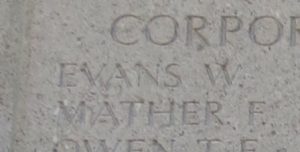
William Richard Evans, Private, 55282, Royal Welsh Fusiliers. William was the son of Edward and Elizabeth Evans, of Holly Bush, Sarn, Kerry. He worked as a Grocer at Newtown prior to the war. William enlisted at Newtown into the 7th Battalion, Royal Welsh Fusiliers, and after completing his training was drafted to France at some time in the winter of 1916-17, joining the 13th Battalion, Royal Welsh Fusiliers, which was attached to 113 Brigade, 38th (Welsh) Division. The Division was in position in the Canal Bank sector at Boesinghe when William joined its ranks. The infantry battalions of the Division were carrying out the normal pattern of rotation in the trenches, four days in the front, four in support and four in reserve, whilst also working on trench improvement, digging new trenches, and carrying out regular patrols and trench raids. On 31 July 1917 the Division launched its famous assault on the Pilckem Ridge, capturing Iron Cross and reaching its objective of the Steenbeek, then played a supporting role in the Battle of Langemarck. The Division was transferred to the Sailly-sur-la-Lys sector in September and remained in the area over the winter before being moved to positions north of Albert, at Bouzincourt Ridge, at the end of March 1918, relieving the battered 2nd and 47th Divisions. It held this sector, again carrying out minor operations and trench raids, over the coming months, before taking part in the great offensive of 21 August 1918, and began its advance towards the Hindenburg Line. The 13th RWF launched its part of the Divisions assault two days later, on 23 August, reaching its assembly point at the railway cutting east of Albert at 01.45. The battalion advanced at 04.55, attacking on a frontage of 2,000 yards, with its objectives running from a line from Crucifix Corner, Aveluy, to the Albert to Bapaume Road. The men took their objectives, despite heavy resistance, capturing two field guns, 16 machine-guns, 150 prisoners and countless supplies, but had suffered the loss of one officer and twenty other ranks killed, five officers and 117 other ranks wounded. Nineteen men were missing. William was among those killed in action during the day. The 36-year-old is buried in Bapaume Post Military Cemetery, Albert, France.
Clement Finney, Private, 55341, Royal Welsh Fusiliers. Clement was born in 1899, the son of Morris Meyrick Finney and Sarah Finney, of Corner House, Forden. The family had moved to 5, Dysart Terrace, Newtown by 1911, where Clement worked as a shirtmaker. He enlisted into the Royal Welsh Fusiliers at Newtown, and after completing his training, was drafted to France in the winter of 1916-17, joining the 14th Battalion, Royal Welsh Fusiliers, which was attached to 113 Brigade, 38th (Welsh) Division. The Division was holding the Canal Bank sector at Boesinghe, north of Ypres, where it had moved to following its assault on Mametz Wood in July 1916. The infantry battalions of the Division then began carrying out the normal pattern of rotation in the trenches, four days in the front, four in support and four in reserve, whilst also working on trench improvement, digging new trenches, and carrying out regular patrols and trench raids. On 31 July 1917 the Division launched its famous assault on the Pilckem Ridge, capturing Iron Cross and reaching its objective of the Steenbeek, then played a supporting role in the Battle of Langemarck. The Division was transferred to the Sailly-sur-la-Lys sector in September and remained in the area over the winter before being moved to positions north of Albert, at Bouzincourt Ridge, at the end of March 1918, relieving the battered 2nd and 47th Divisions. It held this sector, again carrying out minor operations and trench raids, over the coming months, before taking part in the great offensive of 21 August 1918, and began its advance towards the Hindenburg Line. On 22 August the 14th RWF moved through Albert, crossing the River Ancre, and joined the 13th RWF in an assault towards Pozieres Ridge, joining 114 Brigade, to the left flank. The battalion pushed through La Boiselle, towards Contalmaison over the coming days, skirting Mametz Wood on 25 August, and capturing Bazentin-le-Grand. By 27 August the Division had reached Longueval, capturing the ruined village and reaching the Longueval to Flers Road. Clement was killed in action at Longueval on the following day, 28 August 1918, whilst the 14th RWF was holding the recently captured village. The 29-year-old has no known grave and is commemorated on the Vis-en-Artois Memorial, Haucourt, France. Clement is not commemorated on the Forden war memorial. One of his brothers, Percy, had also served with the Royal Welsh Fusiliers during the war, and died in 1922.
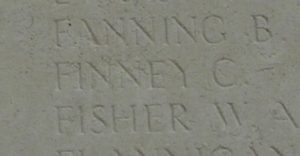
Joseph Gladwyn Ford, Private, 77928, Durham Light Infantry. Joseph, known as Joe, was the son of William Henry Ford and Mary Ann Ford (nee Evans), of 2, Coedyfridd Cottage, Canal Road, Newtown. The family had moved to Dyson Hill, Honley, Huddersfield by 1911 after William had gained work in a clothing mill. Joe began work as a hoistman in the mill when he was old enough to work. He enlisted at Halifax into the Training Reserve on 3 April 1917 and was posted to Seaham Harbour, County Durham for training. Joe was drafted to France on 6 February 1918 and was posted to the 1/6th Battalion, Durham Light Infantry, which at Ypres was attached to 151 Brigade, 50th (Northumbrian) Division. The Division was at the time holding the Habourg Sector of the line, on Passchendaele Ridge, but at the end of February 1918 was relieved and moved to the St. Omer are for a short rest period, before being transferred to the St. Quentin sector, near Brie. At dawn on 21 March 1918 the Germans opened a massive offensive along the section of Western Front running south from Croisilles to La Fère and broke through in several places. As a result, over the coming days the Allies were forced to withdraw, under heavy pressure. The Guards Division had entered the fray on the opening day and withdrew from the Brie area towards Foucaucourt over the coming days. The Division put up a gallant stand during the Actions at the Somme Crossings, and then at the Battle of Rosieres, allowing other units to withdraw. After suffering terrible casualties, the Division moved north to Flanders to rest and rebuild, but on 9 April the Germans launched an attack in Flanders, around the Lys Valley, and the Guards Division was caught up in the thick of the fighting once more. The 3rd Grenadiers had been in billets in Éstaires when the Germans attacked, suffering six officers killed when one of their billets suffered a direct hit. The battalion put up a defensive line but at 09.00 was hit hard by the German stormtroopers. Joe was killed in action during the terrible fighting around Éstaires that day, 9 April 1918. The 19-year-old has no known grave and is commemorated on the Ploegsteert Memorial, Belgium.
Matthew Sharratt Ford, Corporal, 2595, Australian Machine Gun Corps. Matthew was the son of Alfred Ford, JP, and Fanny Ford (nee Williams), of Ivycot, Abermule. He decided to emigrate to Australia, embarking at London aboard the SS Omrah on 6 December 1912, and disembarked at Melbourne. Matthew then became a sheep shearer at Killarney, Coogee, New South Wales. He enlisted into the Australian Imperial Force at Liverpool, NSW on 16 May 1915, joining the 8th Reinforcements for the 3rd Battalion, AIF, and embarked at Sydney with the unit aboard HMAT Runic on 9 September 1915. The unit disembarked at Alexandria, after their voyage through the Suez Canal, and on 2 November 1915 Matthew was among a number of men sent as drafts to the 3rd Battalion at Gallipoli. The Gallipoli troops were evacuated soon afterwards, and Matthew went back to Alexandria with the 3rd Battalion, and on 12 March 1916 he was posted to the newly formed 1st Brigade Machine Gun Company. On 22 March 1916 his unit embarked for Marseilles and moved with the 1st Australian Division to the Western Front, to positions near Armentieres. The Division was sent to the Somme in July and saw heavy fighting at Pozieres and Mouquet Farm. Matthew was hospitalised in October, suffering from Scabies, re-joining his unit two weeks later. The 1st Division followed the German withdrawal to the Hindenburg Line in February 1917 and in April 1917 took part in the Battle of Bullecourt. Matthew was wounded at Bullecourt, being shot in the shoulder, and was evacuated to the 3rd Field Ambulance before being sent to No 3 Stationary Hospital at Rouen. On 20 April he was transferred to England and treated at the 1st Southern General Hospital. He then enjoyed two weeks leave before returning to duty, joining the Australian Depot at Weymouth on 29 May. On 26 June Matthew embarked at Folkestone for France and on 8 July re-joined his battalion in time to take part in the Passchendaele offensive. In February 1918 there was some re-organisation of units in France, and Matthew’s unit became part of the 1st Battalion, Australian Machine Gun Corps, still attached to the 1st Australian Division, which was near Merris, in Flanders. On 9 April 1918 the Germans launched the second phase of their Spring offensive in the area, and the Australians became caught up in desperate fighting near Merris. Matthew was killed in action here on 17 April 1918, aged 27. He is buried in Le Grand Hasard Military Cemetery, Morbecque, France.
Leonard Gibson, Captain, General List. Leonard was born in Glasgow in 1865. He was a long serving soldier, who had joined the 24th Regiment of Foot, South Wales Borderers, as a young man and had served for many years, having enlisted at Brecon, and saw action in the Burma Campaign of 1887-89. Leonard married Alice Mary Hurst, of Emsworth, Hampshire in 1895, then by 1901 the couple had moved to 2, Tradyddan Terrace, Newtown, where Leonard was Sergeant Major of the 5th Volunteer Battalion, South Wales Borderers, which later became the 7th Battalion, Royal Welsh Fusiliers, as well as being Scoutmaster in the town. He retired from the army on 31 October 1903 after gaining the position of Manager at the Royal Welsh Warehouse in Newtown. Following the outbreak of war, Leonard volunteered to serve again with the colours and was granted a commission into the army, being placed on the General List. Leonard does not appear to have served overseas during the war. He died at Exeter on 1 December 1918, aged 53 and was buried in Exeter Higher Cemetery, Cornwall.
Franklin Macaulay Gillespie, Lieutenant Colonel, South Wales Borderers. Franklin was born at Colchester on 19 August 1872, the son of Lieutenant Colonel Franklin Gillespie and Mrs Harriet Eliza Phillis Gillespie (nee Freeth). He was educated at Dover College and at Sandhurst before being commissioned as Second Lieutenant into the South Wales Borderers on 25 July 1891. Over the coming years Franklin rose through the ranks, seeing active service with the West African Frontier Force and in Niger, before fighting in the Boer War. Upon his return from South Africa, he became Adjutant of the 5th Volunteer Battalion, South Wales Borderers at Newtown. He married Agnes Rose Pryce-Jones, the daughter of Sir Pryce Pryce-Jones, of Newtown, at Newtown on 27 July 1905 and in July 1908 he was posted to the 2nd Battalion, South Wales Borderers at Aldershot, embarking for South Africa again with the battalion soon afterwards. Franklin was transferred to the 1st Battalion, South Wales Borderers at Chatham, before being appointed to the Command of the Regimental Depot at Brecon. Following the outbreak of war he gained command of the newly raised 4th Battalion, South Wales Borderers. The battalion formed at Brecon before moving to Park House Camp, near Tidworth to join 40 Brigade, 13th (Western) Division. The Division embarked at Avonmouth on 29 June 1915 and sailed for Gallipoli, arriving at Mudros on 12 July before landing on the shores of Gallipoli on 15 July. He gallantly led the battalion’s assault on Sari Bair on 6 August but was killed in action during the Turkish counterattack on 9 August 1915. The 42-year-old was buried in the 39th Field Ambulance Cemetery, however his grave was subsequently lost, and he is now commemorated on the Helles Memorial, Gallipoli. Franklin was posthumously mentioned in despatches.
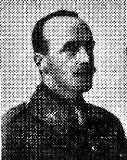
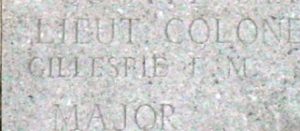
Albert Gittins, Private, 53618, Royal Welsh Fusiliers. Albert was the son of Edward and Esther Gittins, of Brickfield House, Stone Street, Newtown. He worked as a Grocers Errand Boy prior to the war. He enlisted at Newtown into the 7th Battalion, Royal Welsh Fusiliers, but after completing his training was drafted to France, joining the 1st Battalion, Royal Welsh Fusiliers. When Albert arrived in France the battalion was on the Somme, attached to 22 Brigade, 7th Division. The Division had taken part in the opening assault of the Somme offensive on 1 July 1916, advancing from positions near Bois Francais, near Fricourt, and capturing the village of Mametz, one of the few successes of 1 July 1916. The battalion then took part in further attacks to push forwards, to the south of Mametz Wood, and upon being relieved, witnessed the troops of the 38th (Welsh) Division moving forward to launch its assault on Mametz Wood. On 14 July, with the wood taken, the 7th Division moved back into the line, with orders to capture Bazentin-le-Petit, before taking part in the terrible attacks on High Wood over the coming days. On 22 July the 1st RWF was relieved, moving back into reserve to rest and rebuild at La Chaussee. By 12 August the battalion had moved forwards to Dernancourt, and on 26 August marched further forward, to take part in the Divisions assault on Ginchy. The Division saw heavy fighting over the coming days, before the 1st RWF had another short break, but on 1 September the battalion received orders to push forwards again to launch a fresh assault on Ginchy from Montauban Alley. On 3 September 1916 the 1st RWF launched its assault, but suffered severe casualties, with over 200 officers and men killed, wounded, or missing. The Division was then relieved before moving north to the Ploegsteert Sector to rest and rebuild. The Division moved back to the Somme sector at the end of November 1916, taking over positions near Beaumont Hamel. Albert was badly wounded soon afterwards and was evacuated to the Casualty Clearing Station at Puchevillers, where he died of his wounds on 9 December 1916. The 20-year-old is buried in Puchevillers British Cemetery, France.
William John Goodman, Private, 64450, Suffolk Regiment. William was from Pwllheli, and had married Mary Evans, of Penygloddfa, Newtown prior to the war. He worked as a carrier and by 1915 had moved with Mary to Back Street, Penparke, Aberystwyth, where their son was born. William enlisted into the army and was posted to the 15th Battalion, Suffolk Regiment. Mary returned to Newtown with their son and moved into Queens Head Yard, Welshpool Road. The 15th Suffolk’s had formed in Egypt on 15 January 1917, joining 230 Brigade, 74th (Yeomanry) Division and fought in the Palestinian Campaign before the Division was sent to France in May 1918, moving to positions in Flanders. William was transferred to 363 Prisoner of War Company, Labour Corps at some time after this move. He survived the war but died of influenza at the 3rd Canadian General Hospital, France on 17 January 1919. He is buried in Terlincthun British Cemetery, Wimille, France.
Frank Richard Goodwin, Private, 17674, King’s Shropshire Light Infantry. Frank was the son of Thomas Mansell Goodwin and Cecilia Mary Goodwin (nee Finch), of Severn Street, Newtown. He worked as an assistant schoolmaster at Shrewsbury prior to the war and enlisted there into the King’s Shropshire Light Infantry. Frank embarked for France on 25 August 1915, joining the 1st Battalion, King’s Shropshire Light Infantry, which was attached to 16 Brigade, 6th Division. Frank joined the battalion at Poperinghe on 4 September, following a particularly nasty tour of duty in the trenches at Hooge. He experienced his first tour in the front line near Potijze soon afterwards. The 6th Division remained in the Ypres Salient over the winter of 1915-16, in atrocious conditions which saw the 1st KSLI spend Christmas in the front line. On 16 March 1916 the battalion was relieved and entrained for Calais, where it was billeted in a rest camp for ten days before moving to Herzeele, where many of the officers attended a series of special courses. By 7 April the battalion had moved back to Poperinghe, then by 17 April had taken over positions near Brielen, on the Canal Bank. On the night of 21-22 April, the 1st KSLI carried out a meticulously planned attack upon the Mortjelde Estaminet, recapturing a section of trenches which had been lost to the Germans some weeks before. Frank was killed in action during the attack, on the morning of 22 April 1916. The 33-year-old is buried in Essex Farm Cemetery, Belgium.
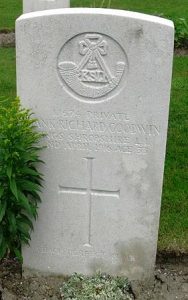
Charles Henry Green, Private, 655, Royal Welsh Fusiliers. Charles was the son of Robert Henry Green and Ellen Green (nee Pattison), of 9, Neville Street, Oakhill, Stoke-On-Trent. He came to Newtown to work as a billiard marker and bootman at the Bear Hotel. Charles enlisted into the 7th Battalion, Royal Welsh Fusiliers at some time prior to the war. The battalion was a Territorial unit, which mobilised for war at Newtown in August 1914, as part of North Wales Brigade, Welsh Division and moved to Conway until the end of the month, before moving to Northampton. In December the Division moved to Cambridge and then in May 1915 to Bedford, where the Division was numbered and the formation became 158 Brigade, 53rd (Welsh) Division. On 19 July 1915 the entire Division sailed from Devonport for Imbros and on 9 August 1915 landed at Suvla Bay. The infantry moved off the beaches across the Salt Lake, under shellfire, into the scrub covered Chocolate Hill, but due to a lack of maps and no knowledge of the terrain, many of the units became disorientated, and the situation became chaotic. Charles was killed in action during the advance on the following day, 10 August 1915. The 25-year-old has no known grave and is commemorated on the Helles Memorial, Gallipoli.
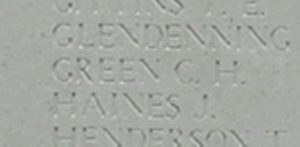
John Wallace Griffiths, Private, 830543, Canadian Infantry. John was born on 14 June 1897, the son of John and Elizabeth Griffiths, of 37, Broad Street, Newtown. He emigrated to Canada with his brother Daniel just prior to the war and the two young men found work as farmers, lodging at 631 Stella Avenue, Winnipeg. John enlisted into the 144th Battalion, Canadian Infantry at Winnipeg on 3 January 1916, but became ill soon after and on 17 February was hospitalised at St. Roch’s Hospital, St. Boniface, Manitoba, where he was found to have contracted scarlet fever. He died there soon afterwards, on 20 February 1916, aged 18. John was buried in Brookside Cemetery, Winnipeg, Canada. His brother, Daniel, served with the Canadian Field Artillery during the war, bringing his young American fiancée home to Newtown after the war, where they married in 1921. The couple returned to America, where Daniel died on 17 February 1953.
Henry Harold Gwynne, Private, 291116, Royal Welsh Fusiliers. Henry was the son of Henry Maurice Gwynne and Alice Emily Gwynne (nee Spencer), of Davies Court, Frolic Street, Newtown. He worked as a carpenter prior to enlisting at Newtown into the 3/7th Battalion, Royal Welsh Fusiliers on 5 July 1915 and was posted to Park Hall Camp, Oswestry, to join the battalion. Henry embarked at Devonport on 26 February 1916 and upon disembarking at Alexandria was posted to the 1/7th Battalion, Royal Welsh Fusiliers, which was attached to 158 Brigade, 53rd (Welsh) Division. The Division had been evacuated from Gallipoli in December 1915, moving to Egypt to join the EEF, and helped guard the Suez Canal before taking part in operations to drive the Turks out of the Sinai. The EEF then turned its attention onto driving the Turks out of Palestine, and on 26 March 1917 launched its first offensive against the coastal city of Gaza, which guarded the road to Jerusalem. Initial gains during the day were lost when the assaulting divisions lost touch with each other, and communication broke down when a thick fog cloaked the battlefield. Henry was killed in action during the fighting that day. The 20-year-old has no known grave and is commemorated on the Jerusalem Memorial, Israel.
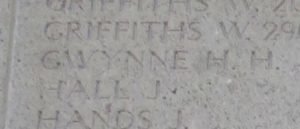
Thomas Henry Habberley, Private, 6334, Royal Welsh Fusiliers. Thomas was the son of Charles and Margaret Habberley, of Barrow, Shropshire. He had enlisted into the 1st Battalion, Royal Welsh Fusiliers on 5 February 1900, and had served with the battalion in South Africa during the Anglo-Boer War. Thomas had completed eight years’ service, mainly in India, before leaving the army, and moved to Newtown where he worked as a Butler for Mr Phillips at Plas Cae Crwn. He married Mary Elizabeth Edwards on 30 January 1911 and the couple moved to Llanidloes prior to the war, where Thomas gained a position as a Postman in the town. As an Army Reservist, Thomas was mobilised as soon as war was declared, attesting again at Wrexham on 4 August 1914 and was initially posted to the 3rd Battalion, Royal Welsh Fusiliers. He embarked for France on 20 October 1914, joining the 1st Battalion, Royal Welsh Fusiliers, which was at Ypres attached to 22 Brigade, 7th Division. The Division was embroiled in heavy fighting, during the First Battle of Ypres, when Thomas joined the ranks of the 1st RWF. After the fighting calmed down, the battalion wintered in the Ypres Salient, and on 10 March 1915 saw its next major action during the Battle of Neuve Chapelle. After suffering heavy losses, the battalion was relieved and moved into billets at Fort D’Esquin, to rest and refit. By 7 April the 1st RWF had moved to reserve billets at Rue du Bacquerot, and four days later relieved the Royal Scots in the trenches to begin a routine tour in the line, being relieved on 14 April. The battalion enjoyed another period out of the line until 6 May, when it moved forwards again, to take part in the Battle of Aubers Ridge, where the Division launched an assault against the village of Aubers on 9 May 1915. The 1st RWF remained in the assembly trenches, in support of the assault, but the attacking troops made no gains, so the battalion was not called upon, and marched to billets in Essars. On 15 May 1915 the 7th Division took part in another assault, against the village of Festubert. The 1st RWF attacked on the following day, 16 May 1915, ordered to seize the line running from the Rue Quinque to Rue D’Ouvert. The battalion seized the German front and second lines but suffered terrible losses in doing so. Thomas was killed in action during the assault that day. The 34-year-old has no known grave and is commemorated on the Le Touret Memorial, Richebourg-L’avoue, France. His widow, Mary, later moved to Coventry with their three children and remarried.
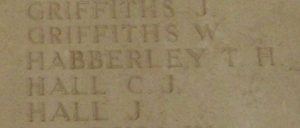
Albert George Halford, Regimental Sergeant Major, 13852, South Wales Borderers. Albert, known as George, was born in Monaghan, Ireland on 6 December 1871, the son of James Halford and Sarah Jane Halford (nee Moran). He enlisted into the 24th Regiment of Foot, South Wales Borderers, at Brecon on 24 September 1888 and served continuously with the regiment over the coming years, serving in Gibraltar, India and during the Boer War. Upon his return to England, he took up the position of Sergeant-Instructor at Brecon. George married Elizabeth Norah Llewellyn, of Brecon, in London in 1904 and the couple had three children. George then transferred to the 7th Battalion, Royal Welsh Fusiliers at Newtown upon the formation of the Territorial Force on 1 April 1908 and became sergeant-instructor in the town. On 31 March 1914 George relinquished his position at Newtown, intending to retire, but when war erupted in August 1914 he re-joined his old regiment, and was posted to the 4th Battalion, South Wales Borderers. The battalion was formed at Brecon in August 1914, moving to Park House Camp, near Tidworth to join 40 Brigade, 13th (Western) Division. On 29 June 1915 the Division sailed from Avonmouth for Mudros, then on 15 July landed at Cape Helles, Gallipoli, relieving the 29th Division. After spending two weeks in the line at Helles, the Division was evacuated and returned to Mudros, before being landed at ANZAC Cove between 3 and 5 August 1915, to join up with the Anzac’s, with orders to take part in a diversionary offensive, to divert Turkish attention away from further landings at Suvla. George was wounded during the capture of Damakjelik Bair on 6 August and was evacuated by Hospital Ship to Alexandria. He died of his wounds there on 12 August 1915. The 43-year-old is buried in Alexandria (Chatby) Military & War Memorial Cemetery, Egypt.
Ernest Hammond, Private, 204483, Royal Welsh Fusiliers. Ernest was born at Newtown in 1879, the son of John and Mary Hammond. He enlisted into the Royal Welsh Fusiliers at Newtown and was posted to the 4th (Reserve) Battalion, Royal Welsh Fusiliers. The battalion had formed at Wrexham in September 1914, joining the Welsh Division at Northampton, then moved to Cambridge before joining 203 Brigade, 68th (2nd Welsh) Division at Northampton. In July 1915 the Division moved to Bedford, spending over a year there before moving to Aldeburgh., then to Henham Park, Halesworth. Ernest never served overseas during the war but remained on home service. He died of disease at the Lord Derby War Hospital, Warrington on 19 March 1919, aged 40. His remains were conveyed to Shrewsbury, and he was buried in Shrewsbury General Cemetery.
Percy Hanson, Lance Corporal, R/19638, King’s Royal Rifle Corps. Percy was the son of William Hanson and Louisa Hanson (nee Partington), of Oldham, Lancashire. He was living at Newtown by 1911, but following the outbreak of war, returned to Manchester to enlist into the King’s Royal Rifle Corps. He was drafted to France early in 1916, joining the 16th Battalion, King’s Royal Rifle Corps, which was attached to 100 Brigade, 33rd Division. The Division saw its first major action during the Battles of the Somme, from July 1916 onwards. In the Spring of 1917, the Division moved to the Arras sector, where it fought at the Battle of the Scarpe and at Bullecourt, before heading to Ypres later that summer, and took part in the Third Battle of Ypres, seeing heavy fighting during the Battle of the Menin Road and at Polygon Wood. Percy was later transferred to the 17th Battalion, King’s Royal Rifle Corps, which was attached to 117 Brigade, 39th Division. The Division had also fought at the Third Battle of Ypres, before moving south, entraining at Proven on 25 January 1917 for Mericourt-L’Abbe. Within days the Division had moved forwards and taken over the Heudecourt Sector, near Gouzeaucourt, and the infantry battalions of the Division began the usual routine of trench rotation. At dawn on 21 March 1918 the 17th KRRC was at Sorel, having just been relieved, when the Germans opened a terrific artillery bombardment all along the front line. Soon afterwards hordes of German stormtroopers attacked along a stretch of the line running south from Croisilles to La Fère, smashing the British lines. The 17th KRRC remained at Stand-To throughout the day, but on the following day, following further German advances, was thrown into action near Tincourt. Percy was wounded and taken prisoner by the Germans at sometime soon afterwards, and sadly died as a prisoner of war soon afterwards, on 25 March 1918. The 30=year-old is buried in Villers-Faucon Communal Cemetery Extension, France.
Henry Harper, Private, 5898, Royal Welsh Fusiliers. Henry was born in 1969, the son of Thomas and Sarah Harper, of Llanllwchaiarn. He worked as a labourer prior to enlisting into the Royal Welsh Fusiliers at Wrexham on 25 May 1886 and over the coming eight years served in India with the 1st Battalion, Royal Welch Fusiliers. Upon returning home in 1898, Henry left the army, but on 16 April 1903 re-enlisted into the Royal Garrison Artillery and was posted to Fort Widley, Portsmouth. He then served overseas again, in Malta and in South Africa, before retiring from the army and became a poor law officer in Sheffield. Following the outbreak of war, Henry re-enlisted into his old regiment, the Royal Welsh Fusiliers, in Sheffield on 28 August 1914 and was posted to the 3rd Battalion, Royal Welsh Fusiliers at Wrexham. On 19 January 1915 Henry embarked for France, joining the 1st Battalion, Royal Welsh Fusiliers, which was attached to 22 Brigade, 7th Division. He served in France over the coming months, seeing action during the Battles of Neuve Chapelle and Aubers Ridge, before being invalided home and transferred to the 3rd Garrison Battalion, Royal Welsh Fusiliers. He then transferred to the 23rd Battalion, Cheshire Regiment, before being drafted back out to France in May 1918 and joined the 16th Battalion, Manchester Regiment. By now his age had caught up with him and Henry was discharged from the army as medically unfit on 15 August 1918, returning home. He eventually died at Wrexham in the winter of 1929, aged 60, after a lifetime of service with the army. Henry is not commemorated by the CWGC as he died so long after the war. This is the only Henry Harper with ties to Newtown that I can presently find.
Thomas Harold Harper, Lance Corporal, 10661, Hampshire Regiment. Thomas was the son of John Harper and Sarah Jane Harper (nee Bowen), of 3 Park Street, Newtown Road, Newtown. He worked as a Draper in London for several years prior to the war. Thomas enlisted into the Hampshire Regiment at Islington soon after the outbreak of war and on 28 July 1915 embarked at Avonmouth aboard the requisitioned liner, HMT Royal Edward. Thomas was among some 1,367 officers and men who boarded the ship as reinforcements for the 29th Division, which had suffered terrible casualties during the landings on Gallipoli on 25 April. Thomas was destined to join the 2nd Battalion, Hampshire Regiment. Royal Edward steamed past the Lizard on the evening of 28 July, and had arrived at Alexandria on 10 August, before steaming for Mudros on the island of Lemnos. On the morning of 13 August 1915, Royal Edward passed the British hospital ship Soudan, which was heading in the opposite direction, and both ships were spotted by the German submarine UB-14. Soon afterwards, the Germans fired a torpedo at the unsuspecting Royal Edward, which exploded and sunk within six minutes, with the loss of some 935 lives. Thomas was just 24 years old when he was lost during the sinking of Royal Edward that day. He has no known grave and is commemorated on the Helles Memorial, Gallipoli.
Arthur Harold Harris, Lieutenant, Royal Welsh Fusiliers. Arthur was the son of David Arthur Harris and Harriet Matilda Harris (nee Hamer), of Rose Cottage, Cefnmawr, Newtown. He enlisted into the Royal Engineers on 23 August 1913 war and embarked for France on 23 August 1914, joining the 97th Field Company, Royal Engineers. Arthur then took part in the retreat from Mons to the Marne but was invalided home after being wounded by shell fragments. Upon his recovery he was drafted to Egypt and in 1917 returned home after gaining a commission into the 4th Battalion, Royal Welsh Fusiliers. Upon completing his officers training at Kinmel Park he was posted to France in May 1918, joining the 16th Battalion, Royal Welsh Fusiliers, which was attached to 113 Brigade, 38th (Welsh) Division. The Division had moved to positions north of Albert, at Bouzincourt Ridge, at the end of March 1918, relieving the battered 2nd and 47th Divisions. It held this sector, carrying out minor operations and trench raids, over the coming months. Arthur was badly wounded whilst supervising a working party on 3 July 1918. He was evacuated to the 3rd Canadian Stationary Hospital at Gézaincourt where he died of his wounds on the following day, 4 July 1918. The 25-year-old was buried in Gézaincourt Communal Cemetery Extension, France.
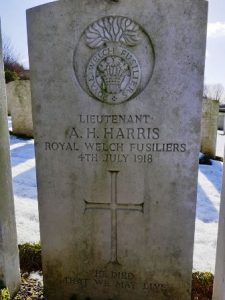
Edmund Seymour Hughes, Sapper, 127458, Royal Engineers. Edmund was the son of William Hughes and Sarah Jane Hughes (nee Morris), of 31, market Street, Newtown. Following the death of his father in 1897, Edmund went to Liverpool where he found work for the GPO and lodged with one of his elder sisters, Annie Edith Jones. In the summer of 1900, he was promoted to a Sorting Clerk and Telegraphist, before spending a short time at sea with the Mercantile Marine. On 31 March 1915 Edmund married Florence Griffiths at Liverpool, then found work ashore as a telegraphist for a newspaper. Edmund enlisted into the Royal Engineers at Liverpool on 3 December 1915, stating that he had previously served with the Montgomeryshire Yeomanry, and was placed on the Army Reserve. He was mobilised on 16 October 1916 and posted to the Signals Depot at Fenny Stratton for training. On 24 April 1917 Edmund embarked for East Africa and disembarked at Dar es Salaam on 18 June 1917, before being posted to the Base Signal Depot. Just six weeks later, Edmund was taken ill and was admitted to the 19th Stationary Hospital at Kilwa, suffering from Malaria. His condition worsened and he contracted dysentery so on 10 August 1917 Edmund was sent by the Hospital Ship Neuralia to the South African General Hospital at Dar es Salaam. Sadly, he died there of dysentery on 28 August 1917. The 34-year-old was buried in Seaview Cemetery Ocean Road, Dar es Salaam. In 1968 Edmund’s grave was exhumed and he was reburied in Dar es Salaam War Cemetery Tanzania.
John Edward Hughes, Private, G/3847, The Queen’s Royal West Surrey Regiment. John was the son of David Hughes and Mary Hughes, of 13, New Church, Newtown. He left home as a young man to work as a collier in South Wales and married Violet Louisa Ford of Newtown, whilst home in 1908. The family was residing at 47, Trealaw Road, Trealaw when war broke out and John enlisted at neighbouring Tonypandy into the Royal Welsh Fusiliers on 4 December 1914. His pregnant wife Violet later returned to Newtown with their three children and set up home there at Ivy Cottage, Stone Street, where their fourth child was born. Just after enlisting, John was transferred to the 6th Battalion, The Queen’s Royal West Surrey Regiment, joining the battalion at Purfleet where it was attached to 37 Brigade, 12th (Eastern) Division. The Division moved to Aldershot in February 1915 to complete its training, before landing in France on 3 June 1915, moving to Outtersteene before taking over the Frelinghiem Sector, south of Ploegsteert Wood. Once the Division had completed its instruction alongside the more experienced 27th Division, its infantry battalions began the routine spells of trench rotation, normally spending four days in the front line, four in support and four in reserve. The Division carried out a diversionary attack on 25 September 1915, to draw German attention away from the main offensive at Loos, just to the south and just days later was transferred south to Loos to take part in the offensive there, seeing heavy fighting during the actions of the Hohenzollern Redoubt. The Division wintered in the Loos sector and remained there over early months of 1916. On 17 April 1916 the 6th Queen’s relieved the 11th Middlesex in the trenches to begin a routine tour in the front line. John was killed in action here on 19 April 1916, when the Germans fired a salvo of trench mortar rounds into the battalions’ trenches, killing five men. The 36-year-old has no known grave and is commemorated on the Loos Memorial, France.
John Evans Hughes, Driver, 213574, Royal Field Artillery. John was born at Mochdre in 1884, the illegitimate son of Mary Hughes. His mother married Edward Mills in 1888, so John was raised by his uncle at Upper Pwllbyllydd Farm, near Knighton. John then worked as a waggoner at Darwonno Farm, near Ynysybwl by 1911. He returned home to Newtown to marry Mary Isabella Pugh on 15 January 1915 and the couple set up home at Dulley Bank, Llaithddu, Newtown. John enlisted into the Royal Field Artillery at Knighton on 2 February 1917 and was posted to the barracks at Preston for training. He was drafted to France in May 1917, joining the 72nd Brigade, Royal Field Artillery but within a week his work on the artillery guns had damaged his hearing and John was invalided to the 138th Field Ambulance. After further treatment at the 3rd Canadian General Hospital at Boulogne, John re-joined the Base Depot on 18 June, but took ill and was diagnosed as suffering from pyrexia. He was hospitalised at the 4th Convalescent Depot, where he contracted influenza, and upon his recovery was transferred to the Labour Corps on 14 September 1917. John was wounded soon afterwards, suffering gunshot wounds to his back, and was evacuated via the 6th Australian Field Ambulance to the 17th Casualty Clearing Station. John was then deemed to be unfit for further service at the front, so returned home where he joined the 403rd Agricultural Company, Labour Corps, near Edinburgh. He took ill again just prior to the Armistice and was taken to the Ceres Auxiliary Hospital, at Edinburgh, where he died of influenza on 15 November 1918. The body of the 34-year-old was brought home and he was buried in St. David’s Churchyard, Newtown.
Archibald Edward Clayton Humphreys, Private, 290070, Royal Welsh Fusiliers. Archibald was the son of Evan Humphreys and Mary Jane Humphreys (nee Clayton), of Hilcrest, Dolfor Road, Newtown. He worked as a Tailor and had enlisted into the 7th Battalion, Royal Welsh Fusiliers, Territorials, on 19 May 1911 and attended the annual TA summer camps every year up until the declaration of war in August 1914. Archibald had health problems, so did not embark for overseas with the battalion in 1915. He remained on home service throughout the war, after being transferred to the 3/4th (Reserve) Battalion, Royal Welsh Fusiliers at Oswestry, and was found in September 1917 to be suffering from heart disease. Despite this, he remained with the battalion, which by then was at Kinmel Park, but moved to Herne Bay in July 1918. Archibald took ill whilst stationed under canvas at Herne Bay and was sent to the Military Hospital there, where he died of pneumonia on 17 October 1918. The body of the 23-year-old was brought back home, and he was buried in Newtown and Llanllwchaiarn Cemetery five days later.
Ernest Evan Humphreys, Lieutenant, Royal Naval Volunteer Reserve. Ernest was born at Newtown on 23 June 1889, the son of Evan Humphreys and Mary Frances Humphreys (nee Abbott). By 1911 he was living at Montpellier, St Leonards East Sheen, Mortlake, where he worked as an Architect. Ernest enlisted into the Royal Naval Volunteer Reserve on 24 June 1916, especially to serve with the Hydrophone Service and was posted to HMS Gunner at Granton in Scotland for training. Ernest was then granted a temporary commission as Sub Lieutenant with the Royal Naval Volunteer Reserve on 17 September 1916, joining the Royal Naval Base at HMS Tarlair, which was at Hawkcraig Point in the coastal village of Aberdour, Fife. The work carried out at HMS Tarlair was top secret and consisted of research into submarine detection, by fitting special sets of hydrophones to large numbers of drifters and motor launches in the Auxiliary patrol, which formed the Royal Navy’s anti-submarine force. Ernest survived the war and was posted to Portsmouth after the Armistice. Sadly, he fell down the cable hold of a drifter at Portsmouth on 14 January 1919, fracturing his skull and died just afterwards. The 29-year-old was buried in Weston Mill Cemetery, Plymouth.
Sydney George Humphreys, Private, 3461, The Prince of Wales’s Own (West Yorkshire Regiment). Sydney was the son of Rowland Humphreys and Mary Ellen Humphreys (nee Morris), of 59, Ladywell Street, Newtown. The family moved to 36, Cook Street, Laisterdyke, Bradford at some time after 1911 and Sydney enlisted at Bradford into the 1/6th Battalion, West Yorkshire Regiment soon after war was declared. The battalion mobilised at Belle Vue Barracks, Bradford in August 1914, joining the 1st West Riding Brigade, West Riding Division. The Division spent the winter in York and in March 1915 moved to Gainsborough, prior to embarking for France on 14 April 1915, before taking up a portion of the front line in the Laventie sector. On 15 May the formation became renumbered to 146 Brigade, 49th (West Riding) Division. Sydney had not gone overseas with the battalion originally but embarked for France on 20 August 1915 among a draft of reinforcements for the battalion. By the time he arrived the following day, the Division had taken over positions on the Canal Bank, North-West of Ypres. The Division remained here over the coming weeks, with its infantry battalions carrying out the usual system of trench rotation. On 1 October the 1/6th West York’s relieved the 1/7th West York’s in the front line, to begin a routine tour in the trenches. Sydney was killed by sniper fire the following day, 2 October 1915. The 18-year-old has no known grave and is commemorated on the Ypres (Menin Gate) Memorial, Belgium.
Wallace Gilbert Humphreys, Aircraftman 1st Class, 98264, Royal Air Force. Wallace was the son of Richard and Sarah Jane Humphreys, of Plantation Farm, Bolbro, Abermule. He married Tryphena Elizabeth Williamson 1 June 1914 and the couple set up home at 37, Commercial Street, Newtown. Wallace enlisted into the Royal Flying Corps on 3 October 1917 and was posted to France to serve with 8 Squadron. The Squadron had been in France since 15 April 1915, equipped with the B.E.2c, but it also operated a fighter flight equipped with a mixture of aircraft, including the B.E.8 and the Bristol Scout, based at airfields near Saint-Omer. The Squadron saw plenty of action throughout the war, and after the merger of the RFC and the RNAS to form the Royal Air Force, became attached to the Tank Corps, flying patrols in support of the Tank Corps attacks during the Battle of Amiens. In December 1918, after the Armistice, the Squadron re-equipped with Bristol F.2 Fighters. Wallace took ill after this, and he died of broncho-pneumonia at Charleroi on 20 February 1919, aged 30. Wallace is buried in Charleroi Communal Cemetery, Belgium.
Edward Jarman, Private, M2/116500, Royal Army Service Corps. Edward was born in Atherton, Lancashire in 1887, the son of William and Ann German. His father was originally from Newtown and appears to have altered the family name from German to Jarman prior to returning to his hometown, and resided at 3, Stone Street, Newtown. Edward resided at Rallt Isa, Llanfair Caereinion prior to enlisting into the Army Service Corps, and was posted to the Motor Transport section for training. He was drafted to France on 28 September 1915 and served on the Western Front for the rest of the war, returning home after the Armistice. Edward died, probably of influenza, at Epsom Military Hospital, Surrey on 12 April 1919. The remains of the 32-year-old were brought home for burial in St. David’s Churchyard, Newtown.
John Henry Jarman, DCM, Sergeant, 15087, Grenadier Guards. John was the son of John Jarman and Annie Jarman (nee Tallis), of 3, Stone Street, Newtown. He worked as a Tailor at the Royal Welsh Warehouse in Newtown prior to enlisting into the Grenadier Guards prior to the war. By the time war erupted was serving with the 1st Battalion, Grenadier Guards at Warley. In September the battalion moved to Lyndhurst, to join 20 Brigade, 7th Division and on 7 October 1914 landed at the coastal port of Zeebrugge. Unfortunately, the port was already in the process of falling to the Germans, so the 7th Division began the long march to Ypres, where it became the first British Division to hold the city. The Division fought during the First Battle of Ypres, where it helped stop the German advance through Belgium. Following the closure of the battle, the 7th Division moved south to Flanders and the following year took part in the Battle of Neuve Chapelle and in the later Battles of Aubers Ridge and Festubert. On 4 August 1915 the Guards Division was formed, and the 1st Grenadier’s joined the 3rd Guards Brigade, Guards Division at Loos and the newly formed Division saw its first major action during the Battle of Loos on 25 September 1915. The Guards Division remained in the area during the coming months, taking part in the subsequent Action of Hohenzollern Redoubt. After brief spells at Calais and Ypres, in July 1916 the Division moved to the Somme and took part in heavy fighting during the Battle of Flers-Courcelette, and then at the Battle of Morval, capturing Lesboeufs Village. The Division remained here for the winter, and in March 1917 took part in the advance caused by the German Retreat to the Hindenburg Line. Later that year the Division moved north to Ypres, taking part in the opening offensive at the Battle of Pilckem Ridge and saw further fighting during the latter stages of the Passchendaele offensive. By November the Guards had moved south to the Cambrai Sector and saw heavy fighting following the German counterattack. The Division remained in the area over the final winter of the war and was stationed near Gouzeaucourt when the German Spring Offensive hit the area on 21 March 1918. The Guards took part in the desperate rear-guard action which followed, withdrawing to Boisleux-St. Marc before the Germans switched their attentions to Flanders. The Guards Division remained here over the coming months, carrying out the usual routine trench warfare. On 8 August the Australian Corps advanced towards the town of Villers Bretonneux and won a mighty battle there which broke the will of the German army. On 21 August the British launched a general advance on the Somme, and the Guards Division launched its offensive from the Arras sector. John was killed in action just four days into the great offensive, on 25 August 1918. The 26-year-old has no known grave and is commemorated on the Vis-en-Artois Memorial, Haucourt, France. John had been awarded the Distinguished Conduct Medal just prior to his death. His award was published in the London Gazette of 5 December 1918 and read: ‘During an attack by his battalion on high ground his company was held up by machine-gun fire, his captain and another officer becoming casualties. He at once took charge of all men he could collect, and brought them forward under heavy fire, capturing five machine guns and thirty prisoners, afterwards gaining his objective some 1,000 yards ahead. His magnificent example of courage and fortitude was worthy of the highest praise.’
Jenkins, H. This man cannot presently be identified.
Trevor Llewelyn Jenkins, Private, 995, Royal Welsh Fusiliers. Trevor was the son of Edward Jenkins and Sarah Maria Jenkins (nee Owen), of 15, Old Church Street, Newtown. He had enlisted at Newtown into the 7th Battalion, Royal Welsh Fusiliers several years prior to the war. The battalion was a Territorial unit, which mobilised for war at Newtown in August 1914, as part of North Wales Brigade, Welsh Division and moved to Conway until the end of the month, before moving to Northampton. In December the Division moved to Cambridge and then in May 1915 to Bedford, where the Division was numbered and the formation became 158 Brigade, 53rd (Welsh) Division. On 19 July 1915 the entire Division sailed from Devonport for Imbros and on 9 August 1915 landed at Suvla Bay. The infantry moved off the beaches across the Salt Lake, under shellfire, into the scrub covered Chocolate Hill, but due to a lack of maps and no knowledge of the terrain, many of the units became disorientated, and the situation became chaotic. Trevor was killed in action on the following day, 10 August 1915. The 24-year-old has no known grave and is commemorated on the Helles Memorial, Gallipoli.
Albert Jones, Private, 7806, Welsh Regiment. Albert was born into a travelling family at Newtown in 1882, the son of Thomas and Harriett Jones. The family had moved to South Wales by 1891 and were living at Bridgend, but by 1901 the family had moved to Fairfield Encampment, Llandybie. Albert married Lily Holland at Cwmamman on 10 May 1909 and by 1911 the couple had set up home at Brynteg, Cross Hands, where Albert had gained work as a colliery labourer. Albert had then enlisted into the 2nd Battalion, Welsh Regiment at some time prior to the war. The battalion embarked for France at the outbreak of war, attached to 3 Brigade, 1st Division and moved to the Belgian frontier near Mons. The Division then took part in the Battle of Mons, and in the subsequent retreat to the Marne, where the German drive on Paris was stopped. The Division then fought at the Battle of the Aisne, where William Fuller of the 2nd Welsh gained the first award of the Victoria Cross of the war to a Welshman. The BEF was then moved north early in October to defend the city of Ypres and the section of front-line running southwards to the Aubers Ridge. The 1st Division took up positions around the village of Langemarck and on 21 October took part in a general advance. Unfortunately, the Germans counter-attacked, in conjunction with further attacks to the south, and the 1st Division became caught up in terrible fighting. After a lull the following day, the Germans attacked the 1st Division in large numbers on 23 October, suffering terrible casualties through the accurate rifle fire of the British troops. The 1st Division was relieved by a French Division that night and took up positions east of Ypres along the Menin Road. The Germans attacked here in force again on 29 October and the 1st Division came under intense pressure. Again, a brief respite followed, but on 31 October the Germans attacked in overwhelming numbers and the 1st Division was almost annihilated as it bravely stood its ground and held on, despite heavy losses, when a gallant counterattack by the Worcester’s relieved the besieged survivors of the 2nd Welsh and 1st SWB, broke the German line and saved the city of Ypres. The shattered survivors remained here over the coming days, desperately digging a strong defensive line under intense shellfire. Albert was killed in action here on 6 November 1914, during a day of desperate fighting which saw a desperate counterattack by the 7th Cavalry Division lead to its annihilation. Albert was 34 years old when he was killed that day. He has no known grave and is commemorated on the Ypres (Menin Gate) Memorial, Belgium. Albert does not appear to be commemorated on any war memorial at Newtown, Llandybie or Cross Hands.
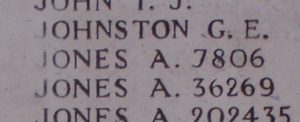
Albert Jones, Driver, 76858, Royal Field Artillery. Albert was born at Newtown in 1881, the son of Margaret Jones. His mother later resided at 3, Smithfield Terrace, Llanidloes. Albert enlisted at Pontypridd into the Royal Field Artillery at some time prior to the war. He embarked for France on 11 September 1914 with the 112th Battery, 24th Brigade, Royal Field Artillery, which was attached to the 6th Division. The Division landed at St Nazaire in time to reinforce the hard-pressed BEF on the Aisne before the whole army was moved north into Flanders. The Division took part in the Action of Hooge during June 1915, and in the summer of 1916 moved to the Somme, taking part in the Battle of Flers-Courcelette, the Battle of Morval and the Battle of Le Transloy. The following year saw the Division at Arras, where it fought at the Battle of Hill 70. The Division then fought during the Battle of Cambrai later in the year, before wintering on the Hindenburg Line. In the spring of 1918, the Division was one of those hit hard by the German Offensive on the Somme, which had been launched on 21 March, and the Division took part in the heavy fighting which ensued. The battered Division was moved from the line, and went to Flanders to rest, but the following month the Germans launched another offensive on the Lys on 9 April, and the Division became caught up in desperate fighting once again. By August 1918 the Allies had recovered sufficiently to be able to launch their own attacks on the Germans, and after a brilliant victory at Villers Bretonneux on 8 August, attacks were launched at Albert on 21 August. The 6th Division took part in the Advance in Flanders, before moving south to join the offensive towards the Hindenburg Line. Albert’s battery entrained at Droglandt on 2 September and detrained at Mericourt, near Corbie, the following day. By 13 September the 24th Brigade, RFA had advanced to Trefcon, to join the great offensive, setting up its guns behind St. Quentin Wood. Albert was one of four men killed by German counter-battery fire on the following day, 14 September 1918. The 37-year-old is buried in Trefcon British Cemetery, Caulaincourt, France. (Albert is commemorated on the Newtown War Memorial as B Jones).
Albert Edward Jones, Private, 290728, Royal Welsh Fusiliers. Albert was the son of Robert and Agnes Jones, of 58, Ladywell Street, Newtown. He worked as a farm labourer at Montgomery prior to returning to Newtown to enlist into the 7th Battalion, Royal Welsh Fusiliers on 12 October 1914. Albert was posted to the 3/7th RWF at Park Hall, Oswestry for training, and on 31 May 1916 embarked at Devonport aboard the HT Kalyan, disembarking at Alexandria on 11 June 1916, before joining the 1/7th Battalion, Royal Welsh Fusiliers, which was attached to 158 Brigade, 53rd (Welsh) Division. The Division had been evacuated from Gallipoli in December 1915, moving to Egypt to join the EEF, and helped guard the Suez Canal before taking part in operations to drive the Turks out of the Sinai. The EEF then turned its attention onto driving the Turks out of Palestine, and on 26 March 1917 launched its first offensive against the coastal city of Gaza, which guarded the road to Jerusalem. Initial gains during the day were lost when the assaulting divisions lost touch with each other, and communication broke down when a thick fog cloaked the battlefield. Albert was posted as missing during the battle that day and was afterwards adjudged to have been killed in action on that date. The 19-year-old has no known grave and is commemorated on the Jerusalem Memorial, Israel.
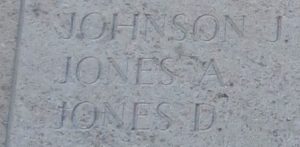
Arthur Edward Jones, Private, 44260, Royal Welsh Fusiliers. Arthur was the son of David Owen Jones and Hannah Ellen Jones (nee Griffiths), of Brynteg, New Mills, Manafon. His mother died when he was a child, and his father remarried to Edith Sophia Tudor in 1908. Arthur worked as a farm labourer prior to the war. He enlisted into the Royal Welsh Fusiliers at Welshpool on 24 May 1916 and was posted to the 12th Battalion, Royal Welsh Fusiliers at Kinmel Park. He embarked for France on 9 December 1916, joining No 5 Infantry Base Depot at Rouen, and from there was posted to the 16th Battalion, Royal Welsh Fusiliers, which was in the Canal Bank sector at Ypres, attached to 113 Brigade, 38th (Welsh) Division. The infantry battalions of the Division were hard at work, digging deep dugouts and improving their trenches when Arthur arrived, but conditions were wet and he soon became ill, spending much of March 1917 in hospital. He re-joined the battalion prior to the Divisions assault on the Pilckem Ridge on 31 July 1917 but was wounded in the head and face during the night of 29/30 July and evacuated to the 4th Casualty Clearing Station before the assault was launched. Arthur was evacuated back to England aboard the Hospital Ship SS St. David, a former Fishguard to Rosslare ferry, on 2 August and spent over a year recovering. After fully recovering from his wounds, Arthur embarked for France again at Southampton on 9 October 1917, and re-joined No 5 Infantry Base Depot at Rouen. On 14 October he was posted to the 1st Battalion, Royal Welsh Fusiliers, which was attached to 22 Brigade, 7th Division, and joined the battalion in camp at Moolenaker, where it was rebuilding following heavy losses at Ypres. The battalion then moved back into the front lines on 25 October, for operations against Gheluvelt. On the following day the battalion moved forwards behind the attacking troops and helped consolidate the gained ground. Arthur was killed on the following day, 28 October 1917. The 18-year-old has no known grave and is commemorated on the Tyne Cot Memorial, Belgium.
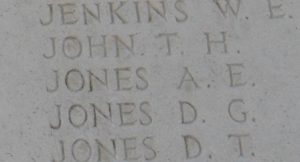
Cornelius Pryce Jones, Gunner, 108230, Royal Field Artillery. Cornelius was the son of Albert Edward Jones and Ann Jones, of Cwmberllan, Sarn, Newtown. He married Martha Annie Griffiths, of Lower Pennygelly, Kerry, at Newtown in 1916. Cornelius enlisted into the Royal Field Artillery in Newtown, and after completing his training was posted to France, joining the 29th Division Ammunition Column, Royal Field Artillery. The Division was a very experienced unit, having fought at Gallipoli in 1915 and throughout the Somme offensive of 1916. Cornelius probably joined the Division early in 1917, soon after his marriage. The Division followed the German withdrawal to the Hindenburg Line in March 1917, before being relieved from the Somme sector and had a brief rest before moving to the Arras sector, where it took part in the Battle of Arras, suffering heavy casualties around Monchy-le-Preux. The Division then moved north to the Ypres Salient at the end of June and trained ready to take part in the Passchendaele offensive, which was launched on 31 July 1917. The 29th Division moved into the Langemarck sector, taking over positions which had been hard won by the 38th (Welsh) Division during the opening days of the offensive, and suffered terribly in the Flanders mud. Cornelius was wounded towards the end of September, possibly during a barrage of gas shell that hit the Division whilst it was in reserve positions. He was evacuated to the 61st Casualty Clearing Station, Belgium, where he died of his wounds on 2 October 1917, aged 27. He is buried in Dozinghem Military Cemetery, Belgium.
Elliott Seymour James Parry Jones, Guardsman, 3550, Welsh Guards. Elliott, known as James, was the son of Evan and Martha Jones, of Newtown. His parents died when he was very young and James and his brother William were raised by family at Fron Dolfor, Llanllwchaiarn. James worked as a collier at Abersychan prior to the war before returning to North Wales and enlisted into the Welsh Guards at Wrexham. He was drafted to France in the summer of 1917, joining the 1st Battalion, Welsh Guards, which was at Ypres attached to the 3rd Guards Brigade, Guards Division. The Guards Division took part in the Battle of Pilckem Ridge on 31 July 1917, attacking to the north of the 38th (Welsh) Division, as part of the opening offensive of the Third Battle of Ypres. The Division then enjoyed a brief rest before seeing further fighting around the Houthulst Forest on 10 October. Soon afterwards the Guards Division was relieved and moved south to the Cambrai sector, to take part in the great Battle of Cambrai. The battle opened on 20 November 1917, with the British employing large numbers of tanks in the opening attack. The Hindenburg Line was breached at Masnières, but the Germans counterattacked on 30 November, regaining their lost ground, and creating a salient in the British lines around Flesquières. The Guards Division had only joined the action four days prior to the German counterattack and became caught up in desperate fighting around Gouzeaucourt on 1 December 1917 as it desperately fought to avoid a German breakthrough. James was killed in action during the fighting that day. The 28-year-old has no known grave and is commemorated on the Cambrai Memorial, France.
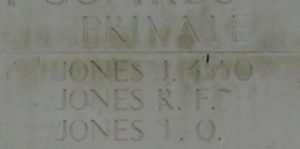
Eric Charles Jones, Private, 7674, South African Infantry. Eric was the son of Charles Clement Jones and Sarah Jones (nee Thomas) of the Lion Hotel, Newtown. He emigrated to South Africa prior to the war and enlisted there into the 1st Regiment, South African Infantry. Following the outbreak of war, the South African Government raised four infantry regiments from the four provinces of the Union. The 1st Regiment troops were from the Cape and were in the main middle class, well-educated men. The Regiments joined the 1st South African Infantry Brigade, which moved to France in the summer of 1916, coming under the command of the 9th (Scottish) Division. The Brigade’s first major action was during the capture of the village of Longueval and during the desperate fighting in Delville Wood on 15 July 1916, where the Brigade was almost annihilated. The South African Memorial stands inside Delville Wood to this day. Eric survived the carnage in Delville Wood, but was killed later in the Somme offensive, on 17 October 1916. The 21-year-old was originally buried on the battlefield together with several other soldiers, but his grave was recovered off the battlefield after the war and Eric was re-interred in Warlencourt British Cemetery, France.
Frank Jones, Private, 203286, Royal Welsh Fusiliers. Frank was the son of Isaac and Martha Elizabeth Jones, of 40, Sheaf Street, Pool Road, Newtown. He worked as a hairdresser prior to enlisting into the 7th Battalion, Royal Welsh Fusiliers at Newtown on 20 October 1914. The battalion was a Territorial unit, which mobilised for war at Newtown in August 1914, as part of North Wales Brigade, Welsh Division and moved to Conway until the end of the month, before moving to Northampton. In December the Division moved to Cambridge. In April 1915 Frank was transferred to the 2/7th Battalion, Royal Welsh Fusiliers, which was at Northampton attached to 203 Brigade, 68th (2nd Welsh) Division. The Division moved to Bedford in July 1915 and in September 1916 moved to Southwold. On 8 January 1917 Frank was drafted to France and was transferred to the 1/4th Battalion, Royal Welsh Fusiliers, which was the Pioneer Battalion to the 47th (2nd London) Division. Frank joined the battalion at the Pioneer Camp southeast of Ypres among a draft of 75 men and would have immediately begun work with the battalion at Railway Dugouts soon afterwards. The Division remained here until after the Battle of Messines Ridge on 7 June 1917 and on 15 June the 4th RWF left the Pioneer Camp and marched to Chippawa Camp on the La Clytte to Reninghelst Road to begin work in a different sector. The Third Battle of Ypres opened on 31 July 1917 and the men of the 4th RWF heard the roar of the opening artillery barrage from their camp that morning. On 15 August the battalion moved to the St. Omer area for a brief rest then moved back to Ypres to Belgian Chateau where the men began work along the Menin Road, digging tunnels and dugouts and constructing a light railway. The Division was relieved on 19 September and began to move south to the Arras Sector, to take part in the forthcoming Battle of Cambrai. The men of the 4th RWF began work on the Arras to Gavrelle Road, erecting screens and improving trenches. The Battle of Cambrai opened on 20 November 1917, initially with great success. The 47th Division took over the front line near Bourlon Wood on 29 November, relieving the shattered 62nd Division. Throughout the night the Division was subjected to an intensive artillery bombardment, then at dawn on the following morning the Germans counterattacked. The men of the 4th RWF, in the Hindenburg Line at Flesquières, were ordered to lay down their pioneer tools and pick up their rifles, reverting to their former role of infantrymen and were plunged into a desperate defensive action over the coming days. Frank was killed in action here on 3 December 1917. The 20-year-old has no known grave and is commemorated on the Cambrai Memorial, Louverval, France.
George Harold Price Jones, Lieutenant, King’s Shropshire Light Infantry. George was the son of John Stephen Jones and Hannah Jones (nee Price), of Bridge Street, Newtown. He enlisted into the 1st Battalion, Welsh Guards soon after its formation at the White City by the Royal Warrant of 26 February 1915. The new regiment took part in the changing of the guard ceremony for the first time on St. David’s Day, 1 March 1915 before embarking for France, landing at Le Havre on 18 August 1915, where it became attached to the 3rd Guards Brigade, Guards Division. George took part in the Welsh Guards first major action, during the Battle of Loos, soon afterwards, where the battalion suffered heavy casualties at Hill 70. The Guards Division then took part in the Action of the Hohenzollern Redoubt before having a brief rest in the Calais area. The Division then moved to the Ypres Salient and held the line at Potijze for several months. At the end of July 1916, the Division withdrew from Ypres and moved to the Somme, before holding the line north of the Ancre for a short period. George was then commissioned as Second Lieutenant into the King’s Shropshire Light Infantry and joined the 7th Battalion, King’s Shropshire Light Infantry at Méaulte on 18 August. The battalion was attached to 76 Brigade, 3rd Division and was rebuilding following heavy losses at Bazentin Ridge. On 23 August the Division moved out of the line to rest and moved to Noeux-les-Mines, near Loos. After a month there, the Division moved back into a rest area for further training before moving back south to the Somme and by 12 November took over trenches at Serre. On the following day, 13 November 1916, the Division launched an assault against the German positions at Serre, suffering terrible casualties. The Division wintered in the Serre sector and in January transferred to the Arras Sector. During May 1917 the Division took part in the First and Second Battles of the Scarpe, then at the Battle of Arleux and the Third Battle of the Scarpe, where it captured the village of Roeux. The Division then moved north to Ypres and saw heavy fighting again during the Battle of the Menin Road and the Battle of Polygon Wood. In November the Division moved south again and saw more heavy fighting during the Battle of Cambrai. The Division wintered in the area and was hit hard following the launching of the German Spring Offensive on 21 March 1918, seeing heavy fighting as the British line was driven back. The battered Division was then relived and moved north to Flanders to rebuild. On 9 April 1918 the Germans launched another offensive, along the Lys Valley. The 3rd Division was ordered forward and on 12 April met the Germans near the La Bassée Canal, where heavy fighting raged over the coming days. The shattered Division then moved to Locon, and the fighting slowed down over the coming weeks as German attention turned elsewhere. George was killed on 30 May 1918 whilst the 7th KSLI was in the process of being relieved following a routine spell in the trenches. The 21-year-old was buried in Sandpits British Cemetery, Fouquereuil, France.
George Henry Jones, Private, 3848, The Queen’s (Royal West Surrey Regiment). George was the son of George Henry Jones and Ellen Jones, of 1, Park Place, Park Street, Newtown. He left home as a young man and found work as a collier in Trealaw. George then enlisted at Tonypandy into the 6th Battalion, The Queen’s (Royal West Surrey Regiment) on 3 December 1914 and joined the battalion at Purfleet, where it was attached to 37 Brigade, 12th (Eastern) Division. George embarked for France with the battalion on 1 June 1915 and the entire 12th Division moved to the Armentieres Sector for trench initiation before taking over positions south of Ploegsteert Wood at Le Bizet. The Division took part in a diversionary attack here on 25 September 1915, to divert German attention away from the main offensive to the south at Loos, but the attack only consisted of lighting smoke candles and firing an artillery barrage. Several days later the Division moved to the Loos Sector and began work digging new trenches along the Loos to La Bassée Road before taking over the line at Vermelles and took part in heavy fighting during the actions of the Hohenzollern Redoubt from 12 October. The Division remained in this sector over the coming weeks as the fighting at Loos died down, spending a grim winter in the waterlogged trenches before being relieved on 11 December and moved back into reserve. By 11 January 1916 the Division had taken over the line near Windy Corner, Cuinchy before moving just north into the Festubert Sector. George was badly wounded in the head during a terrible day on 19 March 1916, when the Germans poured down a heavy artillery barrage onto the Divisions lines, before blowing two underground mines and launching an infantry assault which was beaten off. He was evacuated to the 1st Casualty Clearing Station where he died of his wounds on the following day, 20 March 1916. The 21-year-old is buried in Chocques Military Cemetery, France.
Harold Jones, Private, 10994, Duke of Wellington’s (West Riding Regiment). Harold was the son of Mrs Mary Jones of 42, Frankwell Street, Newtown. He was working at Huddersfield when war erupted and enlisted there into the 8th Battalion, Duke of Wellington’s (West Riding Regiment). The battalion had formed at Halifax before moving to Belton Park, Grantham to join 34 Brigade, 11th (Northern) Division, but later transferred to 32 Brigade in the same Division. On 1 July 1915 the Division sailed from Liverpool, landing at Alexandria, before moving on to Mudros, completing concentration by 28 July 1915. The Division landed at Suvla Bay, Gallipoli on 7 August 1915 and began to advance through the thick scrub before attacking Lala Baba Hill. Harold was killed at Lala Baba on 13 August 1915. The 19-year-old has no known grave and is commemorated on the Helles Memorial, Gallipoli.
Henry Jones, Private, 201221, Royal Welsh Fusiliers. Henry was the son of Arthur and Deborah Jones, of 6, Stone Terrace, Stone Street, Newtown. He enlisted at Newtown into the 7th Battalion, Royal Welsh Fusiliers, but upon being drafted to France in the Spring of 1917 was transferred to the 19th Battalion, Royal Welsh Fusiliers, which was attached to 119 Brigade, 40th (Bantam) Division. Late in 1916 the Division moved south to the Somme, and fought at the Battle of the Ancre, before remaining in the sector over the winter. In March 1917 the Germans withdrew to their shortened line, called the Hindenburg Line, and the 40th Division was among the units which followed the withdrawal. Later in the year the Division took part in the Battle of Cambrai and launched an attack on Bourlon Wood on 23 November 1917. The attack was carried out by 119 Brigade, led by the 12th SWB and 19th RWF. The 17th Welsh was in support for the initial assault, but was soon ordered to advance, to support the two attacking battalions. Heavy fighting raged within the wood over the coming days, with the 18th Welsh also being thrown forwards into the fight, and the Division suffered terribly. The battered Division was relieved by the 62nd Division on the night of 25-26 November and moved back to Beaumetz before marching to Bienvillers to begin refitting. On 2 December the Division moved back into the line in the Bullecourt Sector and on 14 December the 19th RWF moved into the front line, relieving the 12th SWB, with detailed orders to carry out a trench raid against the Germans the following day to gain intelligence and to capture prisoners for interrogation. On the evening of 15 December 1917, the battalion sent out a raiding party, split into two groups. Henry was killed in action during the operation, which was carried out successfully. The 39-year-old is buried in Croisilles Railway Cemetery, France.
Hugh Thomas Jones, Corporal, 201215, The Queen’s Own Cameron Highlanders. Hugh was born at Carrog, Merionethshire in 1886, the son of John and Mary Jones. The family had moved to 11, Llanfair Road, Newtown by 1890 and Hugh’s father work in the town as a Draper. Hugh left home as a young man and lodged in Islington, where he worked as a lace salesman. He married Louisa Gertrude Quenzer, the daughter of German immigrants, at Islington in the Spring of 1914 and the couple set up home at Elim Cottage, Oakfield Road, Croydon. Hugh enlisted into the East Surrey Regiment at Wandsworth and upon being drafted to France was transferred to the 7th Battalion, Cameron Highlanders. The battalion was attached to 44 Brigade, 15th (Scottish) Division and had been in France since July 1915. By the time Hugh joined the battalion, the 15th Division had gained a reputation as being one of the most formidable in the British Army, having seen heavy fighting during the Battle of Loos in September 1915, and in Spring 1916, the Division was involved in German gas attacks near Hulluch, where it fought a dogged defence of the Kink position. The Division had taken part in brutal fighting throughout the Somme offensive in the Summer of 1916 and during the final stages of the Somme offensive, during the Attacks on the Butte de Warlencourt. By May 1917 the Division was at Arras, and fought at the First Battle of the Scarpe, and then at the Second Battle of the Scarpe, where it captured Guemappe. The Division then moved north to Ypres, where it took part in the Battle of Pilckem Ridge, and the Battle of Langemarck. At the end of August, the 15th Division moved out of the Ypres Salient and entrained for Arras, before taking over a section of front-line in the Arras sector. The Division did not take part in the Battle of Cambrai, as its sector remained relatively quiet whilst the battle raged just to the southeast, so its infantry battalions carried on with the normal routines of trench rotation. On 27 December 1917 the 7th Cameron Highlanders relieved the 8th Seaforth Highlanders in the Divisional front-line. Hugh was killed in action there on the following day, 28 December 1917. The 31-year-old is buried in Faubourg D’Amiens Cemetery, Arras, France.
John Edward Jones, Private, 83290, Welsh Regiment. John was born in Kerry in 1900, the son of Pryce Jones and Mary Jones. The family later resided at the Elms Inn, Newtown. John worked as a Drapers Assistant prior to enlisting into the 53rd (Young Soldier’s) Battalion, Welsh Regiment at Welshpool on 19 November 1917. John then spent two months on the Army Reserve before being mobilised on 22 January 1918 and sent to Kinmel Park to join the battalion for training. On 20 July 1918 John was posted to the 3rd Battalion, Welsh Regiment, before embarking for France on 26 August 1918, joining No 5 Infantry Base Depot, and on 30 August joined the 14th Battalion, Welsh Regiment, which was attached to 114 Brigade, 38th (Welsh) Division. The Division was near Morval, having launched its part of the great Allied offensive from the Aveluy Wood sector on 21 August 1918, and had crossed the old Somme battlefields of the 1916 offensive during the previous days. John would have joined the battalion after its assault on Morval on 1 September, probably while it was holding trenches near Sailly-Saillisel. Three days later the 14th Welsh famously forced the crossing of the Canal du Nord at Manancourt, allowing the rest of the Division to cross. The 14th Welsh then went into reserve to rest and train, before coming back into the line on 17 September in readiness to assault Gouzeaucourt. On 18 September 1918 the Division launched an assault on the Gouzeaucourt defences, and the 14th Welsh, in conjunction with 114 Brigade, captured Heather Trench. John was killed in action during the fighting that day. The 18-year-old has no known grave and is commemorated on the Vis-en-Artois Memorial, Haucourt, France.
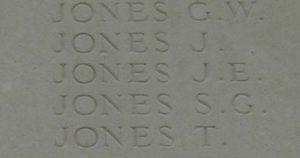
John Rowland Jones, Private, 290255, Royal Welsh Fusiliers. John was the son of John Rowland Jones and Annie Jones, of 23, Doll Street, Machynlleth. He worked as a stone cutter at Newtown prior to enlisting into the 7th Battalion, Royal Welsh Fusiliers at Newtown on 9 August 1914. The battalion was a Territorial unit, which mobilised for war at Newtown in August 1914, as part of North Wales Brigade, Welsh Division and moved to Conway until the end of the month, before moving to Northampton. In December the Division moved to Cambridge and then in May 1915 to Bedford, where the Division was numbered and the formation became 158 Brigade, 53rd (Welsh) Division. On 19 July 1915 the entire Division sailed from Devonport for Imbros and on 9 August 1915 landed at Suvla Bay. The infantry moved off the beaches across the Salt Lake, under shellfire, into the scrub covered Chocolate Hill, but due to a lack of maps and no knowledge of the terrain, many of the units became disorientated, and the situation became chaotic. After the fighting died down, the winter rolled in, and the men first had to endure torrential downpours, which flooded the trenches, before the snow hit, and many men began falling ill in the terrible conditions. The Division was eventually evacuated from Gallipoli in December 1915, moving to Egypt to join the EEF, and helped guard the Suez Canal before taking part in operations to drive the Turks out of the Sinai. The EEF then turned its attention onto driving the Turks out of Palestine, and on 26 March 1917 launched its first offensive against the coastal city of Gaza, which guarded the road to Jerusalem. Initial gains during the day were lost when the assaulting divisions lost touch with each other, and communication broke down when a thick fog cloaked the battlefield. John was killed in action during the assault that day. The 20-year-old is buried in Gaza War Cemetery. He is also commemorated on the Newtown war memorial.
Norman Jones, Private, 63499, Canadian Infantry. Norman was born on 19 February 1887, the son of William and Christina Jones, of 43, Frankwell, Newtown. He married Ellen Breese at Newtown in 1912 and soon afterwards the couple emigrated to Canada, where Norman gained work as a leather dresser. He enlisted at Edmonton, Alberta into the Canadian Expeditionary Force on 3 November 1914, stating that he had previously served with the 4th Battalion, South Wales Borderers and 7th Battalion, Royal Welsh Fusiliers. Norman was then posted to the 13th Battalion, Canadian Infantry. The battalion embarked for Britain from Quebec City on 25 September 1914 aboard the SS Alaunia, arriving in Liverpool on 16 October 1914 before entraining for Salisbury Plain. The battalion embarked for France on 16 February 1915 attached to the 3rd Canadian Infantry Brigade, 1st Canadian Division and relieved the 7th Division in the Fleurbaix sector at the beginning of March. The division moved to the Ypres Salient in April and faced its first real test during the defence of St. Julien when the Germans attacked behind a cloud of poison gas for the first time on 22 April 1915. The Canadians held a gap in the line which had opened when a French Colonial regiment fled in terror and held on until 4 May. The gas attack heralded the opening of the Second Battle of Ypres, which saw the Canadians suffer terrible casualties, yet gained a reputation as being fearsome fighters. The Canadians then took part in the Battle of Festubert later in May and then in a futile attack at Givenchy-en-Gohelle in June 1915, before moving to positions near Ploegsteert. In September 1915 the 2nd Canadian Division arrived in France and the Canadian Corps was formed. This new Canadian Corps saw its first major test during the Battle of Mount Sorrel on 2 June 1916, when the Germans broke through the lines between Hill 62 and Mount Sorrel and a counterattack by the Canadians reclaimed the lost ground. Norman was badly wounded during the terrible fighting at Mount Sorrel and was evacuated to hospital at Étaples. He died of his wounds there on 10 June 1916. The 29-year-old was buried in Étaples Military Cemetery, France. His widow, Ellen, had by then returned to Newtown, where she lived until 1964.
Richard Alfred Jones, Private, 291426, Royal Welsh Fusiliers. Richard was the son of John and Mary Anne Jones, of Quarry Cottage, Canal Road, Newtown. He worked as a Draper prior to enlisting at Newtown into the 7th Battalion, Royal Welsh Fusiliers in February 1915. Richard was posted to Park Hall Camp, Oswestry to join the 3/7th Battalion, Royal Welsh Fusiliers and after completing his training embarked for Egypt in January 1916, joining the 1/5th Battalion, Royal Welsh Fusiliers, which was attached to 158 Brigade, 53rd (Welsh) Division. The Division had been evacuated from Gallipoli in December 1915, moving to Egypt to join the EEF, and helped guard the Suez Canal before taking part in operations to drive the Turks out of the Sinai. The EEF then turned its attention onto driving the Turks out of Palestine, and on 26 March 1917 launched its first offensive against the coastal city of Gaza, which guarded the road to Jerusalem. Initial gains during the day were lost when the assaulting divisions lost touch with each other, and communication broke down when a thick fog cloaked the battlefield. A second attempt to force Gaza was launched on 17 April, which also failed, and the EEF suffered a change in leadership, with Sir Edmund Allenby assuming command, before being re-organised, and a third offensive was launched against a wider front from Beersheba to Gaza on 31 October 1917. This time the Turkish defences were breached, and the road to Jerusalem now lay open and the EEF began to advance north. On 6 November 1917, 158 Brigade launched an attack on the Khuweilfeh Heights, and once secured, the EEF continued its advance into the Judean Hills, the 53rd Division capturing Hebron and Bethlehem, before securing the Jerusalem to Jericho Road. Allenby finally made his triumphant entry into Jerusalem on 11 December. After the successful capture of the Holy City the EEF continued its advance north through Palestine towards Syria, driving the Turkish troops back. Richard was posted as missing on 9 March 1918 during the advance through Palestine and was later adjudged to have been killed in action on that date. The 28-year-old has no known grave and is commemorated on the Jerusalem Memorial, Israel.
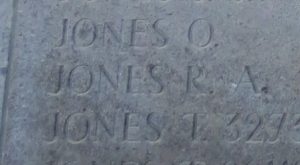
Ritchie Cyril Jones, Private, 8032, Alexandra, Princess of Wales’s Own (Yorkshire Regiment). Ritchie, known as Cyril, was the son of William Henry Jones and Mary Emily Jones (nee Grist), of 10, Bryn Street, Newtown. He left home as a young man to work at Huddersfield and enlisted at Halifax into the 3rd Battalion, Yorkshire Regiment. He joined the battalion at West Hartlepool, but was soon transferred to the 7th Battalion, Yorkshire Regiment following its formation at Richmond in September 1914. The battalion moved to Wareham to join 50 Brigade, 17th (Northern) Division, and completed its training at Romsey before landing at Boulogne on 14 July 1915. The Division spent its initial period of trench familiarisation in the southern area of the Ypres salient near Reninghelst and took part in the desperate fighting at the Bluff during February 1916. The Division moved to the Armentieres sector at the end of March 1916, then on 15 May moved to a training area at Mentque where it remained until marching to Heilly, in the Somme Valley, on 20 June. The Division took over a section of the front line near Ville, facing Fricourt and on 1 July 1916 took part in the opening assault of the Battle of the Somme, capturing the village of Fricourt at heavy cost. On the following day the 7th Yorkshire’s were relieved and moved back to billets in Ville to enjoy a brief rest before seeing further fighting near Mametz Wood on 7 July, in co-ordination with the assault on the wood by the 38th (Welsh) Division. On 11 July the 7th Yorkshire’s were again relieved and moved into the rest area at Molliens Vidames, then to Bellancourt, where the battalion refitted and rebuilt its strength. The battalion began moving back into the battle zone on 23 July and by 9 August had moved into the 2nd line, which by now was between Delville Wood and High Wood, and the men began work on carrying and wiring parties. By 19 August the 17th Division had taken over the line at Hébuterne, to the north, remaining there over the coming weeks. Cyril was killed here on 7 October 1916, during a routine spell in the line. The 19-year-old has no known grave and is commemorated on the Thiepval Memorial, France.
Thomas Henry Davies Jones, Corporal, 3095, Royal Welsh Fusiliers. Thomas was born in 1876, the son of Evan Jones and Mary Jane Jones (nee Davies), of Newtown. He married Caroline Mills in 1897 and the couple lived in 34, Smithfield Street, Llanidloes. Thomas worked as a hairdresser prior to enlisting into the 2/7th Battalion, Royal Welsh Fusiliers at Llanidloes on 13 October 1914. The battalion had formed at Newtown from a surplus of personnel who had enlisted into the original 7th Battalion, Royal Welsh Fusiliers and was a second line Territorial Army unit. During April 1915 the battalion moved to Northampton to join 203 Brigade, 68th (2nd Welsh) Division, then in July 1915 moved to Bedford. Charles was promoted twice over the coming months, being appointed Lance Corporal on 16 September 1915 and Corporal on 12 May 1916. During November 1916 the battalion moved to Southwold, on coastal defence duties, but by then Thomas had started to have problems with his health and was in hospital in Bedford. He was found to have contracted pulmonary tuberculosis before being discharged from the army as medically unfit on 24 November 1916 and returned home. Thomas died of tuberculosis at Newtown on 25 January 1918. The 41-year-old was buried in Dolhafren Cemetery, Llanidloes. His brother, Walter George Cotterill Jones, also fell. Both men are commemorated on the Llanidloes war memorial, although only Thomas is commemorated at Newtown.
Thomas Pryce Jones, Private, 1186, Royal Welsh Fusiliers. Thomas was born at Horseshoe Cottage, Arddleen in 1895, the son of Thomas and Eliza Jones. His parents later resided at Dolfor Locks, while Thomas worked as a servant at Bellan Cottage, Mardu, Llandrinio prior to the war. He enlisted at Newtown into the 7th Battalion, Royal Welsh Fusiliers. The battalion was a Territorial unit, which mobilised for war at Newtown in August 1914, as part of North Wales Brigade, Welsh Division and moved to Conway until the end of the month, before moving to Northampton. Thomas died in Northampton on 12 November 1914. The remains of the 19-year-old were brought home for burial in St. Llwchaiarn’s Churchyard, Llanllwchaiarn.
William Richard Jones, Private, 241930, Royal Welsh Fusiliers. William was born at Wrexham in 1879 but came to Newtown as a young man to work as a farm bailiff. He married Hannah Lloyd, of Glascoed, Dolfor, at Newtown on 11 July 1914 and the couple set up home at Brickfield Court, Kerry Road, Newtown where their two daughters were born. William enlisted into the 5th Battalion, Royal Welsh Fusiliers at Newtown on 11 December 1915 and was placed on the Army Reserve. He was mobilised at Wrexham on 11 June 1916 and posted to Park Hall Camp, Oswestry to join the 3/5th Battalion, Royal Welsh Fusiliers. William embarked for France at Southampton on 23 May 1917, joining the Infantry Base Depot at Rouen. On 16 June he was posted to Ypres, joining the 15th Battalion, Royal Welsh Fusiliers, which was holding the Canal Bank sector at Boesinghe, attached to 113 Brigade, 38th (Welsh) Division. He arrived in time to take part in the well-planned training regime the Division was about to undertake before the planned launching of the Passchendaele offensive. On 31 July 1917 the Division launched its famous assault on the Pilckem Ridge, capturing Iron Cross and reaching its objective of the Steenbeek, then played a supporting role in the Battle of Langemarck. William was wounded in the back, chest, and legs at Pilckem Ridge on 4 August and was evacuated to the 47th Casualty Clearing Station, where he died of his wounds on the following day, 5 August 1917. The 37-year-old is buried in Dozinghem Military Cemetery, Belgium.
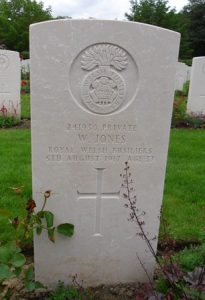
Albert Edward Jordan, Lance Corporal, 1088, Royal Welsh Fusiliers. Albert, known as Bert, was the son of Walter Jordan and Martha Jordan (nee Jones), of 23, Cross Street, Newtown. By 1911 he was lodging at 52, Fountain Street, Ferndale where he worked as a coal miner. Bert had enlisted at Newtown into the 7th Battalion, Royal Welsh Fusiliers at some time prior to the war. The battalion was a Territorial unit, which mobilised for war at Newtown in August 1914, as part of North Wales Brigade, Welsh Division and moved to Conway until the end of the month, before moving to Northampton. In December the Division moved to Cambridge and then in May 1915 to Bedford, where the Division was numbered and the formation became 158 Brigade, 53rd (Welsh) Division. On 19 July 1915 the entire Division sailed from Devonport for Imbros and on 9 August 1915 landed at Suvla Bay. The infantry moved off the beaches across the Salt Lake, under shellfire, into the scrub covered Chocolate Hill, but due to a lack of maps and no knowledge of the terrain, many of the units became disorientated, and the situation became chaotic. Bert was killed in action on the following day, 10 August 1915. The 23-year-old has no known grave and is commemorated on the Helles Memorial, Gallipoli. After his death his war gratuity was awarded to Florence May Smith, his unmarried wife, who had given birth to their only child.
George Leeke, Private, 2555, Shropshire Yeomanry. George was born in Baschurch, Shropshire in 1892, the son of Henry and Mary Leeke. He came to Newtown as a young man to find work. George enlisted at Shrewsbury into the Shropshire Yeomanry and was posted to the 3/1st Battalion, Shropshire Yeomanry in Ireland. In the early summer of 1916, the regiment was dismounted and attached to the 3rd Line Groups of the West Lancs. Division at Oswestry. George then embarked for France among a draft of men sent to reinforce the 1st Battalion, Cheshire Regiment. The battalion was on the Somme attached to 15 Brigade, 5th Division, having moved there following a short spell at Arras. By 19 July 1916 the Division had begun moving forwards into the battle area and had reached the ruined village of Mametz, bivouacking around Pommiers Redoubt. The Division then moved forward and took part in the desperate fighting for High Wood and then helped drive towards Delville Wood. After several days of hard fighting the 1st Cheshire’s were relieved on 1 August and moved into reserve at Dernancourt before moving to billets at Laleu, near Amiens. On 24 August the battalion, now fully rested and rebuilt, began to move back towards the firing line, moving into Divisional Reserve. At dawn on 1 September 1916 the 1st Cheshire’s relieved the 14th Warwick’s in the front line at Chimpanzee Trench, under a barrage of lachrymatory gas shells. With the trenches now fully occupied by the battalion, a salvo of shells from a friendly battery crashed short, hitting an advanced post occupied by B Company, causing several casualties. George was among the men killed during the relief that day, probably by this friendly fire. The 23-year-old is buried in Bronfay Farm Military Cemetery, Bray Sur Somme, France.
Richard Ashton Lewis, Private, 290096, Royal Welsh Fusiliers. Richard was the son of Lewis Lewis and Sarah Lewis (nee Ashton), of Sayers Court, Newtown. He worked as a Mule Spinner and had enlisted at Newtown into the 7th Battalion, Royal Welsh Fusiliers several years prior to the war. The battalion was a Territorial unit, which mobilised for war at Newtown in August 1914, as part of North Wales Brigade, Welsh Division and moved to Conway until the end of the month, before moving to Northampton. In December the Division moved to Cambridge and then in May 1915 to Bedford, where the Division was numbered and the formation became 158 Brigade, 53rd (Welsh) Division. On 19 July 1915 the entire Division sailed from Devonport for Imbros and on 9 August 1915 landed at Suvla Bay. The infantry moved off the beaches across the Salt Lake, under shellfire, into the scrub covered Chocolate Hill, but due to a lack of maps and no knowledge of the terrain, many of the units became disorientated, and the situation became chaotic. After the fighting died down, the winter rolled in, and the men first had to endure torrential downpours, which flooded the trenches, before the snow hit, and many men began falling ill in the terrible conditions. The Division was eventually evacuated from Gallipoli in December 1915, moving to Egypt to join the EEF, and helped guard the Suez Canal before taking part in operations to drive the Turks out of the Sinai. The EEF then turned its attention onto driving the Turks out of Palestine, and on 26 March 1917 launched its first offensive against the coastal city of Gaza, which guarded the road to Jerusalem. Initial gains during the day were lost when the assaulting divisions lost touch with each other, and communication broke down when a thick fog cloaked the battlefield. Richard was killed in action during the terrible fighting that day. The 23-year-old has no known grave and is commemorated on the Jerusalem Memorial, Israel. His parents had by now moved to 177, Upper Brow Road, Paddock, Huddersfield.
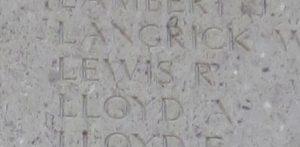
John Anthony Liddle, Gunner, 77903, Royal Horse Artillery. John was the son of Edward Liddle and Hannah Liddle (nee Jones), of Ladywell Street, Newtown. The family moved to South Wales to find work prior to the war and lived at 25, Prospect Place, Treorchy. John’s father died there in 1910, and John became the family’s breadwinner, finding work as a coal miner. He was also a well-known member of the Horeb Young People’s Debating Society in the town. John enlisted into the Royal Horse Artillery soon after the outbreak of war and embarked for France on 21 July 1915. He was then transferred to the 14th Anti-Aircraft Section at Erquinghem. The battery helped protect troops around the sector from German aircraft and were concentrated around the Ploegsteert and Le Bizet sectors. John was wounded here on 10 November and was evacuated to No 2 Casualty Clearing Station, Bailleul where he died of his wounds on 10 November 1915. The 19-year-old is buried in Bailleul Communal Cemetery Extension, France.
Evan Edward Lloyd, Private, DM2/171223, Army Service Corps. Evan was the son of William and Annie Lloyd, of Milford Cottages, Newtown. He worked as a domestic gardener prior to the war. Evan enlisted at Newtown into the Army Service Corps. He married Mary Morgan, of Newtown, whilst home on leave in the Spring of 1917. Evan then embarked for France with the 1031st M.T. Company, Army Service Corps, which travelled by rail to the southern port of Marseilles. The Company then boarded the steamship HMT Aragon, among some 2,200 troops, bound for Egypt to join the EEF. Aragon then left Marseilles in convoy with HMT Nile and on 23 December reached Malta, where the ships anchored, and the passengers and crew celebrated Christmas. The two ships then continued their voyage to Egypt under the escort of the Acheron-class destroyer HMS Attack plus two Imperial Japanese Navy destroyers. The convoy encountered a gale off the Egyptian coast, then at daybreak on Sunday 30 December 1917 it divided: the two Japanese destroyers escorted Nile to Port Said, while Attack escorted Aragon to Alexandria. Whilst approaching the port, Aragon waited in Alexandria Roads whilst Attack swept the channel for mines. This gave the opportunity for a waiting German submarine, UC-34, to fire off a torpedo at Aragon, which struck her in the side, causing her to list to starboard. Attack and a tug, Points Castle, came to take survivors from Aragon, which was now sinking quickly. Some 400 survivors were taken aboard Attack, but the Germans fired another torpedo at the helpless destroyer which also sank. Some 610 lives were lost during the tragedy that day. Among the dead was 33-year-old Evan. He has no known grave and is commemorated on the Chatby Memorial, Alexandria, Egypt.
William Lloyd, Private, 54568, Royal Welsh Fusiliers. William was born in 1896, the son of John David and Mary Elizabeth Lloyd, of Cwmerl Bank Farm, Sarn, Newtown. The family later resided at Pwmyringel, Beguildy. William enlisted at Welshpool into the army and was posted to France at some time in 1916, joining ‘A’ Company, 2nd Battalion, Royal Welsh Fusiliers. The battalion was attached to 19 Brigade, 33rd Division and moved from the Cambrin area in July 1916 to take part in the Somme offensive. The division saw heavy fighting on the Somme, especially around High Wood and the following year moved to Arras, taking part in heavy fighting at Hindenburg Trench. Later that year the division moved north and spent some time in the trenches on the French coast, before moving to Ypres in September to take part in the Battle of Passchendaele. The 2nd RWF moved into the support line behind Glencorse Wood on 25 September and on the following morning, 26 September 1917, advanced past the north of the wood to launch an assault on Polygon Wood. William was probably killed when ‘A’ Company came under heavy fire near Lone Farm that morning, suffering several casualties. He was 21 years old and is commemorated on the Tyne Cot Memorial, Belgium.
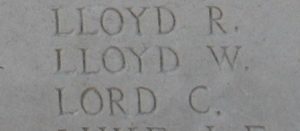
William Charles Mills, Private, 816, Royal Welsh Fusiliers. William was the son of Edward and Elizabeth Mills, of 4, Ann Street, Newtown. He worked at the Cambrian Woollen Mill and had enlisted into the 7th Battalion, Royal Welsh Fusiliers at Newtown some years prior to the war. The battalion was a Territorial unit, which mobilised for war at Newtown in August 1914, as part of North Wales Brigade, Welsh Division and moved to Conway until the end of the month, before moving to Northampton. In December the Division moved to Cambridge and then in May 1915 to Bedford, where the Division was numbered and the formation became 158 Brigade, 53rd (Welsh) Division. On 19 July 1915 the entire Division sailed from Devonport for Imbros and on 9 August 1915 landed at Suvla Bay. The infantry moved off the beaches across the Salt Lake, under shellfire, into the scrub covered Chocolate Hill, but due to a lack of maps and no knowledge of the terrain, many of the units became disorientated, and the situation became chaotic. William was badly wounded during the initial charge across the Salt Lake and was evacuated by Hospital Ship to Hospital in Mudros. He died of his wounds there on 16 August 1915. The 22-year-old is buried in East Mudros Military Cemetery, Greece.
Francis Harold Moody, Private, 28073, King’s Shropshire Light Infantry. Francis was the son of Thomas Moody and Elizabeth Moody (nee Rowlands), of 22, Lower Side Canal, Newtown. He enlisted at Newtown into the army and was initially posted to the Training Reserve, before being drafted to France in the Spring of 1918, joining the 6th Battalion, King’s Shropshire Light Infantry, which was attached to 60 Brigade, 20th (Light) Division. The Division had moved south from the Dickebusch sector at the end of February 1918, taking over positions near Bray St. Christophe in the Southern Somme sector. Unfortunately, it was hit hard following the launching of the German Spring offensive of 21 March 1918 and over the coming days suffered terrible casualties as the line was driven back towards Thennes, where the Germans were eventually held. The 6th KSLI was relieved on the evening of 1 April and marched back to Revelles to rest and refit. The entire Division then moved to the Abbeville area where reinforcements began to arrive and this is where Francis joined the ranks of the 6th KSLI as the 20th Division was slowly rebuilt over the coming months before being moved to the Avion Sector, near Lens. On 8 August 1918 the Allies launched a successful attack at Villers Bretonneux which broke the German lines, and the will of the German army. As a result, a general offensive was launched on the Somme front on 21 August 1918 and the Allies began to drive the Germans back towards the Hindenburg Line. On 1 September the 6th KSLI was in the line in the Mericourt Sector when news was received that the Germans had withdrawn from Lens. On the following day the battalion sent forward a patrol to ascertain the reports, which proved to be false, and the patrol withdrew under heavy artillery fire. Francis was wounded during the action that day and was evacuated to the 61st Field Ambulance. He died of his wounds there on 4 September 1918. The 19-year-old is buried in Sucrerie Cemetery, Ablain-St. Nazaire, France.
Edward Leslie Morgan, Second Lieutenant, Royal Field Artillery. Edward was the son of Edward and May Morgan, of Plas-Cae-Crwn, Newtown. He worked as a Solicitor prior to the war. Edward was commissioned from the Officer Cadet School into the Royal Field Artillery on 28 October 1916 and was drafted to France, joining A Battery, 23rd Brigade, Royal Field Artillery, which was attached to the 3rd Division. Edward must have made a big impression on the Commanding Officer of the Battery as he often signed off the monthly war diaries for the unit after his arrival. He joined the Brigade on the Somme, where the 3rd Division were having a testing time, during the Battle of Delville Wood, and the Battle of the Ancre. The Division wintered on the Somme before moving to the Arras Sector and in May 1917 the Division fought throughout the Battle of Arras, at the First and Second Battles of the Scarpe, at the Battle of Arleux and at the Third Battle of the Scarpe, where the Division captured the village of Roeux. The Division then moved north to Ypres on 22 October to join the Passchendaele offensive. The Brigade set up its gun batteries near the Steenbeek and opened its HQ at Gournier Farm, then on 28 October began a 48-hour softening up bombardment, preparatory to an assault by the 3rd Division on Cameron House. Over the coming days the Germans fired salvos of gas shells towards the Brigades gun positions. Edward was gassed on 3 November and was evacuated to the 46th Casualty Clearing Station near Proven, where he died of his gas wounds on 9 November 1917. The 28-year-old is buried in Mendinghem Military Cemetery, Belgium.
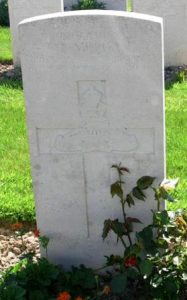
Evan Edward Morgan, Lance Corporal, 10853, Somerset Light Infantry. Evan was the son of Evan Morgan and Mary Ann Morgan (nee Jones), of 1, Weir Street, Newtown. He worked as a Stoker prior to moving to the South Wales Valleys to find work as a coalminer. Evan enlisted at Pentre into the 6th Battalion, Somerset Light Infantry soon after the outbreak of war. The battalion had formed at Taunton before moving to Aldershot to join 43 Brigade, 14th (Light) Division and on 21 May 1915 landed at Boulogne before moving into the Ypres Salient. The Division was to see its first action during the Action of Hooge, where the Division was the first to be attacked by the German use of flamethrowers. The Division then fought at the Second attack on Bellewaarde. In July 1916 the Division moved to the Somme, and fought at the Battle of Delville Wood, and then the Battle of Flers-Courcelette, before being relieved in the middle of September and moved north to the Arras sector. During March 1917 the Division followed the German Retreat to the Hindenburg Line. On 31 March 1917 two Companies of the 6th Somerset’s were sent out to work on new assembly trenches and two Companies to work on a light railway line. Evan was killed in action during the day. The 23-year-old is buried in Beaurains Road Cemetery, Beaurains, France.
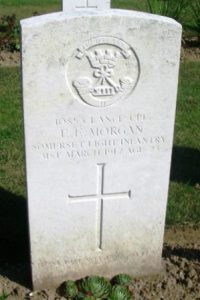
Frederick Barter Morgan, Ordinary Seaman, J/28437, Royal Navy. Frederick was born on 15 November 1896, the son of Thomas and Mary Jane Morgan, of 16, Severn Street, Newtown. He was still training to work as a Joiner when he enlisted into the Royal Navy on 15 November 1913 and was posted to HMS Vivid I for training. Upon completing his training, he was initially posted aboard the Duncan-class pre-dreadnaught battleship HMS Russell, then spent a short period back ashore at HMS Pembroke I before being posted aboard the pre-dreadnaught battleship HMS Formidable on 26 August 1914. Formidable was based at Portland with the 5th Battle Squadron, which had been assigned to the Channel Fleet to defend the English Channel. After covering the safe transportation of the British Expeditionary Force to France in August 1914, Formidable took part in the transportation of Royal Marines to Ostend on 25 August. On 14 November, Formidable and the other ships of the 5th Battle Squadron were transferred to Sheerness to cover any potential German invasion. Formidable took part in gunnery exercises off Portland on 31 December and after the exercise, remained out on patrol, unescorted, together with two light cruisers. Unbeknown to the three ships, they were being stalked by the German submarine U-24 and at about 02:20 on 1 January 1915, U-24 launched a torpedo at Formidable, striking her on the starboard side and crippling her. About 40 minutes later the Germans fired another torpedo at the helpless ship, which began to slowly capsize and sink with the loss of some 547 lives. Frederick was among the dead. The 18-year-old has no known grave and is commemorated on the Plymouth Naval Memorial, Devon.
John Herbert Morgan, Sergeant, 235846, Royal Welsh Fusiliers. John was the son of John and Elizabeth Morgan, of Red House, Kerry. He enlisted into the Montgomeryshire Yeomanry at Welshpool on 20 October 1914 and was posted to the 2/1st Battalion, Montgomeryshire Yeomanry, which had just been formed. In July 1915 the battalion moved to Dorchester to join the 2/1st South Wales Mounted Brigade and in September 1915 moved to Southwold, the brigade joining the 1st Mounted Division. John remained on home service with the battalion for most of the war, moving to Thorndon Park, Brentwood in July 1916, and then to Worlingham and Gorleston. He was drafted to France on 21 October 1918, joining the 16th Battalion, Royal Welsh Fusiliers, which was attached to 113 Brigade, 38th (Welsh) Division. The Division had been advancing from its positions north of Albert during the previous months, as part of the great Allied offensive, and had crossed the Canal du Nord and the mighty Hindenburg Line. John joined the battalion in the field, at Berlaimont, on 6 November, just five days before the Armistice. On the following day the battalion marched to Aulnoye, and at dawn on 8 November launched its final assault of the war, against strong German defences in the Forest of Mormal. John was wounded during the assault of 8 November and evacuated to No 12 General Hospital, Rouen, where he died of his wounds on 21 November 1918. The 25-year-old is buried in St. Sever Cemetery Extension, Rouen, France.
Lawrence Victor Morgan, Private, 5278, Machine Gun Corps. Lawrence was born in Rochdale in 1898. He was fostered by John and Emma Morgan, a Welsh couple who had been living at Rochdale, and when he was a young boy, the family came to live at Frankwell Street, Newtown. By 1911 the family had returned to Rochdale and resided at 32, Buckingham Street. Lawrence enlisted at Bacup into the army and was originally posted to the Argyll & Sutherland Highlanders. Lawrence was then posted to Grantham, joining the newly formed 59th Company, Machine Gun Corps. The Company embarked for France at Southampton on 24 February 1916, joining the 20th (Light) Division at Brandhoek, before setting up positions along the Canal Bank north of Ypres. After a brief spell at the front, the 59th Company moved back behind the lines to Wormhoudt to carry out a training program, before moving back into the line on the Canal Bank by 27 May. Just to the south, on 2 June 1916 the Germans launched an offensive against the Canadian Corps, who held the line facing Mount Sorrel and Hill 62. The 20th Division moved south to help bolster the thinly stretched line, helping beat off the German attackers. At the end of July, the Division moved out of the Ypres Salient to the Somme, to join the great Somme offensive, initially taking up positions at Hébuterne. In the middle of August, the Division moved slightly south to the Guillemont sector and the 59th Company set up its gun positions at the Briqueterie on 21 September, suffering several casualties over the coming days. On the morning day, 3 September 1916, the Division launched an assault on the village of Guillemont. Lawrence was killed in action during the fighting that day when a German minenwerfer shell crashed into his gun position. The 18-year-old has no known grave and is commemorated on the Thiepval Memorial, France.
Morgan, T. J. This man cannot presently be identified.
Alfred Morris, Private, 9046, Royal Welsh Fusiliers. Alfred was born at Montgomery in 1886, the son of Richard Morris and Elizabeth Morris (nee Humphreys). By 1911 he was lodging at Plas Trehelig, Welshpool, where he worked as a gardener for Mrs White. He then left just prior to the war to work as a gardener at Milford Hall, Newtown and resided at Milford Hall Cottage. Alfred enlisted into the 3/7th Battalion, Royal Welsh Fusiliers at Welshpool soon after the outbreak of war but was discharged as medically unfit. He re-enlisted into the 4th (Reserve) Battalion, Royal Welsh Fusiliers at Wrexham on 30 March 1916 and was posted to Prees Heath Camp near Whitchurch for training. Alfred had only been at Prees Heath a matter of days when he was admitted into Prees Heath Military Hospital on 10 April, suffering from pneumonia. He appeared to be recovering, but on 19 April 1916 began suffering chest pains and died of a heart attack, induced by his pneumonia. The remains of the 29-year-old were brought home and he was buried in St. Mary’s Churchyard, Welshpool on 22 April.
Cecil Herbert Brumwell Morris, Private, 41665, South Wales Borderers. Cecil was the son of John Edward Morris and Ada Elizabeth Morris (nee Hope), of 18, High Street, Newtown. He enlisted in Newtown into the Training Reserve and after completing his training was drafted to France in the Spring of 1918, where he was posted to the 5th Battalion, South Wales Borderers. The battalion was the Pioneer Battalion to the 19th (Western) Division and had suffered terrible casualties following the launching of the German Spring offensive on the Somme on 21 March 1918, especially during the epic rear-guard defensive action at Beugny. The badly depleted Division was evacuated and moved to the Messines sector to rest and rebuild but unfortunately became caught up in further desperate fighting following the launching of the second phase of the German offensive along the Lys Valley on 9 April. The remnants of the Division were moved south to the Aisne sector to rest and rebuild, but by sheer bad luck, the Germans third, and last, offensive was launched here on 27 May 1918, and the Division was once more caught up in desperate fighting over the coming days. Cecil was killed while the 5th SWB was in the process of relieving the decimated 10th Warwick’s and 10th Worcester’s to the west of Bois-de Eglise on 6 June 1918. The 19-year-old is buried in La Neuville-Aux-Larris Military Cemetery, France.
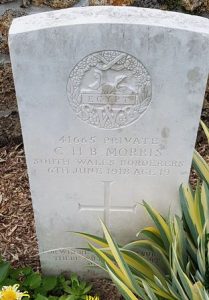
Frederick Hawthorne Cecil Morris, Able Seaman, J/38143, Royal Navy. Frederick was born on 17 August 1898, the son of John Morris and Susan Ellen Morris (nee Williams), of 10, Dysart Terrace, Newtown. He worked for Lloyd & Lloyd Ironmongers prior to enlisting into the Royal Navy on 4 March 1915 and was posted to HMS Impregnable for training. Impregnable was actually an obsolete wooden ship, HMS Howe, which had been built at Pembroke Dockyard in the 1850’s and was used to train Boy ratings. Frederick was then posted to HMS Victory I before being posted aboard the armed merchant cruiser HMS Moldavia on 1 February 1916. Frederick then had several other postings before being posted to HMS Egmont, the Naval Base at Malta, on 10 December 1917. He had not long arrived before he fell ill and was hospitalised at the Royal Naval Hospital in Malta, where he died of meningitis on 8 January 1918. The 19-year-old is buried in Malta (Capuccini) Naval Cemetery, Malta.
George Henry Mumford, Sergeant, 290312, Royal Welsh Fusiliers. George was the son of George and Mary Anne Mumford, of Sheaf Street, Newtown. He worked as a solicitor’s clerk prior to the war. George had enlisted at Newtown into the 7th Battalion, Royal Welsh Fusiliers on 7 September 1914. The battalion was a Territorial unit, which mobilised for war at Newtown in August 1914, as part of North Wales Brigade, Welsh Division and moved to Conway until the end of the month, before moving to Northampton. In December the Division moved to Cambridge and then in May 1915 to Bedford, where the Division was numbered and the formation became 158 Brigade, 53rd (Welsh) Division. On 19 July 1915 the entire Division sailed from Devonport for Imbros and on 9 August 1915 landed at Suvla Bay. The infantry moved off the beaches across the Salt Lake, under shellfire, into the scrub covered Chocolate Hill, but due to a lack of maps and no knowledge of the terrain, many of the units became disorientated, and the situation became chaotic. After the fighting died down, the winter rolled in, and the men first had to endure torrential downpours, which flooded the trenches, before the snow hit, and many men began falling ill in the terrible conditions. The Division was eventually evacuated from Gallipoli in December 1915, moving to Egypt to join the EEF, and helped guard the Suez Canal before taking part in operations to drive the Turks out of the Sinai. The EEF then turned its attention onto driving the Turks out of Palestine, and on 26 March 1917 launched its first offensive against the coastal city of Gaza, which guarded the road to Jerusalem. Initial gains during the day were lost when the assaulting divisions lost touch with each other, and communication broke down when a thick fog cloaked the battlefield. George was killed in action during the terrible fighting that day. The 36-year-old is buried in Gaza War Cemetery.
Richard Edwin Nock, Gunner, 371194, Royal Garrison Artillery. Richard was born in Newtown in 1895, the son of Richard Edwin nock and Maria Nock (nee Davies). By 1911 he was residing with his aunt and uncle, George and Elizabeth Davies, at Boston House, Tenby, where he was apprenticed to his uncle, who was a bootmaker. Richard enlisted at Hubberston Fort into the Pembrokeshire Battery, Royal Garrison Artillery. He was then posted to the 114th Siege Battery, Royal Garrison Artillery, which had been formed at Pembroke Dock on 8 March 1916 from members of the Pembrokeshire Royal Garrison Artillery. The Battery moved out to the Western front on 14 June 1916 equipped with four 6-inch Howitzers and initially joined the 32nd Heavy Artillery Group. By the time the Somme offensive opened on 1 July 1916 the 114th Siege Battery had been attached to the 28th HAG, joining the Fourth Army. The battery took part in the softening-up process during the Battle of Flers-Courcelette in September. The following year saw the 114th Siege Battery at Ypres, where it played a part in the Battle of Messines on 7 June 1917. Richard was killed by German counter-battery fire at Ypres on 24 June 1917, aged 22. He is buried at Belgian Battery Corner Cemetery, Belgium.
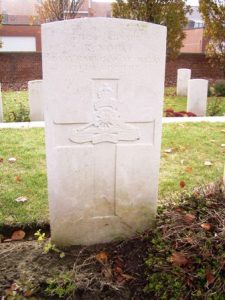
Clement Edgar Norton, Second Lieutenant, Army Service Corps. Clement was the son of Clement William Norton and Mary Elizabeth Norton (nee Edwards) of Dolguan, Newtown. He enlisted into the Army Service Corps as a Private but was commissioned as Second Lieutenant before embarking for the Middle East on 30 November 1917. Clement was posted to Palestine where he remained over the coming months. He died at Ramleh on 10 October 1918, aged 22. Clement is buried in Ramleh War Cemetery, Israel. His only brother, Ernest William Norton, was reputedly Montgomeryshire’s first airman, who had joined the Royal Naval Air Service, becoming a fighter ace with nine confirmed victories, and gaining several gallantry awards before going on to become a Squadron Leader during the war.
Charles Kenneth Oliver, Private, 291230, Royal Welsh Fusiliers. Charles was the son of Edward and Emily Alice Olive, of 4, Llanfair Road, Newtown. He worked as a wool sorter prior to enlisting at Newtown into the 3/7th Battalion, Royal Welsh Fusiliers on 20 November 1915 and was posted to Park Hall Camp, Oswestry for training. Charles embarked at Southampton for Egypt on 11 December 1916 and upon his arrival in Egypt joined the 1/7th Battalion, Royal Welsh Fusiliers, which was attached to 158 Brigade, 53rd (Welsh) Division. The Division had been evacuated from Gallipoli in December 1915, moving to Egypt to join the EEF, and helped guard the Suez Canal before taking part in operations to drive the Turks out of the Sinai. The EEF then turned its attention onto driving the Turks out of Palestine, and on 26 March 1917 launched its first offensive against the coastal city of Gaza, which guarded the road to Jerusalem. Initial gains during the day were lost when the assaulting divisions lost touch with each other, and communication broke down when a thick fog cloaked the battlefield. A second attempt to force Gaza was launched on 17 April, which also failed, and the EEF suffered a change in leadership, with Sir Edmund Allenby assuming command, before being re-organised. Charles took ill on 23 April, just after the second attempt to clear Gaza, and was evacuated to the 21st General Hospital in Alexandria, where he died of diphtheria on 14 July 1917. The 21-year-old is buried in Alexandria (Hadra) War Memorial Cemetery, Egypt.
Sydney Owen, Private, 3248, Royal Welsh Fusiliers. Sydney was the son of Pryce Owen and Mary Jane Owen (nee Rowlands), of 13, Whittington’s Passage, Welshpool. He worked as a farm servant at Penarth Farm, Newtown prior to the war. Sydney enlisted into the 7th Battalion, Royal Welsh Fusiliers at Newtown soon after the outbreak of war. The battalion was a Territorial unit, which mobilised for war at Newtown in August 1914, as part of North Wales Brigade, Welsh Division and moved to Conway until the end of the month, before moving to Northampton. In December the Division moved to Cambridge and then in May 1915 to Bedford, where the Division was numbered and the formation became 158 Brigade, 53rd (Welsh) Division. On 19 July 1915 the entire Division sailed from Devonport for Imbros and on 9 August 1915 landed at Suvla Bay. The infantry moved off the beaches across the Salt Lake, under shellfire, into the scrub covered Chocolate Hill, but due to a lack of maps and no knowledge of the terrain, many of the units became disorientated, and the situation became chaotic. After the fighting died down, the winter rolled in, and the men first had to endure torrential downpours, which flooded the trenches, before the snow hit, and many men began falling ill in the terrible conditions. Sydney took ill during these terrible conditions and died of exposure at Gallipoli on 28 November 1915. The 25-year-old is buried in Lala Baba Cemetery, Gallipoli.
Thomas William Owen, Private, 811, Royal Welsh Fusiliers. Thomas was the illegitimate son of Sarah Morgan (nee Owen), of 9, The Lot, Park Street, Newtown. He enlisted at Newtown into the 7th Battalion, Royal Welsh Fusiliers several years prior to the outbreak of war. The battalion was a Territorial unit, which mobilised for war at Newtown in August 1914, as part of North Wales Brigade, Welsh Division and moved to Conway until the end of the month, before moving to Northampton. In December the Division moved to Cambridge and then in May 1915 to Bedford, where the Division was numbered and the formation became 158 Brigade, 53rd (Welsh) Division. On 19 July 1915 the entire Division sailed from Devonport for Imbros and on 9 August 1915 landed at Suvla Bay. The infantry moved off the beaches across the Salt Lake, under shellfire, into the scrub covered Chocolate Hill, but due to a lack of maps and no knowledge of the terrain, many of the units became disorientated, and the situation became chaotic. Thomas was killed in action during the following day, 10 August 1915. The 20-year-old has no known grave and is commemorated on the Helles Memorial, Gallipoli.
William Owen, Lance Corporal, 60731, Royal Welsh Fusiliers. William was the son of William and Catherine Owen, of 60, Lower Ladywell Street, Newtown. He worked as a grocer prior to the war. William enlisted at Wrexham into the army and was drafted to France in the Spring of 1918, joining the 16th Battalion, Royal Welsh Fusiliers. The battalion was attached to 113 Brigade, 38th (Welsh) Division and had wintered in the Sailly-sur-la-Lys sector before being moved to positions north of Albert, at Bouzincourt Ridge, at the end of March 1918, relieving the battered 2nd and 47th Divisions. It held this sector, carrying out several minor operations and trench raids, over the coming months, before taking part in the great offensive of 21 August 1918, and began its advance towards the Hindenburg Line. The initial advance was carried out by 114 Brigade who crossed the River Ancre that day, establishing a bridgehead, then 113 Brigade and 115 Brigade attacked around Albert the following day before the Division began to drive the Germans back across the old Somme battlefields of 1916, recapturing Thiepval and Pozieres, then captured Longueval and Delville Wood before advancing upon the Bapaume to Péronne Road. By 4 October the Division had reached positions near Lempire and over the coming days advanced towards Mortho Wood, which was attacked with the help of tanks on 8 October 1918. William was among 160 casualties suffered by the 16th RWF alone when he was killed during the attack that day. The 24-year-old is buried in Bois-Des-Angles British Cemetery, Crevecoeur-Sur-L’Escaut, France.
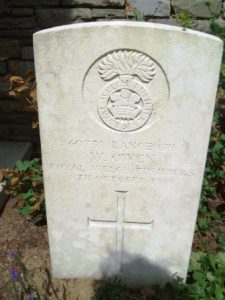
Edmund Fenning Parke, Private, 654, Princess Patricia’s Canadian Light Infantry. Edmund was born on 20 June 1891, the son of Edward Parke and Elizabeth Parke (nee Dolbey), of Glan Hafren, Newtown. He emigrated to Canada in 1910 and found work as a Bank Clerk in Ottawa. Edmund enlisted at Ottawa into the Canadian Expeditionary Force on 20 August 1914, stating on his attestation form that he had previously served for two years with the 7th Battalion, Royal Welsh Fusiliers. He was then posted to the newly formed Princess Patricia’s Canadian Light Infantry and embarked for England aboard the SS Royal George on 27 September 1914. Upon arrival at Liverpool, the PPCLI entrained to a new Canadian Camp at Salisbury Plain, and the PPCLI became stationed at Bustard Camp near Stonehenge. On 20 December, the regiment embarked for France at Southampton, moving into the Ypres Salient before taking over a section of trenches at Dickebusch on 6 January 1915. The battalion took part in several actions around St. Eloi over the coming months but saw their first real test on 8 May 1915 when the Germans launched a ferocious assault, the Battle of Frezenberg, where the PPCLI took part in an epic defence of the Bellewaarde Ridge and was almost annihilated. Edmund was among some 550 casualties suffered by the battalion when he was killed in action that day. The 22-year-old has no known grave and is commemorated on the Ypres (Menin Gate) Memorial, Belgium.
Walter Parry, Leading Aircraftman, 23867, Royal Air Force. Walter was the son of Pryce and Fanny Parry, of 39, Kerry Road, Newtown. He enlisted into the Royal Flying Corps on 26 February 1916 and was drafted to France where he served for the duration of the war with 24 Squadron, transferring to the newly formed Royal Air Force in March 1918. The squadron was founded as No. 24 Squadron, Royal Flying Corps on 1 September 1915 at Hounslow Heath Aerodrome and moved to France equipped with DH.2 fighters in February 1916, under the command of Major Lanoe Hawker, VC, DSO, who was later killed by the Red Baron on 23 November 1916. By early 1917 the obsolete DH.2 was replaced by the Airco DH.5, which the squadron used in a ground-attack role, seeing much action during the Battle of Messines and later in the Battle of Cambrai. The DH.5 was later phased out and the squadron re-equipped with the SE.5a, before returning to air combat operations and by the time of the Armistice, the Squadron’s pilots had accounted for some 200-enemy aircraft. Walter remained in France with the Squadron after the Armistice, but contracted influenza and died on 22 February 1919. The 28-year-old is buried in St. Andre Communal Cemetery, France.
Charles Ernest Phillips, MC, Captain, Royal Irish Regiment. Charles was the son of Evan Charles Phillips and Martha Phillips (nee Parry), of Llanfair Road, Newtown. After being educated at the Newtown County School, he left Newtown in 1902 for Coventry to join Lloyd’s Bank. After completing his examinations, he worked for Lloyd’s Bank at Droitwich, Rugby and at Cheltenham over the coming years. Charles enlisted during the first month of the war, and was at first attached to a regiment at the Curragh, in Ireland, before being transferred to the Kings Royal Rifle Corps. He was commissioned as Second Lieutenant into the 4th Battalion, Royal Irish Regiment on 8 May 1915 and was posted to France on 30 June 1918, joining the newly reformed 7th Battalion, Royal Irish Regiment. The battalion joined 21 Brigade, 30th Division in Corps Reserve at Hellbroucq on 4 July 1918. On 8 August the now fully rebuilt battalion moved into the front-line trenches at Locre to begin a routine tour in the line. The 30th Division remained here over the coming weeks, whilst to the south the Allies had launched a spectacular offensive from the Somme front on 21 August and had begun driving the Germans back towards the Hindenburg Line. On 30 August the 30th Division received news that the enemy facing their positions had withdrawn, so patrols were sent out, advancing some 500 yards before digging in. This move heralded the start of the great offensive on the Flanders front and over the coming days the Allies slowly drove forwards. By 14 October the Division had reached Wervicq, where it carried out a frontal assault on the town, breaking the enemy defences and advancing to the banks of the River Lys, in an action which saw Charles gain the award of the Military Cross. The citation to his award was published in the London Gazette of 2 December 1918 and read: ‘For conspicuous gallantry and good leadership. He led his company forward with great judgment, and in spite of heavy enfilade fire established his men in a good position. On the following day he led an attack on some enemy machine guns which had been holding up the advance, forced them to withdraw, and enabled the advance to continue successfully. He showed splendid coolness and initiative.’ Charles’s battalion was then relieved and enjoyed a brief rest before moving forwards on 18 October, crossing the Lys on a pontoon bridge, before continuing the advance. Charles was killed in action during an assault near St. Genois on 22 October 1918. The 31-year-old is buried in Vichte Military Cemetery, Belgium.
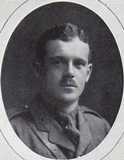
Edmund Llewellyn Pedro Phillips, Private, 203652, Gloucestershire Regiment. Edmund was the son of Thomas Llewellyn and Jane Phillips of Cambrian Vaults, Newtown. He was a well-known Musician, who had served a Musical Apprenticeship at Newtown, and had been a member of the Newtown Silver Band and of the Royal Welsh Fusilier Band prior to gaining work at Newport, Mon, but just prior to the war took up a position as a junior partner in the music firm, Messrs. Tyler and Phillips, Middleton Street, Llandrindod Wells. He enlisted into the 1/5th Battalion, Gloucestershire Regiment at Hereford and was posted out to France to join the battalion following heavy losses during the Somme offensive, where it was attached to 145 Brigade, 48th (South Midland) Division. He most probably joined the battalion in March 1917, while it was following the German Retreat to the Hindenburg Line, advancing from the direction of Cappy towards Péronne, then onto Doingt and Tincourt. By the beginning of April, the Division had reached Villers Faucon, and was within striking distance of the Hindenburg Line, before assaulting Malassise Farm, near Lempire, on 5 April. A month later the Division began to move away from the area and took up positions further north, at Hermies. At the beginning of July, the Division moved into reserve and spent several weeks training before moving to Flanders on 22 July and moved to Houtkerque for further training. By 4 August the Division had reached Vlamertinghe, and on the following day marched through Ypres before taking over the line on the Steenbeek at St. Julien. Edmund, who was acting as a stretcher bearer, was killed by shrapnel in the St. Julien trenches on 16 August 1917. The 21-year-old has no known grave and is commemorated on the Tyne Cot Memorial, Belgium. His brother, Thomas Frederick Carlisle Phillips, died on active service in 1918.
Thomas Frederick Carlisle Phillips, Private, 85843, Royal Defence Corps. Thomas, known as Fred, was the son of Thomas Llewellyn Phillips and Jane Phillips, of Cambrian Vaults, Newtown. He worked at Maesmawr prior to the war and enlisted in Welshpool into the Cheshire Regiment. Fred was not passed fit for infantry service, so was then transferred into the 153rd Protection Company, Royal Defence Corps and posted to Taunton. Little else is known of him, but Fred died in Taunton Hospital of a brain abscess on 16 September 1918, aged 19. His remains were brought home and he was buried in St. David’s Churchyard, Newtown. His brother, Edmund Pedro Llewellyn Phillips, was killed at Ypres in 1917.
James Pierce, Private, 290908, Royal Welsh Fusiliers. James was the son of James and Ellen Pierce of 17, Arundel Road, Oswestry. He came to Oswestry to work as a house painter. James enlisted into the 7th Battalion, Royal Welsh Fusiliers at Newtown on 14 December 1914, and married Sarah Elizabeth Owen, of 5, Park Terrace, Llanidloes Road, Newtown, on 24 July 1915, whilst on leave. He was initially posted to the 2/7th Battalion, Royal Welsh Fusiliers, which was at Northampton. James embarked at Southampton on 6 December 1916 and upon disembarking at Alexandria was posted to the 1/7th Battalion, Royal Welsh Fusiliers, which was attached to 158 Brigade, 53rd (Welsh) Division. The Division had been evacuated from Gallipoli in December 1915, moving to Egypt to join the EEF, and helped guard the Suez Canal before taking part in operations to drive the Turks out of the Sinai. The EEF then turned its attention onto driving the Turks out of Palestine, and on 26 March 1917 launched its first offensive against the coastal city of Gaza, which guarded the road to Jerusalem. Initial gains during the day were lost when the assaulting divisions lost touch with each other, and communication broke down when a thick fog cloaked the battlefield. A second attempt to force Gaza was launched on 17 April, which also failed, and the EEF suffered a change in leadership, with Sir Edmund Allenby assuming command, before being re-organised, and a third offensive was launched against a wider front from Beersheba to Gaza on 31 October 1917. This time the Turkish defences were breached, and the road to Jerusalem now lay open and the EEF began to advance north. On 6 November 1917, 158 Brigade launched an attack on the Khuweilfeh Heights. James was killed in action during the attack that day. The 26-year-old has no known grave and is commemorated on the Jerusalem Memorial, Israel.
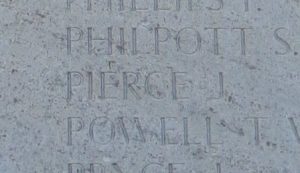
Henry Lewis Potts, Rifleman, 860871, London Regiment. Henry was the son of Lewis Potts and Susan Potts (nee Davies), of 30, Canal Road, Newtown. He worked at the Royal Welsh Warehouse, Newtown prior to the war. Henry enlisted at Wrexham into the army and was posted to the 50th Battalion, Training Reserve, which was based at Prees Heath. After completing his training Henry was posted to the 33rd (City of London) Battalion, London Regiment. The battalion had formed at Clacton early in June 1918 and on 3 July landed at Boulogne, before joining 41 Brigade, 14th (Light) Division at St. Sylvestre Cappel, near Ypres. From the end of September 1918 onwards the Division took part in the great advance in Flanders, moving to the Messines sector before taking part in the advance over the River Escaut and by the time of the Armistice had reached Les Ballons. Henry had survived several weeks of continuous fighting but had taken ill by now and died of influenza on 15 November 1918. The 19-year-old is buried in St. Andre Communal Cemetery, France.
Joseph Llewelyn Powell, Sergeant, 290254, Royal Welsh Fusiliers. Joseph was born at Wrexham on 11 February 1893. the son of Richard Powell and Mary Jane Powell (nee Corbett). The family moved to Old Church Street, Newtown by 1900, then by 1911 Joseph was lodging at 17, Oak Street, Ferndale, where he worked as a coal hewer. Joseph had enlisted into the 7th Battalion, Royal Welsh Fusiliers at Newtown several years prior to the war. The battalion was a Territorial unit, which mobilised for war at Newtown in August 1914, as part of North Wales Brigade, Welsh Division and moved to Conway until the end of the month, before moving to Northampton. In December the Division moved to Cambridge and then in May 1915 to Bedford, where the Division was numbered and the formation became 158 Brigade, 53rd (Welsh) Division. On 19 July 1915 the entire Division sailed from Devonport for Imbros and on 9 August 1915 landed at Suvla Bay. The infantry moved off the beaches across the Salt Lake, under shellfire, into the scrub covered Chocolate Hill, but due to a lack of maps and no knowledge of the terrain, many of the units became disorientated, and the situation became chaotic. After the fighting died down, the winter rolled in, and the men first had to endure torrential downpours, which flooded the trenches, before the snow hit, and many men began falling ill in the terrible conditions. The Division was eventually evacuated from Gallipoli in December 1915, moving to Egypt to join the EEF, and helped guard the Suez Canal before taking part in operations to drive the Turks out of the Sinai. The EEF then turned its attention onto driving the Turks out of Palestine, and on 26 March 1917 launched its first offensive against the coastal city of Gaza, which guarded the road to Jerusalem. Initial gains during the day were lost when the assaulting divisions lost touch with each other, and communication broke down when a thick fog cloaked the battlefield. Joseph was killed in action during the terrible fighting that day. The 24-year-old has no known grave and is commemorated on the Jerusalem Memorial, Israel.
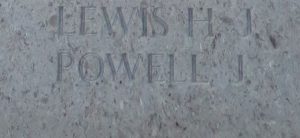
Harry Herbert Price, Private, 034897, Army Ordnance Corps. Harry was the son of Thomas James Price and Fanny Louisa Price, of Tenbury Wells, Worcestershire. He married Caroline Frances Howell at Tenbury in 1907 and by 1911 the couple had moved to 18, Swan Street, Newtown, where Harry worked as a hairdresser. He enlisted into the army at Welshpool and was posted to the Army Ordnance Corps, before being drafted to France. The Army Ordnance Corps was both a supply and repair corps, having responsibility for weapons, armoured vehicles and other military equipment, ammunition, and clothing and for certain minor functions such as laundry, mobile baths, and photography. The AOC was also responsible for a major element of the repair of Army equipment. Harry was attached to the 48th Company, AOC, which was based at an AOC Depot in Calais. He accidentally drowned in a canal there on 9 October 1917. The body of the 40-year-old was recovered from the water, and he was buried in Calais Southern Cemetery, France.
William James Price, Lance Corporal, 740, Royal Welsh Fusiliers. William was the son of James and Mary Jane Price, of 1, Lot, Park Street, Newtown. By 1911 he was lodging at 4, Railway Terrace, Cwmpark, where he worked as a coal miner. William had enlisted into the 7th Battalion, Royal Welsh Fusiliers several years prior to the war. The battalion was a Territorial unit, which mobilised for war at Newtown in August 1914, as part of North Wales Brigade, Welsh Division and moved to Conway until the end of the month, before moving to Northampton. In December the Division moved to Cambridge and then in May 1915 to Bedford, where the Division was numbered and the formation became 158 Brigade, 53rd (Welsh) Division. On 19 July 1915 the entire Division sailed from Devonport for Imbros and on 9 August 1915 landed at Suvla Bay. The infantry moved off the beaches across the Salt Lake, under shellfire, into the scrub covered Chocolate Hill, but due to a lack of maps and no knowledge of the terrain, many of the units became disorientated, and the situation became chaotic. After the fighting died down, the winter rolled in, and the men first had to endure torrential downpours, which flooded the trenches, before the snow hit, and many men began falling ill in the terrible conditions. William took ill within weeks of the landings and was evacuated to the 15th Stationary Hospital at Mudros, suffering from dysentery. He died there of dysentery on 7 September 1915. The 22-year-old is buried in East Mudros Military Cemetery, Greece.
John Edward Pritchard, Private, 19490, Welsh Regiment. John was the son of Jeremiah Pritchard and Hannah Pritchard (nee Thomas), of Llanllugan, Newtown. By 1911 he was lodging at 12, Fern Terrace, Tonypandy, where he worked as a coal hewer. John enlisted into the Welsh Regiment at Bridgend soon after the outbreak of war. He was drafted to France on 7 April 1915, joining the 1st Battalion, Welsh Regiment, which was at Dranoutre, attached to 84 Brigade, 28th Division. The Battalion had been seconded to the 5th Division, but within days of John’s arrival, moved to Ypres to re-join the 28th Division. The Division was holding a section of front line running from Wytschaete to the Ypres to Zandvoorde road. On 17 April the 1st Welsh marched up to relieve the 5th Fusiliers at Broodeseinde, just beyond Zonnebeke, on the extreme point of the Ypres Salient. On 22 April the Germans launched a poison gas attack at Gravenstafel, the first such attack of the war, and broke the line which was being held by a French Colonial Division. The Canadians rushed in to plug the gap, but this heralded the opening phase of the Second Battle of Ypres and soon afterwards the 1st Welsh became dragged into the terrible fighting. John was badly wounded during the terrible fighting and was evacuated to No 12 Canadian General Hospital at Rouen for treatment. He died of his wounds there on 8 May 1915. The 30-year-old is buried in St. Sever Cemetery, Rouen, France.
Richard Pritchard, Lance Corporal, 18675, Welsh Regiment. Richard was the son of Richard Pritchard and Annie Pritchard (nee Trow), of 39, Ladywell Street, Newtown. He moved to Bridgend to find work prior to the war. Richard enlisted into the 13th Battalion, Welsh Regiment at Bridgend soon after the outbreak of war. The battalion had been raised at Cardiff in October 1914, moving to Rhyl to join 129 Brigade, 43rd (Welsh) Division. On 29 April 1915 the formation became renumbered as 114 Brigade, 38th (Welsh) Division, before moving to Winchester to complete its training. The Division moved to France on 2 December 1915 and moved to the Nursery Sector near Fleurbaix for trench initiation alongside the Guards Division. The Division then held a sector of the line near Cuinchy before marching south to the Somme sector in June 1916 to take part in the assault on Mametz Wood. The first attack on the wood was launched on a two-battalion front on 7 July, but failed, and the Divisional Commander, Sir Ivor Philipps, was replaced before the Division attacked again on a two Brigade front on 10 July 1916. After two days of ferocious hand-to-hand fighting, the wood was cleared up to its northern edge, before the battered Division was relieved. It then took over a section of the front at Hébuterne before moving to the Ypres Salient and taking over the Canal Bank sector at Boesinghe. The infantry battalions of the Division then began carrying out the normal pattern of rotation in the trenches, four days in the front, four in support and four in reserve, whilst also working on trench improvement, digging new trenches, and carrying out regular patrols and trench raids. On 31 July 1917 the Division launched its famous assault on the Pilckem Ridge, capturing Iron Cross and reaching its objective of the Steenbeek, then played a supporting role in the Battle of Langemarck. Richard must have been invalided home at some time and upon his recovery was drafted back out to France, joining the 14th Battalion, Welsh Regiment in the same 114 Brigade, 38th (Welsh) Division. The Division was transferred to the Sailly-sur-la-Lys sector in September and remained in the area over the winter before being moved to positions north of Albert, at Bouzincourt Ridge, at the end of March 1918, relieving the battered 2nd and 47th Divisions. Richard was accidentally killed during a spell in the trenches at Bouzincourt Ridge on 15 April 1918. The 28-year-old is buried in Gézaincourt Communal Cemetery Extension, France.
William Pritchard, Private, 19252, Royal Welsh Fusiliers. William was born in 1876, the illegitimate son of Susan Pritchard, of Newtown. His mother married James Jones the following year, and William was raised by his grandmother, Elizabeth Pritchard at Newtown. William married Sarah Ann Williams (nee Evans), a widow, at Newtown in 1903 and the couple set up home at Evans Court, Ladywell Street, Newtown, where William worked as a brickyard labourer. The couple then moved to South Wales to find work. William enlisted at Pentre into the 16th Battalion, Royal Welsh Fusiliers soon after the outbreak of war. The battalion was raised at Llandudno by the Welsh National Executive Committee from a cadre from the 13th Battalion, joining 128 Brigade, 43rd (Welsh) Division and trained in North Wales before moving to Winchester in the summer of 1915, where the formation became renumbered 113 Brigade, 38th (Welsh) Division. The Division moved to France on 2 December 1915 and moved to the Nursery Sector near Fleurbaix for trench initiation alongside the Guards Division. The Division then held a sector of the line near Cuinchy before marching south to the Somme sector in June 1916 to take part in the assault on Mametz Wood. The first attack on the wood was launched on a two-battalion front on 7 July, but failed, and the Divisional Commander, Sir Ivor Philipps, was replaced before the Division attacked again on a two Brigade front on 10 July 1916. William was killed in action in the wood on the following day, 11 July 1916. The 40-year-old has no known grave and is commemorated on the Thiepval Memorial, France.
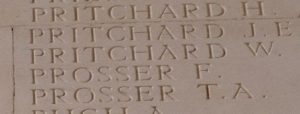
William Herbert Prosser, Private, 278, Royal Welsh Fusiliers. William was born at Llanfyllin in 1884, the son of Thomas Prosser and Mary Prosser (nee Dearden). The family later resided at 34, Canal Road, Newtown. William worked as a labourer for Newtown Council, and had served with the 5th Volunteer Battalion, South Wales Borderers for several years before enlisting into the 7th Battalion, Royal Welsh Fusiliers on 30 June 1908. The battalion was a Territorial Army unit, and William attended the annual summer TA camps at Abergavenny, Bow Street, Lamphey, Carnarvon, Rhyl, and Aberystwyth over the coming years. The battalion mobilised for war at Newtown in August 1914, as part of North Wales Brigade, Welsh Division and moved to Conway until the end of the month, before moving to Northampton. In December the Division moved to Cambridge, where William was found to be unfit for further military service, due to an old injury to his ankle, and he was discharged as medically unfit on 29 March 1915. He returned home to Newtown, where married Maud Jones in 1916, and the couple lived at 39, Ladywell Street, Newtown. William died on 17 October 1918. The 34-year-old was buried in St. David’s Churchyard, Newtown. He is not commemorated by the CWGC.
Thomas Osborne Pryce, Lance Corporal, 1048, Royal Welsh Fusiliers. Thomas was the son of Thomas and Annie Pryce, of Frankwell Terrace, Newtown. He married Caroline Amelia Rees, of 26, Crown Street, Newtown in 1907 and the couple had three daughters over the coming years. By 1911 Thomas was lodging at Bridge House, Wick, Dursley, Gloucestershire, where he worked as a clog block maker. He had enlisted at Newtown into the 7th Battalion, Royal Welsh Fusiliers several years prior to the war. The battalion was a Territorial unit, which mobilised for war at Newtown in August 1914, as part of North Wales Brigade, Welsh Division and moved to Conway until the end of the month, before moving to Northampton. In December the Division moved to Cambridge and then in May 1915 to Bedford, where the Division was numbered and the formation became 158 Brigade, 53rd (Welsh) Division. On 19 July 1915 the entire Division sailed from Devonport for Imbros and on 9 August 1915 landed at Suvla Bay. The infantry moved off the beaches across the Salt Lake, under shellfire, into the scrub covered Chocolate Hill, but due to a lack of maps and no knowledge of the terrain, many of the units became disorientated, and the situation became chaotic. Thomas became ill soon after the landings and was evacuated aboard the Hospital Ship Euripides for treatment. He died of dysentery aboard ship on 17 August 1915, aged 24. Thomas was buried at sea, so is commemorated on the Helles Memorial, Gallipoli.
Reginald Ernest Pryce-Jones, Lieutenant, Canadian Infantry. Reginald, known as Rex, was born at Kerry on 13 October 1896, the only child of Colonel Albert Westhead Pryce-Jones, OBE, and Mrs Rosina Ida Pryce-Jones (nee Gibson), and was the grandson of Sir Pryce Pryce-Jones, of the Royal Welsh Warehouse in Newtown. Rex moved to Canada with his parents in 1910 to set up the Canadian branch of the family business, the Pryce-Jones Department Store. Rex enlisted into the 103rd Calgary Rifles, a Militia unit, on his eighteenth birthday, on 13 October 1914 and on 2 January 1915 was commissioned into the 50th Battalion, Canadian Infantry. On 27 October 1915 he embarked for England with the battalion, and upon its arrival the battalion entrained for Bramshott. Reginald took ill in May 1916 and suffered a short spell in hospital suffering from bronchial catarrh. He re-joined the battalion as soon as he had recovered and embarked for France with the battalion on 11 August 1916. The battalion moved to the Somme sector, as part of the 10th Canadian Brigade, 4th Canadian Division, to join the Canadian Corps and moved to the Courcelette area. On 14 November the 50th Battalion moved into the front line at Regina Trench, and three days later volunteers were sought to go over the top and assault the German lines, some 200 yards in front. Rex was among the volunteers who went over the top, following an artillery barrage, on 18 November 1916, but was killed when the men became exposed to enfilade machine-gun and artillery fire. His body was recovered and carried back to Albert two days later, and the 20-year-old was buried in Albert Communal Cemetery Extension, France. Ernest was posthumously Mentioned in Despatches in the London Gazette of 1 June 1917.
Walter Pugh, Rifleman, 1185, Rifle Brigade (The Prince Consorts Own). Walter was the son of Henry and Emma Pugh, of 7, Sheep Street, Newtown. He had worked as a weaver at Newtown but left home as a young man to enlist into the Rifle Brigade at Winchester on 16 April 1891. Walter then served with the 4th Battalion Rifle Brigade for five years until being posted to the Depot, where he signed on in 1898 to extend his service, and over the coming years served both with the 1st and 2nd Battalions of the Rifle Brigade, seeing service during the Boer War in South Africa and then served in Malta. When war broke out, Walter was serving as a Corporal with the 1st Battalion, Rifle Brigade at Colchester, where it was attached to 11 Brigade, 4th Division. He embarked for France with the battalion on 23 August 1914, before entraining with the rest of the 4th Division to join the hard-pressed Divisions of II Corps and took part in The Battle of Le Cateau. The Division then took part in the epic retreat to the Marne, where the German Offensive was halted, and in the subsequent advance to the Aisne, where the Germans were defeated and forced to dig-in along the Chemin-des-Dames. The Division was then moved north to Flanders, and took part in the Battle of Messines, where units of 4th Division took part in the famous Christmas Truce while they were still in this area, in trenches near Ploegsteert Wood. In 1915 the Division fought at the Second Battle of Ypres. Walter was wounded in the head at some time afterwards and was evacuated back to England and sent to the Sheppey Union Minster Hospital for treatment. Walter was found dead in his room on 30 December 1915, having committed suicide by slashing his own throat with a razor. A subsequent court of enquiry ruled that he had committed suicide whilst temporarily insane, but in most likelihood, he was suffering from shellshock, or what is now known as PTSD. The 42-year-old was buried in Sheerness Cemetery, Isle of Sheppey, Kent. His nephew, Walter Charles Benbow, was killed in North Africa during World War Two.
Robert Rawson, Lance Corporal, 26534, Highland Light Infantry. Robert was born in Dumfries in 1885, the son of John and Annie Rawson. Within months of his birth the family had moved to 26, Crescent Street, Llanllwchaiarn, where Robert’s father had gained the position as manager of the Cambrian Woollen Mills. Robert followed his father into the business after leaving school and became a woollen designer, but just before the war had moved to Blodwen Lilea, Holywell. Robert enlisted into the army in Liverpool soon after the outbreak of war and as a native Scot, was posted to the Highland Light Infantry. Robert did not embark for France straight away but remained at home with one of the reserve battalions in Yorkshire. He married Annie Elsie Rees, of Glendene, Newtown, in Yorkshire in the Spring of 1916, just prior to being drafted out to France, and was posted to the 12th Battalion, Highland Light Infantry, which was attached to 46 Brigade, 15th (Scottish) Division. Their only child was born soon afterwards, on 21 March 1916. Robert joined the battalion at Loos, where it had spent the winter having seen its first major action during the Battle of Loos in the previous September. At the end of March, the Division was relieved and moved back into Corps Reserve around Lillers. By 25 April 1916 the Division had moved back into the line in the Hohenzollern Sector and two days later the line was attacked by the Germans with the use of poison gas, which drifted across the line held by the 15th Division and was followed by an infantry assault. The Scotsmen held their line under heavy pressure, but the Division staunchly defended the Kink position. To the south the Somme offensive opened on 1 July 1916 and soon afterwards the 15th Division was relieved, before being transferred south to join the great push. The Division reached Albert by 7 August and marched forwards into the battle zone. On 12 August the Division launched an assault against the German switch line near High Wood. Despite the gallant efforts of the men, the attack was called off due to heavy machine-gun fire which caused terrible casualties and the survivors withdrew to their own trenches. Robert was killed in action just prior to the relief of his battalion on the following day, 13 August 1916. The 31-year-old has no known grave and is commemorated on the Thiepval Memorial, France.
Thomas Ewart Rees, Private, 46258, Cheshire Regiment. Thomas was the son of Thomas Rees and Mildred Rees (nee Tilsley), of Canal Road, Newtown. He worked for his father at Canal Shop, Newtown prior to the war. Thomas married Lily Elizabeth Barnes at Newtown in 1916. Soon afterwards he was drafted to France to join the Cheshire Regiment, but was transferred to the Labour Corps, probably due to ill health. Thomas was back home on leave about a month prior to the Armistice when he died of disease on 30 October 1918. The 31-year-old was buried in Newtown and Llanllwchaiarn Cemetery.
Thomas Ivor Rees, Private, 20336, Royal Fusiliers. Thomas was the son of Richard Rees and Miriam Amelia Rees (nee Williams), of Westwood, Newtown. He had left home as a young man after completing his education at Newtown County School to work as a bank assistant at the London County and Midland Bank at Aberystwyth, before transferring to their Ruabon branch. Thomas enlisted into the army at Wrexham and was posted to the 26th (Bankers) Battalion, Royal Fusiliers. The battalion had been raised by the Lord Mayor and City of London in July 1915 from Bank Clerks and Accountants, before moving to Aldershot to join 124 Brigade, 41st Division. On 4 May 1916 the Division embarked for France, moving to the Ploegsteert Sector for trench initiation and training. To the south, the Battle of the Somme had opened on 1 July 1916, but had become bogged down, despite terrible casualties. In the middle of August, the 41st Division was relieved and entrained at Bailleul, detraining at Pont Remy some ten hours later, before the men marched into billets in local villages. A short period of training then followed before the Division began marching towards the Somme battle area, reaching Fricourt by 13 September. The Division then moved into positions near Delville Wood and on 16 September launched an assault from the wood, with the support of tanks, as part of the greater Battle of Flers-Courcelette. The Division gained its objectives before digging in and remained in the line, pushing on to Courcelette over the next few days before coming out for a rest and re-fit. By 5 October the Banker’s Battalion had moved back into the front line at Gird Support and Gird Trench. During the afternoon of 7 October 1916, the Division launched another assault, but suffered heavily during a terrible day of fighting. Thomas was killed in action during the fighting that day. The 24-year-old has no known grave and is commemorated on the Thiepval Memorial, France. His brother, Gwilym Havard Rees, was awarded the Military Medal during the war.
William Ernest Rees, Private, 8820, South Wales Borderers. William was the son of Charles Rees and Caroline Amelia Rees (nee Jones), of 6, Ann Street, Newtown. He left home as a young man to enlist into the 24th Regiment of Foot, South Wales Borderers, and served for several years prior to the outbreak of war. William embarked for France with the 1st Battalion, South Wales Borderers on 13 August 1914. The battalion was attached to 3 Brigade, 1st Division and had been one of the first to arrive in France, fighting at the Battle of Mons, and taking part in the retreat to the Marne, where the Germans were stopped. They then fought at the Aisne, and at Chivy, before being moved north to Ypres. Here they fought at the First Battle of Ypres, where they again stopped the German Offensive, before wintering in Flanders in the Richebourg sector. The 1st Division took part in its first major action of 1915 on 9 May 1915, during the Battle of Aubers Ridge, when it attacked alongside the Meerut Division. The attack of the 2nd Welsh was held up by a flooded ditch, which the men forded, before being hit by heavy machine-gun fire, and many casualties were suffered before the survivors withdrew. William was taken ill soon afterwards and was evacuated to the 2nd General Hospital at Le Havre. He died of pneumonia there on 22 June 1915. The 28-year-old was buried in Ste. Marie Cemetery, Le Havre, France.
Bertie Thomas Reynolds, Private, G/13344, Queen’s Own (Royal West Kent Regiment). Bert was the son of Herbert Edward Reynolds and Mary Ann Reynolds (nee Davies), of 24, New Church Street, Newtown. He worked as a Compositor prior to the war. Bert had enlisted at Newtown into the 7th Battalion, Royal Welsh Fusiliers on 12 September 1914. The battalion was a Territorial unit, which mobilised for war at Newtown in August 1914, as part of North Wales Brigade, Welsh Division and moved to Conway until the end of the month, before moving to Northampton. In December the Division moved to Cambridge and then in May 1915 to Bedford, where the Division was numbered and the formation became 158 Brigade, 53rd (Welsh) Division. Bert then transferred to the 47th Provisional Battalion, before being transferred to the Queen’s Own (Royal West Kent Regiment) on 13 April 1916. He embarked for France on 4 July 1916, joining the 7th Battalion, Queen’s Own (Royal West Kent Regiment, which was attached to 55 Brigade, 18th (Eastern) Division. Bert joined the battalion on the Somme, where it was refitting following its efforts during the opening assault of the Somme offensive on 1 July. After a brief rest the Division marched via Maricourt back into the battle zone on 12 July and on the following day launched an assault on Trônes Wood, as part of the Battle of Bazentin, capturing the wood and consolidating its gains before being relieved on 19 July. The Division then moved to the St. Omer area to rest and refit, spending a short time in the trenches at Bois Grenier before moving back to the Somme on 25 August, reaching Monchy-Breton the following day, where a system of training was carried out. On 26 September the Division began marching back into the Somme battle area, reaching Authille before taking over positions around the ruins of Thiepval Chateau. Bert’s battalion then endured a torrid spell in the line whilst fighting raged to their front at the Schwaben Redoubt. On 30 September 1916 the battalion joined the fight for the Redoubt, bombing its way through the German trenches. The battalion was making inroads into the Redoubts defences when it was subjected to an artillery barrage from a British battery which was firing short, causing some 25 casualties from friendly fire. Despite this the attack continued and fighting raged throughout the day. Bert was killed in action at some time during this attack on the Schwaben Redoubt that day. The 22-year-old has no known grave and is commemorated on the Thiepval Memorial, France, very near to where he was killed.
Harold Reynolds, Private, 822, Royal Welsh Fusiliers. Harold was the son of Richard Gittins Reynolds and Martha Reynolds (nee Owens), of Park Street, Newtown. He worked as a clerk at the Royal Welsh Warehouse prior to the war. Harold had enlisted at Newtown into the 7th Battalion, Royal Welsh Fusiliers several years prior to the war. The battalion was a Territorial unit, which mobilised for war at Newtown in August 1914, as part of North Wales Brigade, Welsh Division and moved to Conway until the end of the month, before moving to Northampton. In December the Division moved to Cambridge, then soon afterwards Harold was transferred to the 2/7th Battalion, Royal Welsh Fusiliers, a reserve battalion, at Northampton. Harold took ill soon afterwards and died at the Cambridge Military Hospital on 22 April 1915. The remains of the 20-year-old were brought back home, and he was buried with full military honours in Newtown and Llanllwchaiarn Cemetery.
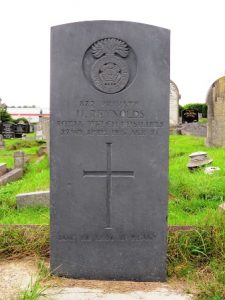
Charles Ewart Roberts, Private, 1240, 1st King Edward’s Horse. Charles was the son of Henry Roberts and Mary Ellen Roberts (nee Williams), of Pool Crescent, Newtown. He worked as a dairyman prior to the war. Charles enlisted into the army at Newtown and was posted to the 1st King Edward’s Horse. The regiment was a unit of the Special Reserve which had originally been formed to serve with the Imperial Yeomanry in the Second Boer War. It was mobilised upon the declaration of war and temporarily attached to the 4th Cavalry Brigade, but in April 1915, the regiment was split up into three Squadrons, which all moved to France with different units. In November 1917 the three Squadrons merged and were sent to Italy as part of the force sent to bolster the beleaguered Italians on the Italian front but following the launching of the German offensive on the Somme on 21 March 1918, the King Edward’s Horse was among several units recalled to France to replace a number of severely depleted units. The King Edward’s Horse moved to Flanders to hold a section of the front near Vieille Chapelle but was unfortunately hit hard when the Germans launched the second phase of their offensive along the Lys Valley on 9 April 1918. The regiment fought a gallant defensive action around Huit Maisons and Vieille Chapelle over the coming days, suffering terrible casualties. Charles was killed in action on the first day of the battle, on 9 April 1918. The 30-year-old is buried in Vieille-Chapelle New Military Cemetery, Lacouture, France.
Harold Seymour Roberts, Private, 9950, King’s Shropshire Light Infantry. Harold was the son of Reuben Roberts, a renowned harpist, and Ellen Roberts (nee Woods), of Crescent Street, Llanllwchaiarn. He had left home by 1911 to work as a bootman at the Corbett Hotel, Tywyn, then on 4 May 1912 enlisted at Shrewsbury into the King’s Shropshire Light Infantry. After completing his training at the Depot in Shrewsbury, Harold was posted to the 1st Battalion, King’s Shropshire Light Infantry on 23 November 1912. The battalion was at Tipperary attached to 16 Brigade, 6th Division when war was declared, then moved to Cambridge with the Division before the entire Division embarked for France, landing at St. Nazaire on 10 September 1914. The Division then moved to the Aisne, to bolster the hard-pressed BEF, before the whole army was moved north into Flanders in the middle of October. The 6th Division moved to positions near Bois Grenier and took over a section of line at Le Quesne. Harold was shot in the head at the end of October 1914, the bullet entering above his left eyebrow and exiting his right temple and he was evacuated to Hospital before being sent back to England via Hospital Ship for further treatment. He received further treatment at Chester Military Hospital before being sent to Lodge Hill Hospital at Birmingham, but eventually died there of his wounds on 1 March 1916. The 22-year-old was buried in Birmingham (Lodge Hill) Cemetery. One of his brothers, James Hoddell Roberts, was killed at Gallipoli in 1915.
Hugh Pugh Roberts, Private, 285138, South Wales Borderers. Hugh was the son of John and Jane Roberts, of Bryn Horeb, Aberangell. He worked as a postman prior to enlisting at Newtown into the 7th Battalion, Royal Welsh Fusiliers on 2 December 1914 and was posted to Park Hall camp, Oswestry, joining the 3/7th Battalion. On 13 June 1917 Hugh was posted to No 5 Infantry Base Depot in France, and from there was transferred to the Monmouthshire Regiment. He was then posted to the 2nd Battalion, South Wales Borderers, which was attached to 87 Brigade, 29th Division. Hugh joined up with the battalion at Ypres, where it was preparing to take part in the Third Battle of Ypres, which was launched on 31 July 1917. On 15 August the battalion moved forwards towards the Steenbeek and took up support positions near Saules Farm, in preparation to launch an attack on the following morning. At 04.45 on 16 August 1917 the artillery barrage opened, and the men arose from their trenches, storming their objectives, near to the ruined hamlet of Wijdendrift, near Langemarck. Hugh was among four officers and 27 men killed during the days fighting. The 22-year-old is buried in Artillery Wood Cemetery, Belgium.
James Hoddell Roberts, Lance Corporal, 10422, South Wales Borderers. James was the son of Reuben Roberts, a renowned harpist, and Ellen Roberts (nee Woods), of Crescent Street, Llanllwchaiarn. James left home as a young man to enlist at Welshpool into the 24th Regiment of Foot, South Wales Borderers on 1 April 1907, and by 1911 was stationed at Chatham with the 1st Battalion, South Wales Borderers. He was then posted to the 2nd Battalion, South Wales Borderers. The battalion was stationed at Tientsin, China at the outbreak of war, then on 23 September 1914 landed at Lao Shan Bay for operations in conjunction with the Japanese against the German held port of Tsingtao. Following the successful capture of Tsingtao, the 2nd SWB embarked at Hong Kong on 4 December for England and upon disembarking at Plymouth on 12 January 1915 moved to Rugby to join 87 Brigade, 29th Division. On 17 March 1915 the Division sailed from Avonmouth for Alexandria, before sailing for Mudros Harbour aboard HMS Cornwallis. At dawn on 25 April 1915 the Division landed under heavy fire at Morto Bay, Gallipoli, with D Company of the 2nd SWB being assigned the task of capturing De Tott’s Battery, while B and C Companies secured the surrounding area. James was wounded during the terrible fighting over the coming days. He was evacuated aboard an awaiting Hospital Ship but died at sea of his wounds on 29 April 1915. The 21-year-old has no known grave and is commemorated on the Helles Memorial, Gallipoli. One of his brothers, Harold, died on active service in 1916.
John Henry Roberts, Private, 52483, Royal Army Medical Corps. John was the son of Thomas and Martha Roberts of 1, Frolic Street, Newtown. He married Mary Emma Roberts, a farm servant from Montford Bridge, in 1906 and by 1911 the couple were living at Penderyn, Aberdare, where John was working as a railway platelayer. He enlisted at Brecon into the Royal Army Medical Corps soon after the outbreak of war and on 21 June 1915 was posted aboard the Hospital Ship SS Galeka. The ship had been requisitioned from the Union-Castle Line by the Admiralty and was initially used as a troop transport before being converted into a Hospital Ship with accommodation for 366 wounded passengers. On 28 October 1916 Galeka was entering Le Havre to collect wounded men from the Somme offensive when she struck a mine which had been laid by the German submarine UC-26 and sank with the loss of 19 RAMC personnel. John was 35 years old when he drowned in the sinking of Galeka. He is commemorated on the Galeka Memorial in Ste. Marie Cemetery, Le Havre, France.
Wilfred Austin Rowe, Corporal, 20732, Army Pay Corps. Wilfred was the son of Thomas and Christiana Rowe, of 13, Mitford Street, Harpurhey, Manchester. He moved to Newtown prior to the war after gaining work there as a Clerk and in 1915 married Alice Elizabeth Owen, of 17, Crescent Street, Newtown. Wilfred enlisted into the Army Pay Corps at some time afterwards. He served at home with the Army Pay Corps throughout the duration of the war and remained in the army after the Armistice. Wilfred became ill during the winter of 1919-1920 and was invalided to Hospital at Whalley, Lancashire, where he died of heart failure on 27 March 1920. The 27-year-old was buried in St. Joseph’s Roman Catholic Cemetery, Moston, Manchester.
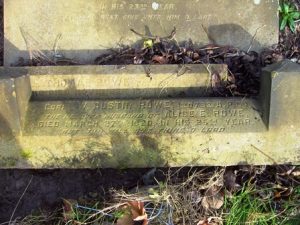
John Morris Rowlands, Private, 808318, Canadian Infantry. John was born in Ystrad, Rhondda on 16 August 1890, the son of John and Ann Rowlands. The family later resided at Freestone Rock, Llanllwchaiarn. John had emigrated to Canada prior to 1909, and married Mary Lavinia Bramwell, of Michigan. The couple lived at 1108, 7th Avenue, West Calgary, Alberta, where John worked as a miner. He enlisted into the Canadian Infantry at Drumhella, Alberta on 27 January 1916 and embarked for England from Halifax with the 137th Overseas Battalion, Canadian Infantry on 22 August 1916. The battalion disembarked at Liverpool before entraining for the Canadian camp at Withey, for further training. On 29 November 1916 John landed in France, and was posted to the 31st Battalion, Canadian Infantry, which was attached to the 6th Brigade, 2nd Canadian Division. John would have arrived in time to take part in the latter stages of the Somme offensive, and in the Spring of 1917 would have taken part in the Battle of Vimy Ridge. John was wounded on 29 July 1917, but remained at duty, taking part in the Battle of Passchendaele, and on 22 November was awarded two weeks leave, returning to England to see his wife Mary, who had left Canada to live in 34, Enville Street, Ashton-under-Lyne, with their daughter, Anna. He re-joined the battalion in France and would have taken part in the great Canadian victory at Villers-Bretonneux on 8 August 1918, before the launching of the great Allied offensive, which won the war, on 21 August 1918. John survived the war, and came home on leave, but took ill and died of influenza at the Military Hospital, Endell Street, London on 3 December 1918, aged 36. He is buried in Brookwood Military Cemetery, Surrey.
David Charles Sapple, Private, 1140, Royal Welsh Fusiliers. David was born at Newtown in 1898, the son of Richard James Sapple and Mary Jane Sapple (nee Williams). The family moved to 1, Chapel Street, Welshpool when David was young. He enlisted at Welshpool into the 7th Battalion, Royal Welsh Fusiliers. The battalion was a Territorial unit, which mobilised for war at Newtown in August 1914, as part of North Wales Brigade, Welsh Division and moved to Conway until the end of the month, before moving to Northampton. In December the Division moved to Cambridge and then in May 1915 to Bedford, where the Division was numbered and the formation became 158 Brigade, 53rd (Welsh) Division. On 19 July 1915 the entire Division sailed from Devonport for Imbros and on 9 August 1915 landed at Suvla Bay. The infantry moved off the beaches across the Salt Lake, under shellfire, into the scrub covered Chocolate Hill, but due to a lack of maps and no knowledge of the terrain, many of the units became disorientated, and the situation became chaotic. David was killed in action on the following day, 10 August 1915. The 17-year-old has no known grave and is commemorated on the Helles Memorial, Gallipoli.
Sheppard, B. B. This man cannot presently be identified, although a Bertie Benjamin Shepherd, of Bristol, married Louisa Hughes at Newtown in 1918.
Smith, A. H. This man cannot presently be identified.
Frank Sykes, Private, 3457, Royal Welsh Fusiliers. Frank was the son of Arthur and Mary Elizabeth Sykes, of Almondsbury, Yorkshire. He worked as a Mill Hand at Almondsbury prior to the war. Frank married Catherine Selina Morgan, of Evans Court, Ladywell Street, Newtown at Almondsbury on 26 December 1913. Catherine had given birth to an illegitimate son in 1910 and it appears that she was sent away to Yorkshire by her parents. Frank enlisted into the 8th Battalion, Duke of Wellington’s (West Riding Regiment) at Huddersfield on 1 September 1914. Frank was discharged as unlikely to become an efficient soldier on 26 October. He then moved to Newtown with Catherine and their infant son, Thomas and re-enlisted there into the 7th Battalion, Royal Welsh Fusiliers. The battalion was a Territorial unit, which mobilised for war at Newtown in August 1914, as part of North Wales Brigade, Welsh Division and moved to Conway until the end of the month, before moving to Northampton. In December the Division moved to Cambridge and then in May 1915 to Bedford, where the Division was numbered and the formation became 158 Brigade, 53rd (Welsh) Division. On 19 July 1915 the entire Division sailed from Devonport for Imbros and on 9 August 1915 landed at Suvla Bay. The infantry moved off the beaches across the Salt Lake, under shellfire, into the scrub covered Chocolate Hill, but due to a lack of maps and no knowledge of the terrain, many of the units became disorientated, and the situation became chaotic. After the fighting died down, the winter rolled in, and the men first had to endure torrential downpours, which flooded the trenches, before the snow hit, and many men began falling ill in the terrible conditions. Frank was killed in action at Gallipoli on 1 December 1915, just before the evacuation of the Peninsula. The 23-year-old is buried in Lala Baba Cemetery, Gallipoli. His widow Catherine remarried in 1917 and lived until 1973.
Eric Lawrence Talbot, Lieutenant, Royal Horse Artillery. Eric was born on 15 December 1883, the son of John Arthur Talbot and Alice Buckley Talbot, of Milford Hall, Newtown. He was educated at Marlborough College before attending the Royal Military Academy at Sandhurst, then gained a commission as Second Lieutenant into the Royal Field Artillery on 31 July 1902 and was posted with the 50th Battery in Ireland. In 1905 he was promoted to Lieutenant, and in 1908 transferred to the 58th Battery, before being posted to Neemuch, India. In July 1910 he transferred to ‘T’ Battery, Royal Horse Artillery at Ambala, India before moving to Abbasiyah, Egypt, then came back to England for a posting with ‘P’ Battery at Woolwich. Following the outbreak of war Eric volunteered for active service and was posted to ‘C’ Battery, Royal Horse Artillery. The battery was mobilised on 8 October 1914 and landed at Zeebrugge as part of the 14th Brigade, RHA, under the command of the 7th Division. Unfortunately, by the time that the 7th Division arrived, Zeebrugge was in the process of falling to the Germans, so the Division was forced to move south to Ypres, to help in the defence of the strategically important city. Eric’s battery moved into position near Zandvoorde on 16 October and set up defensive positions to cover the Menin Road. Two days later, upon receiving intelligence that the Germans were advancing on the city of Ypres, C Battery advanced to Kruiseik and dug in facing Vervicq where C Battery fired its first rounds, whilst ranging its guns. On the following day, 19 October 1914, the Germans began their attack on the Ypres defensive line and C Battery came into action. Heavy fighting raged over the coming days as the Allies desperately tried to avoid a German breakthrough. Eric was wounded on 23 August 1914, during the peak of the fighting and was evacuated by ambulance to Ypres. Sadly, he died on his way to the city’s hospital soon afterwards. The 30-year-old was buried in Ypres Town Cemetery, Belgium.
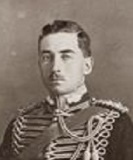
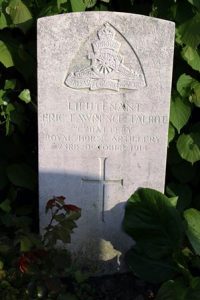
Robert John Taylor, Private, 38896, South Wales Borderers. Robert was the son of Dennis Taylor and Harriet Taylor (nee Wood), of Church House, Llanllwchaiarn. He worked as a gamekeeper on the Newtown Hall Estate prior to enlisting into the Training Reserve at Wrexham in 1916 and was drafted to France the following year, joining the 2nd Battalion, South Wales Borderers, which was attached to 87 Brigade, 29th Division. In the Spring of 1917, the Division fought at the Battle of the Scarpe, which was part of the Arras Offensive, seeing heavy fighting around Monchy-le-Preux, and then moved further north to Ypres, initially to hold the line whilst other units had been withdrawn for specialist training, in readiness for the Third Battle of Ypres, which opened on 31 July 1917. The 29th Division went into reserve whilst the first attacks, the Battle of Pilckem Ridge, took place, then on the night of 14-15 August the 2nd SWB moved into the line facing Langemarck, ready to launch another offensive. On the following day the battalion reconnoitred the ground in front of them, and laid white tapes in No Man’s Land, to guide the attacking troops, and at dawn on 16 August 1917 the 2nd SWB launched an attack on Langemarck. The battalion successfully took its two objectives but had suffered 163 casualties. The Division then had another period out of the line to rest and refit before taking part in further fighting near Poelcapelle. Early in October 1917 the Division was relieved from the line at Ypres, and moved south to the Bellacourt area, to prepare to take part in the forthcoming Battle of Cambrai. The Division entrained for Péronne on 17 November, marching to a camp four miles out of the town at Haut Allaines, then by midnight on 18 November had reached Fins. On the following day the Division received its battle stores and detailed orders for the forthcoming battle, marching off via Gouzeaucourt to its assembly positions at Marcoing. The assault began at dawn on 20 November, but the Division suffered terrible casualties whilst attacking Masnières, on the Hindenburg Line. On 3 December the Division was relieved and enjoyed several weeks in the rear area, resting and refitting, before being transferred to the Ypres Salient, reaching Proven by 3 January 1918, where the men of the 2nd SWB began work behind the lines. On 3 February the 2nd SWB moved into the front line on the Goudberg Spur and began work on the Bellevue Defences. During the morning of 7 February, D Company was attacked by an enemy patrol, which threw hand grenades into its trenches. Robert was badly injured by shrapnel from an exploding hand grenade and was evacuated to the 44th Casualty Clearing Station near Poperinghe for treatment. He died of his wounds there on 9 February 1918. The 19-year-old was buried in Nine Elms British Cemetery, Poperinghe, Belgium.
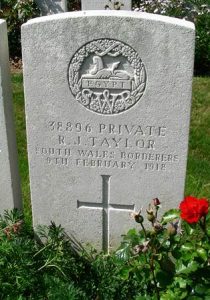
Humphrey Richard Thomas, Corporal, 291007, Royal Welsh Fusiliers. Humphrey was the son of Humphrey and Jane Thomas, of Frankwell Street, Newtown. He worked as a coalminer at Aberfan prior to the war but had returned to Newtown to enlist into the 7th Battalion, Royal Welsh Fusiliers on 12 March 1915. The battalion was a Territorial unit, which mobilised for war at Newtown in August 1914, as part of North Wales Brigade, Welsh Division and moved to Conway until the end of the month, before moving to Northampton. In December the Division moved to Cambridge and then in May 1915 to Bedford, where the Division was numbered and the formation became 158 Brigade, 53rd (Welsh) Division. On 19 July 1915 the entire Division sailed from Devonport for Imbros and on 9 August 1915 landed at Suvla Bay. The infantry moved off the beaches across the Salt Lake, under shellfire, into the scrub covered Chocolate Hill, but due to a lack of maps and no knowledge of the terrain, many of the units became disorientated, and the situation became chaotic. After the fighting died down, the winter rolled in, and the men first had to endure torrential downpours, which flooded the trenches, before the snow hit, and many men began falling ill in the terrible conditions. Humphrey contracted dysentery due to the terrible conditions on the Peninsula and was evacuated via hospital ship in December before being taken to the 2nd Southern General Hospital at Southmead, Bristol. Upon recovering he was posted to the 3/7th Battalion, Royal Welsh Fusiliers at Oswestry and soon afterwards spent a while at Oswestry Hospital suffering from rheumatic fever. Humphrey embarked for France at Southampton on 20 May 1917 and joined the Infantry Base Depot at Rouen. He was posted to the 15th Battalion, Royal Welsh Fusiliers on 12 June 1917 and joined the battalion at Ypres, where it was attached to 113 Brigade, 38th (Welsh) Division. The Division was preparing to launch an assault against the Pilckem Ridge, as part of the opening offensive of the Third Battle of Ypres, and its infantry brigades were taking turns training behind the lines by the time that Humphrey arrived. The 15th RWF completed its training by 23 July and moved back into the line on the Canal Bank that afternoon. On 27 July 1917 the battalion received reports from the Royal Flying Corps that the Germans had withdrawn, so a strong patrol was sent out to investigate. Unfortunately, the reports proved false, and the patrol came under heavy fire in No Man’s Land, before being forced to withdraw and the Germans opened a terrific artillery bombardment upon the battalions’ trenches in retaliation. Humphrey was killed in action at some time during the day. The 27-year-old has no known grave and is commemorated on the Ypres (Menin Gate) Memorial, Belgium.
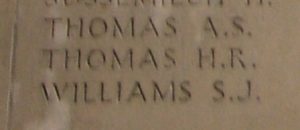
William Henry Thomas, Sergeant, 103210, Royal Garrison Artillery. William was born on 25 October 1880, the son of Lewis Thomas and Jane Thomas of Bryn Street, Newtown. He entered the University College of North Wales at Bangor in 1903 and upon graduating took up a career in teaching, becoming a schoolmaster at Penygloddfa School. William married Agnes Florence Thomas at Newtown on 5 August 1909 and the couple lived at 25, Crescent Road, Newtown where their three children were born. William enlisted into the Royal Garrison Artillery at Newtown on 11 December 1915 and was initially placed on the Army Reserve. He was mobilised on 4 July 1916 and was posted to Fort Brockhurst at Gosport for training. William then undertook a specialist course of Plotting Observation of Fire at Shoreham-by-Sea before being posted to the 203rd Siege Battery, Royal Garrison Artillery and embarked for France with the Battery on 19 December 1916. The battery moved to the Flanders coast, near Coxyde, to prepare for a possible offensive on the coast, dependent on whether the forthcoming Passchendaele offensive resulted in a breakthrough and spent the coming months firing at strategic targets to the north. William was promoted to Sergeant on 10 April, following the wounding of Sergeant Mayne, who had been invalided home. He was badly wounded by a German shell on 10 July 1917 and died of his wounds that dame day, aged 36. William is buried in Coxyde Military Cemetery, Belgium.
John Richard Tudor, Driver, 33041, Royal Field Artillery. John was the son of Richard Tudor and Sarah Mary Tudor, of Back Lane, Newtown. He had served with the 67th Battery, Royal Field Artillery in South Africa during the second Anglo-Boer War of 1899-1901 and upon his return home left the army and worked as a coal hewer in Bargoed. When war was declared, John re-enlisted into the Royal Field Artillery and embarked for France with the 50th Battery of the 34th Brigade, RFA on 16 August 1915. The Brigade was attached to the 2nd Division of the BEF and moved to the Belgian Frontier, near Mons, taking part in the Battle of Mons and in the subsequent withdrawal past Le Cateau to the River Marne, where the German drive on Paris was stopped. The Allies then drove the Germans back across the River Aisne and beat them in battle, forcing the Germans to entrench along the Chemin-des-Dames ridge. The BEF then moved north into Flanders and dug in along a section of line running south from Ypres to Neuve Chapelle. John was badly wounded during the First Battle of Ypres, during the BEF’s gallant defensive action to save the city and died of his wounds on 15 November 1914. The 37-year-old has no known grave and is commemorated on the Ypres (Menin Gate) Memorial, Belgium.
Charles Watkins, Private, 290864, Royal Welsh Fusiliers. Charles was an orphan who, together with his sister Rosa, were adopted by David and Eleanor Jones, of Llwydcoed Farm, Aberhafesp. He worked as a Waggoner prior to the war. Charles enlisted into the 7th Battalion, Royal Welsh Fusiliers at Newtown on 19 November 1914. The battalion was a Territorial unit, which mobilised for war at Newtown in August 1914, as part of North Wales Brigade, Welsh Division and moved to Conway until the end of the month, before moving to Northampton. In December the Division moved to Cambridge and then in May 1915 to Bedford, where the Division was numbered and the formation became 158 Brigade, 53rd (Welsh) Division. On 19 July 1915 the entire Division sailed from Devonport for Imbros and on 9 August 1915 landed at Suvla Bay. The infantry moved off the beaches into the bush, but due to a lack of maps and no knowledge of the terrain, many of the units became disorientated, and the situation became chaotic. The Division was eventually evacuated from Gallipoli in December 1915, moving to Egypt to join the EEF, and helped guard the Suez Canal before taking part in operations to drive the Turks out of the Sinai. The EEF then turned its attention onto driving the Turks out of Palestine, and on 26 March 1917 launched its first offensive against the coastal city of Gaza, which guarded the road to Jerusalem. Initial gains during the day were lost when the assaulting divisions lost touch with each other, and communication broke down when a thick fog cloaked the battlefield. A second attempt to force Gaza was launched on 17 April, which also failed, and the EEF suffered a change in leadership, with Sir Edmund Allenby assuming command, before being re-organised, and a third offensive was launched against a wider front from Beersheba to Gaza on 31 October 1917. This time the Turkish defences were breached, and the road to Jerusalem now lay open and the EEF began to advance north. On 6 November 1917, 158 Brigade launched an attack on the Khuweilfeh Heights. Charles was killed in action during the fighting that day. The 24-year-old has no known grave and is commemorated on the Jerusalem Memorial, Israel.
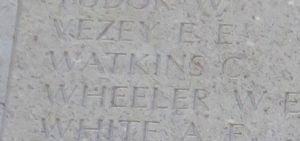
Joseph Watkins, Private, 290755, Royal Welsh Fusiliers. Joseph was the son of Charles and Sarah Watkins, of Junction Villas, Cheney Longville. He came to Newtown to find work as a labourer prior to the war. Joseph enlisted into the 7th Battalion, Royal Welsh Fusiliers at Welshpool on 20 October 1914 and was posted to the 2/7th Battalion, Royal Welsh Fusiliers at Park Hall Camp, Oswestry. He embarked for Egypt at Devonport on 27 January 1916 and upon disembarking at Alexandria was posted to the 1/7th Battalion, Royal Welsh Fusiliers. The battalion was attached to 158 Brigade, 53rd (Welsh) Division and had been eventually evacuated from Gallipoli in December 1915, moving to Egypt to join the EEF, and helped guard the Suez Canal before taking part in operations to drive the Turks out of the Sinai. The EEF then turned its attention onto driving the Turks out of Palestine, and on 26 March 1917 launched its first offensive against the coastal city of Gaza, which guarded the road to Jerusalem. Initial gains during the day were lost when the assaulting divisions lost touch with each other, and communication broke down when a thick fog cloaked the battlefield. Joseph was killed in action during the terrible fighting that day. The 21-year-old is buried in Gaza War Cemetery. His nephew, Samuel Thomas Rundle, was killed whilst serving with the Royal Australian Air Force in 1943.
Walter Harold Watts, Private, 290792, Royal Welsh Fusiliers. Walter was the son of Edward Alfred Watts and Margaret Watts (nee Parry), of 2, Glenafan Terrace, Frankwell Street, Newtown. He worked as a shoe repairer prior to the war. Walter enlisted at Newtown into the 7th Battalion, Royal Welsh Fusiliers on 3 November 1914. The battalion was a Territorial unit, which mobilised for war at Newtown in August 1914, as part of North Wales Brigade, Welsh Division and moved to Conway until the end of the month, before moving to Northampton. In December the Division moved to Cambridge and then in May 1915 to Bedford, where the Division was numbered and the formation became 158 Brigade, 53rd (Welsh) Division. Walter was then transferred to the 47th Provisional Battalion before being sent to join the 3/7th Battalion, Royal Welsh Fusiliers at Oswestry. He embarked at Southampton for Alexandria on 15 March 1917 and after disembarking was posted to the newly formed 24th Battalion, Royal Welsh Fusiliers. The battalion had been formed from the Denbighshire Yeomanry in Egypt on 1 March 1917, joining 231 Brigade, 74th (Yeomanry) Division, and saw its first major action during the Second Battle of Gaza on 17 April. The battle was a failure, and the EEF was re-organised under a new commander, Sir Edmund Allenby, before launching the Third Battle of Gaza on the night of 31 October 1917. This assault was launched along a winder front, running from Gaza to Beersheba, and this time the EEF prevailed, opening the door to Jerusalem. The Division then took part in the drive north into Syria, but as a result of the heavy losses suffered in France, following the launching of the three German Spring offensives from 21 March 1918, was sent to France, landing in Marseilles on 7 May 1918. The Division underwent a system of training, to prepare it for the vastly different conditions on the Western Front, before taking over a section of the front in the St. Floris Sector. At the end of August, the Division moved south to the Somme sector, to join the great offensive, and on 18 September took part in an assault on positions near Lempire and Ronssoy, which formed part of the outer defensive line for the Hindenburg Line. After suffering heavy casualties, especially around Orchard Post and Gillemont Farm, the Division then attacked the Quadrilateral defences, suffering heavily again before being relieved on 24 September and entrained at Péronne for northern France once more. The Division then took part in the Advance in Flanders, and by the end of October had reached Marquion. Walter was killed in action during a successful assault to capture the village of Caster on 31 October 1918, which saw the 24th RWF alone capture 12 field guns and 250 prisoners. The 21-year-old is buried in Ingoyghem Military Cemetery, Belgium.
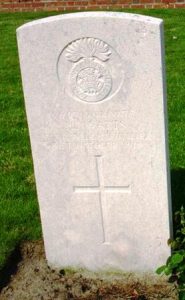
David Williams, Private, 464244, Canadian Infantry. David was born at Newtown on 17 September 1883, the son of James and Polly Williams. His parents moved from Newtown to 88, Mackintosh Place, Roath, Cardiff, whilst David remained in Newtown and worked for caterer Henry Vickers, of Broad Street. He emigrated to Canada some years prior to the war and found work as a baker in British Columbia. David enlisted into the Canadian Expeditionary Force at Vernon, British Columbia on 1 September 1915 and was posted to the 62nd Battalion, Canadian Infantry. David embarked at Halifax aboard HMT Baltic on 1 April 1916 and disembarked at Liverpool eight days later. He then entrained for Bramshott where he was transferred to the 54th (Kootenay) Battalion, Canadian Infantry. The battalion was attached to the 11th Infantry Brigade, 4th Canadian Division and embarked for France on 13 August 1916, joining the Canadian Corps south of Ypres. In September the Canadians moved south to the Somme and joined the great battle there, relieving the Australians at Pozieres and continuing the attacks on Mouquet Farm. After the fall of the farm the Canadians assaulted and captured Regina trench, remaining on the Somme until the end of December when the entire Canadian Corps moved north to the Arras sector, facing Vimy Ridge. On 1 March 1917 the 54th Battalion took part in a well-organised gas attack carried out by the Division against the German lines. Unfortunately, the gas cloud drifted south and was ineffectual, so as the Canadians attacked, the German machine-gunners were ready and caused terrible casualties before forcing the Canadians to withdraw. David was killed in action during the abortive assault that day. The remains of the 33-year-old were later recovered, and he was buried in Villers Station Cemetery, Villers-Au-Bois, France.
Eric Victor Owen Williams, Private, 202010, Tank Corps. Eric was the son of John Williams and Laura Adela Williams, of Glenville, Newtown. He worked as a clerk in Lloyds Bank at Tywyn prior to the war. Eric enlisted at Tywyn into the Machine Gun Corps but after being drafted to France was posted to the 8th Battalion, Tank Corps. Eric probably arrived in France in time to take part in the Battle of Cambrai, where the massed use of tank formations helped break the Hindenburg Line. His battalion wintered in the Cambrai sector, moving to the Velu Wood sector in February 1918. The weeks following the move were relatively quiet, but the men on the Allied side of the line knew that the Germans were preparing for a large-scale offensive, as the activity behind the enemy lines was rising to a fever pitch. At dawn on 21 March 1918 the Germans launched an attack against the stretch of Western Front running south from Croisilles to La Fère, smashing the line in several placed and forcing the British to carry out a fighting withdrawal. The 8th Battalion, Tank Corps received news of these events before launching a desperate counterattack near Doignies that afternoon but was forced to withdraw as darkness fell. On the following day the battalion moved its tanks back to Haplincourt, then on 23 March withdrew again to positions near Delsaux Farm, Beugny. On 24 March 1918 the battalion attacked the German line between Bus and Barastre in support of a counterattack by the 2nd Division. Eric was killed when his tank was destroyed by a German artillery shell that day. The 21-year-old is buried in Lebucquière Communal Cemetery Extension, France.
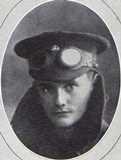
John Williams, Sergeant, 290047, Royal Welsh Fusiliers. John was the son of Edward and Caroline Williams of Hargreaves Court, Ladywell Street, Newtown. He enlisted at Newtown into the 7th Battalion, Royal Welsh Fusiliers, but never proceeded overseas, instead he was medically downgraded and transferred to the Labour Corps, with his service number changing to 481938. Little else is known of his service, but he died at home at Newtown of disease on 17 November 1918. The 26-year-old was buried in St. David’s Cemetery, Newtown.
John Edward Williams, Private, 820, Royal Welsh Fusiliers. John was the son of John and Rebecca Williams, of Newtown. He worked as a Drapers Warehouseman after leaving school and in 1911 married Elizabeth Evans. The couple resided at Evans Court, Ladywell Street, Newtown, where their two children were born. John had enlisted into the 7th Battalion, Royal Welsh Fusiliers several years prior to the war. The battalion was a Territorial unit, which mobilised for war at Newtown in August 1914, as part of North Wales Brigade, Welsh Division and moved to Conway until the end of the month, before moving to Northampton. In December the Division moved to Cambridge and then in May 1915 to Bedford, where the Division was numbered and the formation became 158 Brigade, 53rd (Welsh) Division. On 19 July 1915 the entire Division sailed from Devonport for Imbros and on 9 August 1915 landed at Suvla Bay. The infantry moved off the beaches across the Salt Lake, under shellfire, into the scrub covered Chocolate Hill, but due to a lack of maps and no knowledge of the terrain, many of the units became disorientated, and the situation became chaotic. John was killed in action on the following day, 10 August 1915. The 29-year-old has no known grave and is commemorated on the Helles Memorial, Gallipoli.
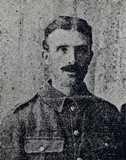
Richard Ernest Williams, Private, 1161, Royal Welsh Fusiliers. Richard was the son of Arthur Richard Williams and Sarah Williams, of 34, Sheaf Street, Newtown. He had enlisted into the 7th Battalion, Royal Welsh Fusiliers several years prior to the war. The battalion was a Territorial unit, which mobilised for war at Newtown in August 1914, as part of North Wales Brigade, Welsh Division and moved to Conway until the end of the month, before moving to Northampton. In December the Division moved to Cambridge and then in May 1915 to Bedford, where the Division was numbered and the formation became 158 Brigade, 53rd (Welsh) Division. On 19 July 1915 the entire Division sailed from Devonport for Imbros and on 9 August 1915 landed at Suvla Bay. The infantry moved off the beaches across the Salt Lake, under shellfire, into the scrub covered Chocolate Hill, but due to a lack of maps and no knowledge of the terrain, many of the units became disorientated, and the situation became chaotic. Richard was killed in action on the following day, 10 August 1915. The 23-year-old has no known grave and is commemorated on the Helles Memorial, Gallipoli.
Thomas Williams, Private, 241873, Royal Welsh Fusiliers. Thomas was born at Newtown in 1887 and worked as a labourer prior to the war. He married Sarah Elizabeth Lewis at Newtown Registry Office on 9 October 1909. The couple lived at 2, Oakfield Terrace, Newtown and had a daughter, Rose Eveline, born the following year. Thomas enlisted at Newtown into the 5th Battalion, Royal Welsh Fusiliers on 7 December 1915 and was initially placed on the Army Reserve. He was mobilised on 1 June 1916 and after completing his training embarked for France at Southampton on 23 May 1917, disembarking at Rouen the following day. On 16 June Thomas was posted to the 15th Battalion, Royal Welsh Fusiliers. The battalion was at Ypres, attached to 113 Brigade, 38th (Welsh) Division and was preparing to launch an assault against the Pilckem Ridge, as part of the opening offensive of the Third Battle of Ypres. On 31 July 1917 the Division launched its famous assault on the Pilckem Ridge, capturing Iron Cross and reaching its objective of the Steenbeek, in terrible conditions. Thomas was killed in action here at some time between 31 July and 4 August 1917. The 30-year-old is buried in Dragoon Camp Cemetery, Belgium.
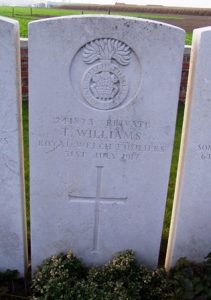
Timothy Davies Williams, Second Lieutenant, Royal Garrison Artillery. Timothy was born at Howden, Co. Durham on 23 July 1883, the son of Reverend Charles Williams and Harriet Williams (nee Davies). His father died when he was young and his mother moved her young family back to her native Carmarthenshire, settling at Bwlchcefnserth, Caio. Timothy had trained as a teacher, gaining his B.A. at Aberystwyth University, and taught for two years at Bridgewater. He married Eleanor Louisa Williams at Caio on 5 August 1909, just before accepting a post as History Master at the County School, Barry and the couple moved to Vesta, Tynewydd Road, Barry. Timothy was commissioned into the Royal Garrison Artillery on 3 August 1917 and was posted to 248 Siege Battery, Royal Garrison Artillery, which had been in France since 16 February 1917. Timothy’s battery was caught up in the desperate fighting which followed the launching of the German offensive of 21 March 1918 and saw heavy fighting as the line was pushed back over the coming days. He was hit by shrapnel whilst in a forward observation post on 5 April 1918 and was evacuated to the 37th Field Ambulance where he died of his wounds that same day. The 34-year-old is buried at Varennes Military Cemetery, France. His sister, Annie Borlace Williams, had married Reverend E. Jones-Williams, of Newtown in 1911.
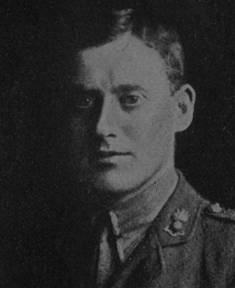
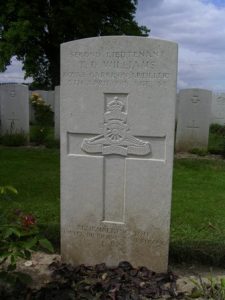
William Sydney Williams, Private, 9666, Royal Welsh Fusiliers. William was the son of Samuel and Sarah Jane Williams, of 7, Frolic Street, Newtown. He worked as a clerk in a timber yard prior to the war. William enlisted at Newtown into the 4th (Reserve) Battalion, Royal Welsh Fusiliers on 8 December 1915 and was placed on the Army Reserve. He was mobilised at Wrexham on 25 March 1916, before being posted to Kinmel Park to join the 12th Battalion, Royal Welsh Fusiliers. William was found to have been unfit for training for a front-line unit, so on 1 May was transferred to the 2/4th Battalion, Royal Welsh Fusiliers. He was eventually discharged from the army as medically unfit on 11 September 1916 and returned home to Newtown. William’s health continued to wane over the coming months, and he died of pleurisy and pneumonia at Newtown on 1 November 1917, aged 34. He was buried in Newtown and Llanllwchaiarn Cemetery.
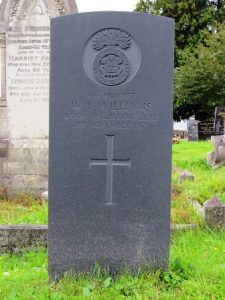
Frederick Alfred Williamson, MM, Private, 1537, Princess Patricia’s Canadian Light Infantry. Frederick was born at Salford on 20 January 1890, the son of Frederick Williamson and Frances Margaret Williamson (nee Forth). His father died when he was young and his mother moved with Frederick to 2, Wesley Street, Newtown by 1901. His mother married Arthur Garnet King of Newtown in 1903 and Frederick was raised as his son. Frederick found work as a Clerk at Newtown and had served for three years with the 7th Battalion, Royal Welsh Fusiliers after leaving school, but by 1912 the family had emigrated to Canada and settled at Calgary, Alberta, where Frederick found work as a bookkeeper. He enlisted into the Canadian Expeditionary Force at Ottawa on 24 August 1914 and was posted to the newly formed Princess Patricia’s Canadian Light Infantry (Eastern Ontario Regiment). The regiment left Ottawa on 28 August and embarked aboard the SS Megantic in Montreal, Quebec, however, because of enemy action in the Atlantic Ocean, the regiment had to disembark at Lévis, Quebec, where the men continued their training. On 27 September the regiment finally sailed from Quebec City aboard the HMT Royal George with the rest of the first Canadian contingent. Upon arriving in Liverpool, the Canadians entrained for Southern England and moved to Salisbury Plain. On 20 December the regiment embarked at Southampton for France and moved to positions in the Ypres Salient, near Dickebusch by 6 January 1915. The Canadians showed their mettle following the launching of the first ever gas attack of the war, at Gravenstafel, on 22 April 1915, when the French Colonial forces holding the line fled in terror and the Canadians moved into the ghastly devastation to plug the gap in the line. On 8 May the Canadians were put to the test again when the Germans attacked Bellewaarde Ridge, during the Battle of Frezenberg, but suffered terrible casualties. On 2 June 1916 the Canadians came under heavy attack once more when the Germans launched an offensive at Mount Sorrel and Hill 62 and despite an initial German breakthrough, heroically plugged the gap and drove the Germans back. Frederick was awarded the Military Medal for his bravery during the Battle of Mount Sorrel. He was killed in action during a routine spell in the line on 17 July 1916. The 24-year-old is buried in Railway Dugouts Burial Ground (Transport Farm), Belgium.
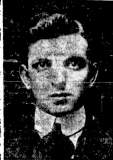
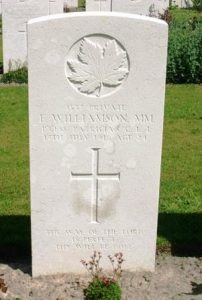
James Lawton Woolley, Private, 290088, Royal Welsh Fusiliers. James was the son of Frederick Woolley and Eliza Woolley (nee Jones), of 18, Bryn Street, Newtown. He worked as a wool sorter for Morgan & Morgan at Newtown prior to the war. James enlisted at Newtown into the 7th Battalion, Royal Welsh Fusiliers on 10 January 1912 and attended the annual TA summer camps over the coming years at Carnarvon, Rhyl, and Aberystwyth. The battalion was a Territorial unit, which mobilised for war at Newtown in August 1914, as part of North Wales Brigade, Welsh Division and moved to Conway until the end of the month, before moving to Northampton. In December the Division moved to Cambridge and then in May 1915 to Bedford, where the Division was numbered and the formation became 158 Brigade, 53rd (Welsh) Division. On 19 July 1915 the entire Division sailed from Devonport for Imbros and on 9 August 1915 landed at Suvla Bay. The infantry moved off the beaches across the Salt Lake, under shellfire, into the scrub covered Chocolate Hill, but due to a lack of maps and no knowledge of the terrain, many of the units became disorientated, and the situation became chaotic. After the fighting died down, the winter rolled in, and the men first had to endure torrential downpours, which flooded the trenches, before the snow hit, and many men began falling ill in the terrible conditions. James suffered a severe case of frostbite towards the end of the Gallipoli campaign and was invalided back to Britain aboard the Hospital Ship D’Italia on 31 December 1915. After he had recovered, he was posted to the 3/7th Battalion, Royal Welsh Fusiliers at Oswestry, then on 26 March 1917 a now fully fit James embarked at Southampton for Rouen, before being posted to the 2nd Battalion, Royal Welsh Fusiliers. The battalion was attached to 19 Brigade, 33rd Division and was holding a sector of the line at Suzanne, between Bapaume and Péronne. The Division was soon transferred to the Arras sector, and reached Henin by 13 April, before the taking over a section of front line facing the Hindenburg Line. The infantry battalions of the division then began the usual routines of rotating between the front-line, support and reserve trenches and the 2nd RWF took over a position known as Tunnel Trench. On 23 April the 2nd RWF took part in a costly assault on the Hindenburg Line, suffering heavy casualties. The battered battalion then moved to a rest camp at Basseux to rebuild, and by 15 May moved back into the line in the Croisilles Sector. The Division then carried out several assaults against the Hindenburg Line, but could not breach it, suffering heavy losses during this spell in the line. James was killed in action during one such assault against the Hindenburg Line by the 33rd Division on 20 May 1917, when the assaulting troops managed to break the front line but could not reach the German support line. The 21-year-old is buried in Croisilles British Cemetery, France.
William Indoe Worner, Rifleman, S/37283, Rifle Brigade. William was born at Martock, Somerset on 27 December 1879, the son of William Indoe Warner and Emma French Worner (nee Perren). By 1906 he was living at Gwynfa, Bushy Park, Pontypool, where he worked as a shop assistant. William married Matilda Florentia Benbow, of 42, Crescent Street, Newtown, at Pontypool on 31 August 1908. William enlisted into the Army Service Corps at Abertillery in the winter of 1915. He remained on home service for much of his time in uniform but in February 1918 was drafted out to France and transferred to the 2nd Battalion, Rifle Brigade, which was in the Ypres Salient attached to 25 Brigade, 8th Division. William joined the battalion in camp near Poperinghe just before it moved back into the front line at Passchendaele Ridge to begin a routine spell in the trenches on 15 February. The Division held this position over the coming weeks until being relieved on 7 March and moved to Steenvoorde before entraining for the Tilques area. After a short spell there training the Division began moving into a new sector, marching to Arques on 22 March to entrain south. By this time, fighting was raging along a section of the line running south from Croisilles to La Fère, following the launching of the German offensive on 21 March 1918. As a result, the 8th Division moved into a nightmarish situation, moving to Chaulnes on 23 March before taking over positions along the river near Pargny under heavy shellfire as fighting raged in front of them. Just before midnight the Germans hit the Divisions positions and broke through but were swiftly repelled. On the following day the Germans attacked again in greater numbers, under heavy artillery fire, working around the left flank of the Division, which was forced to withdraw. Heavy fighting continued to rage over the coming days, as the British line was pushed back. William was killed in action whilst his battalion was defending the bridgehead at Castel on 31 March 1918. The 33-year-old is buried in Pargny British Cemetery, France.